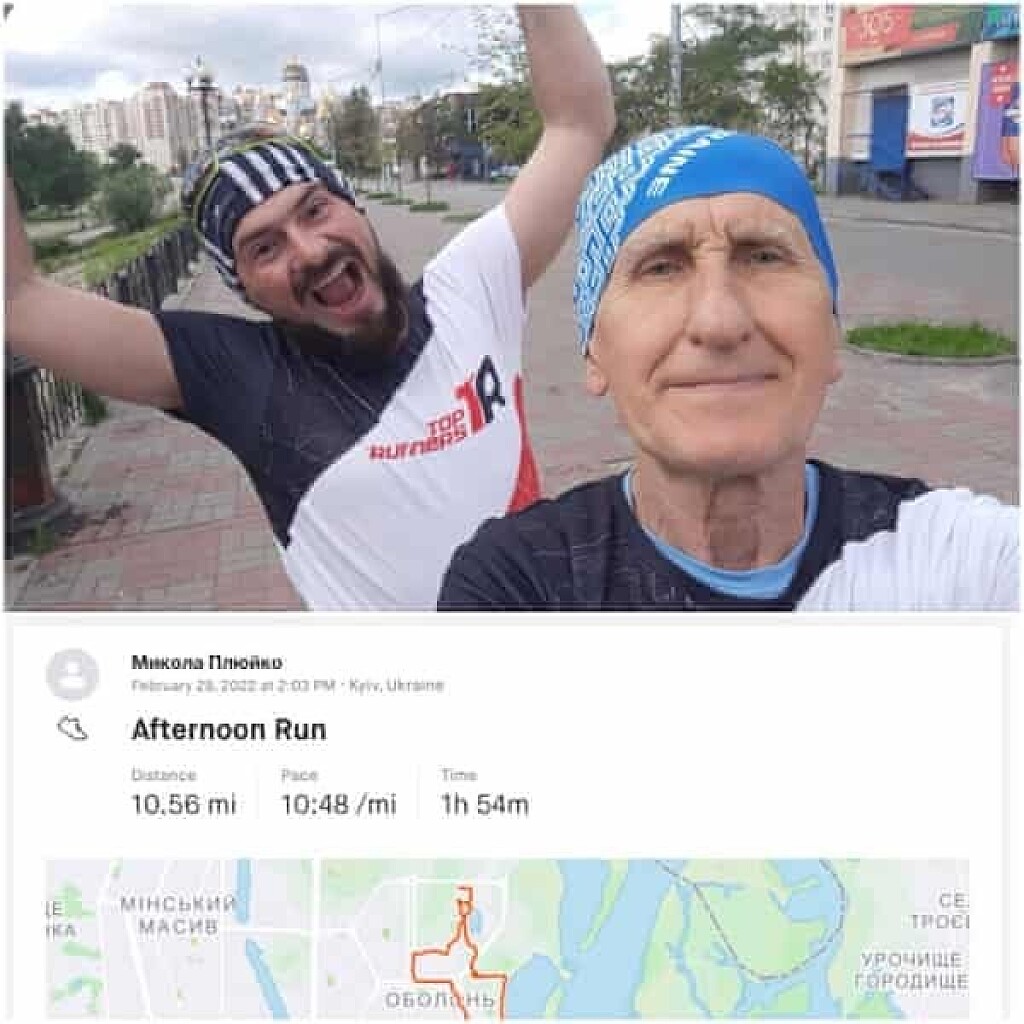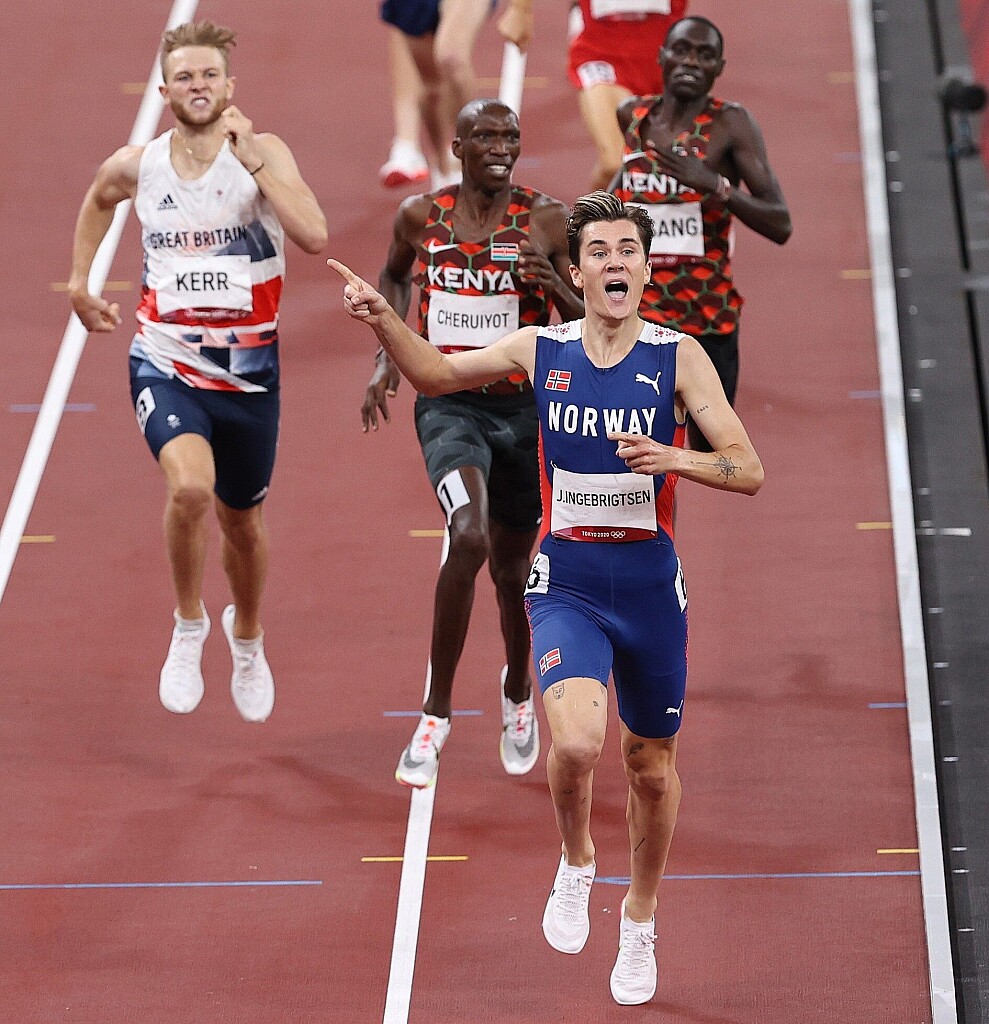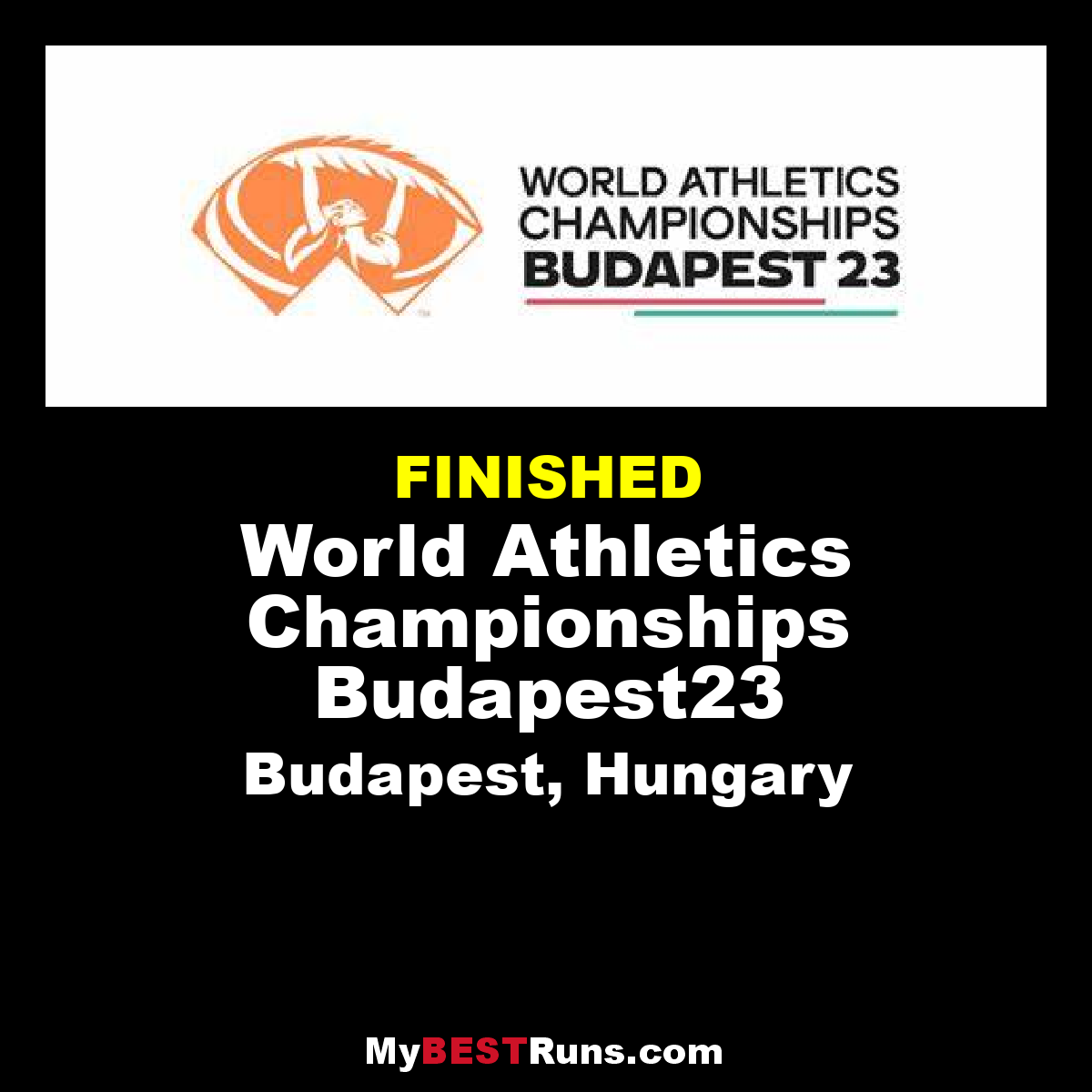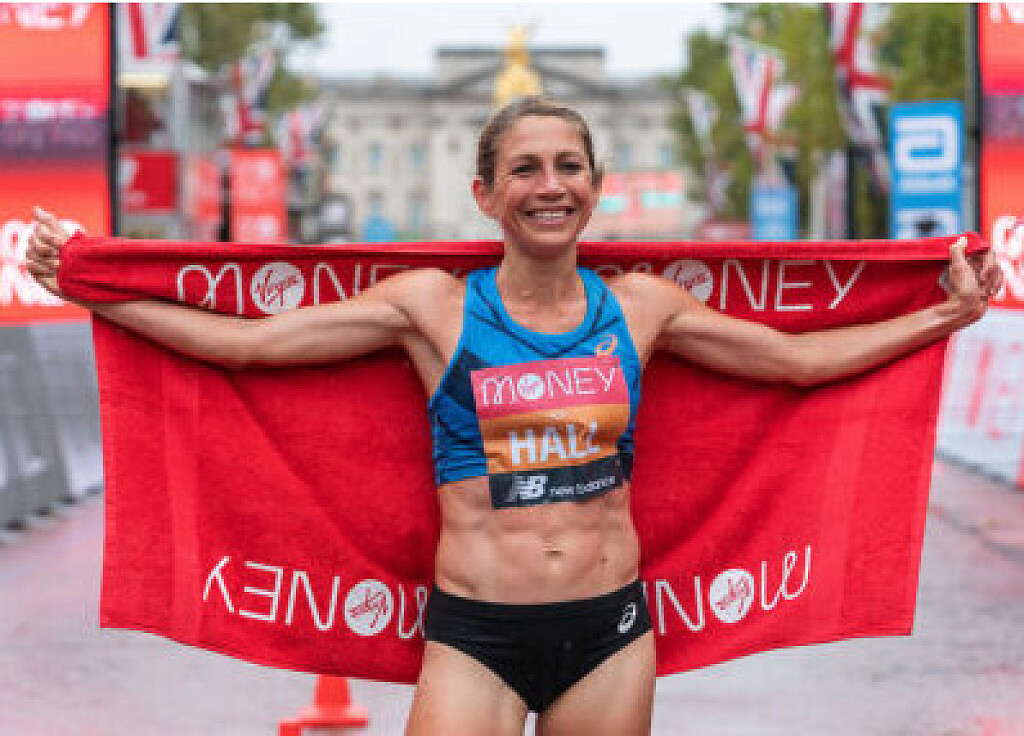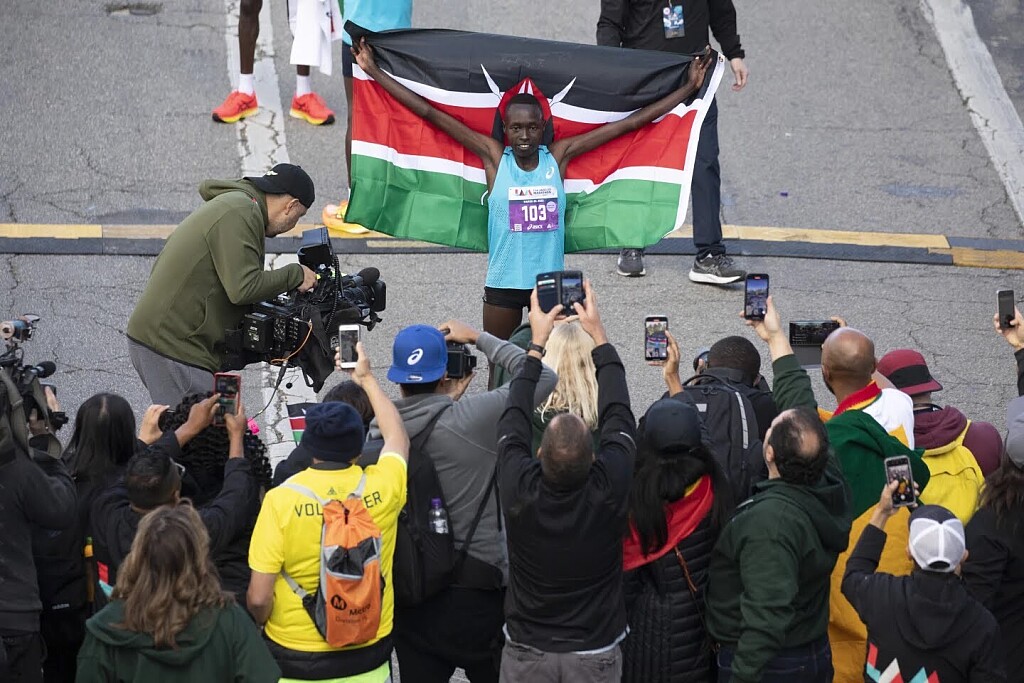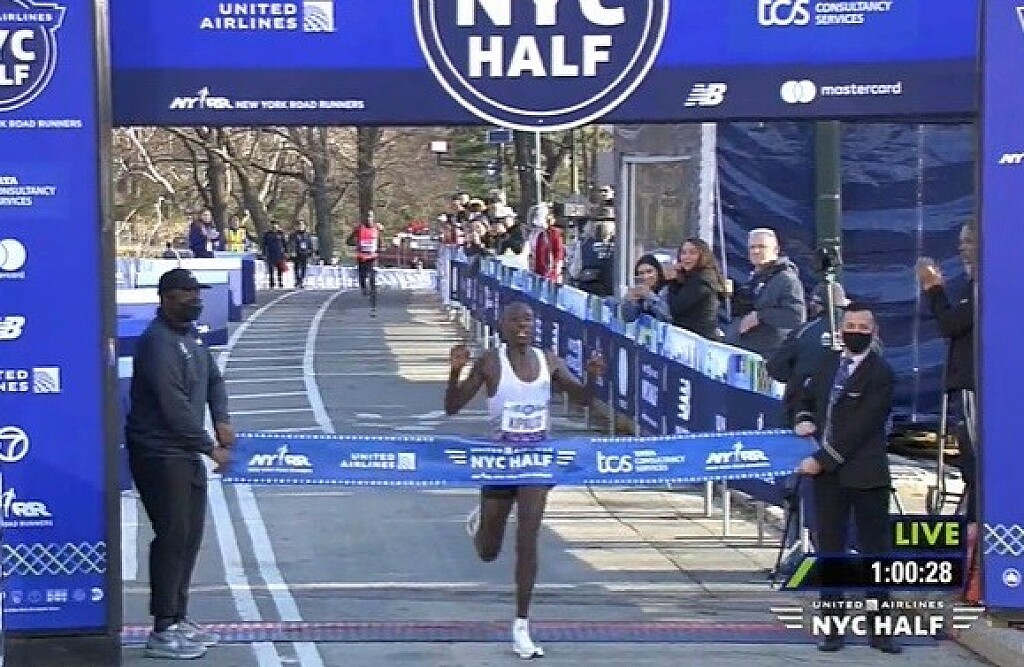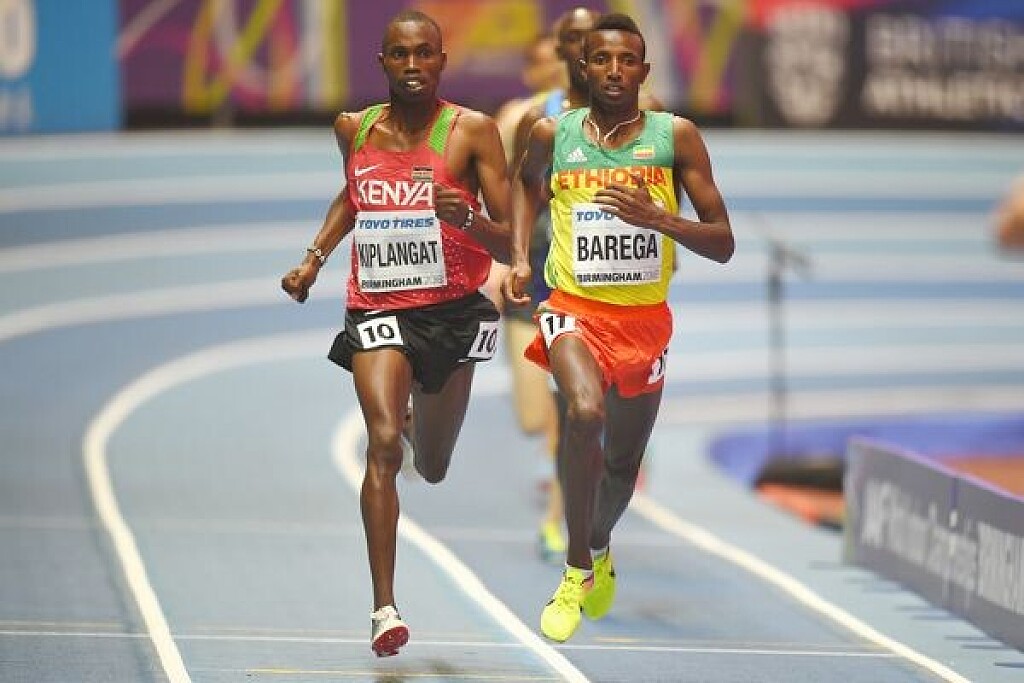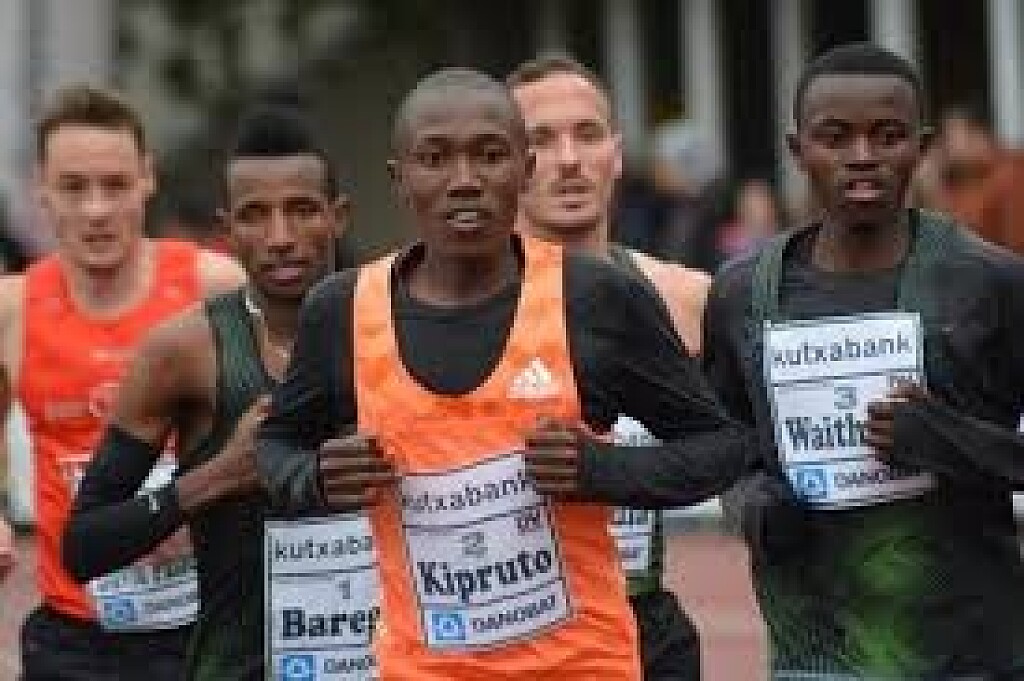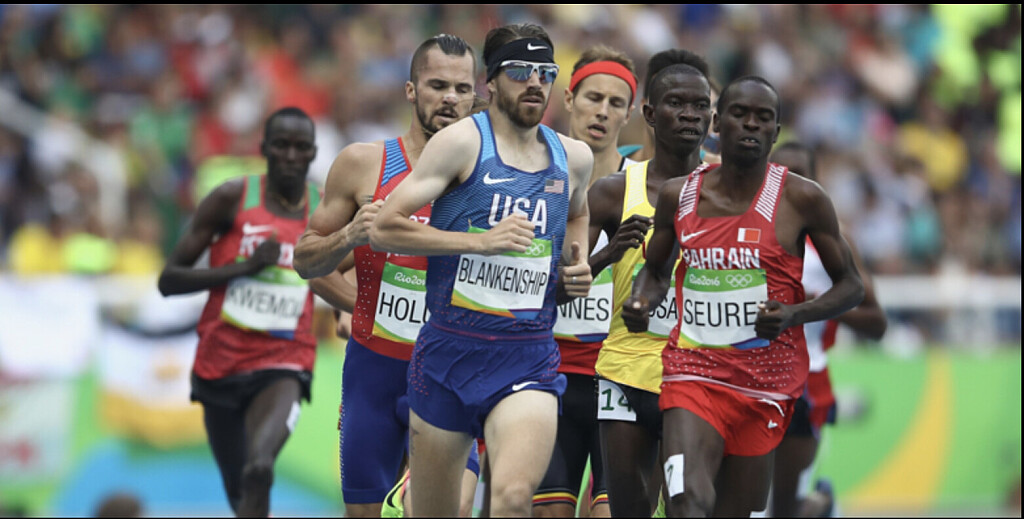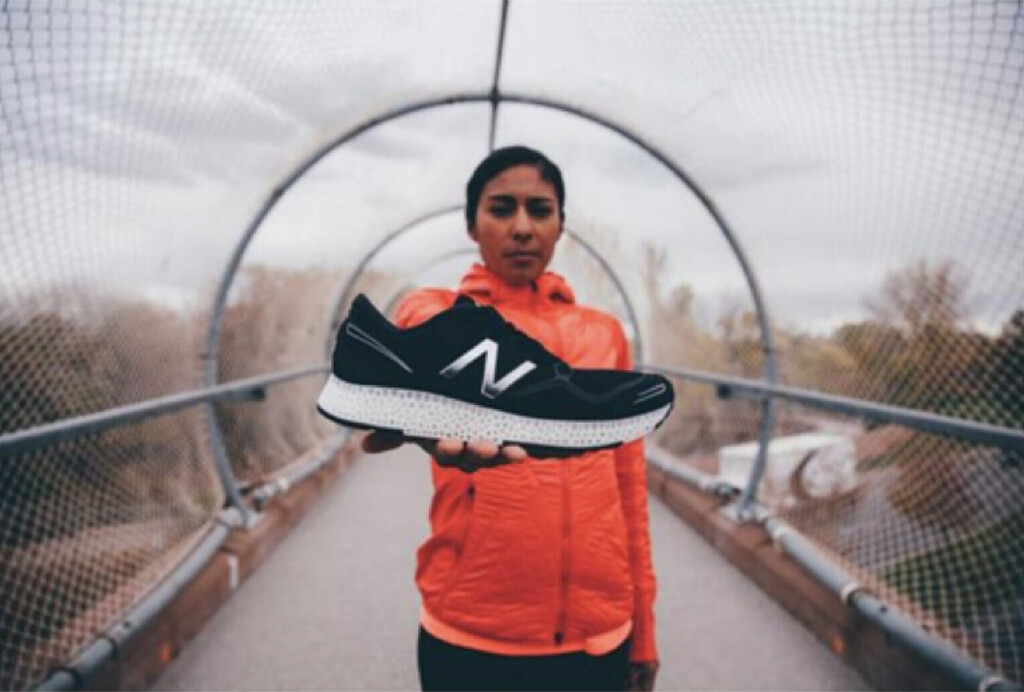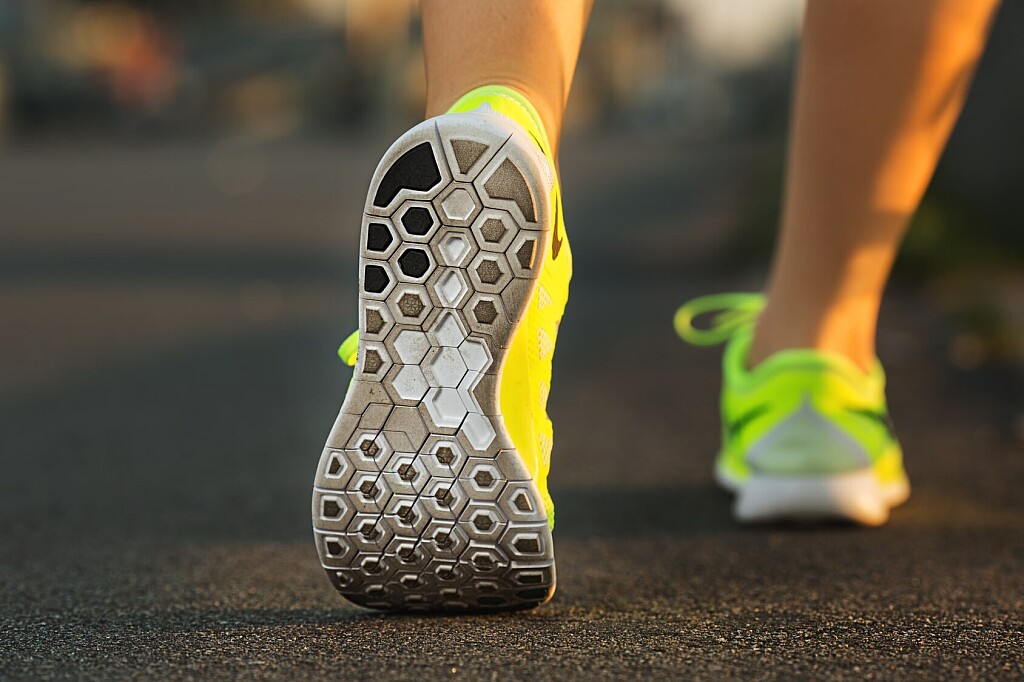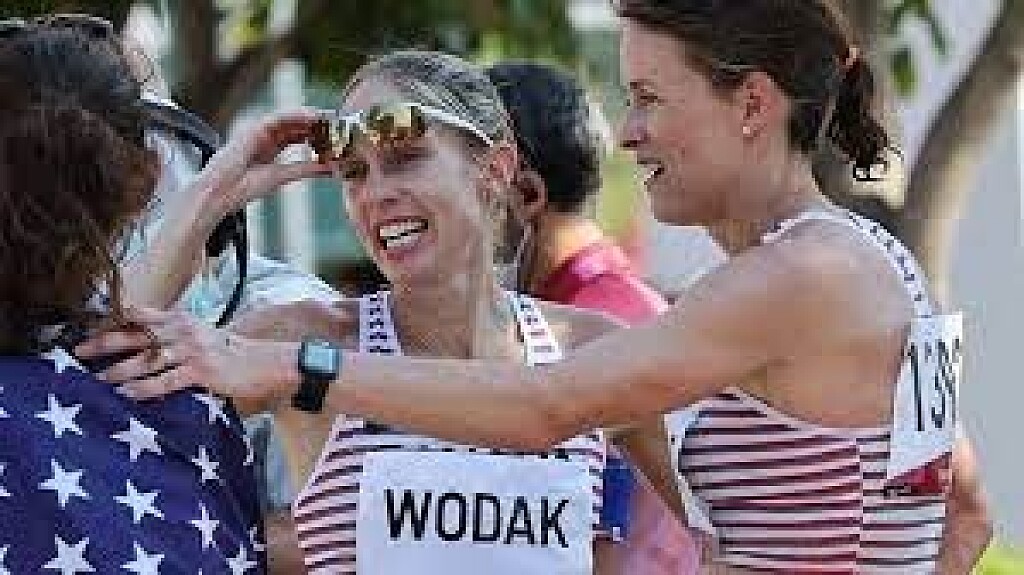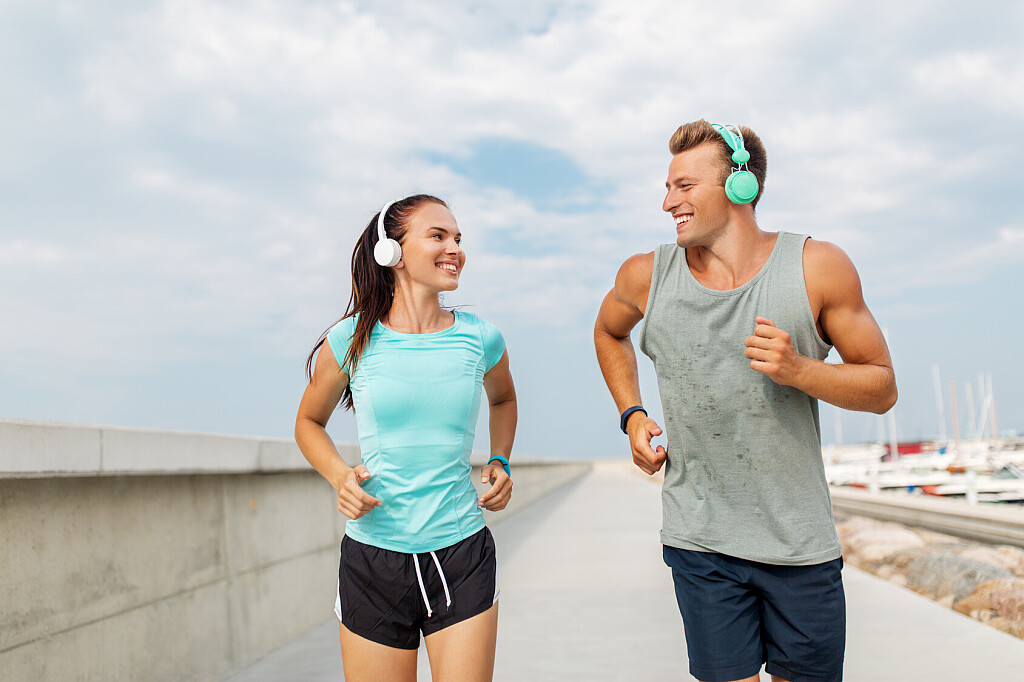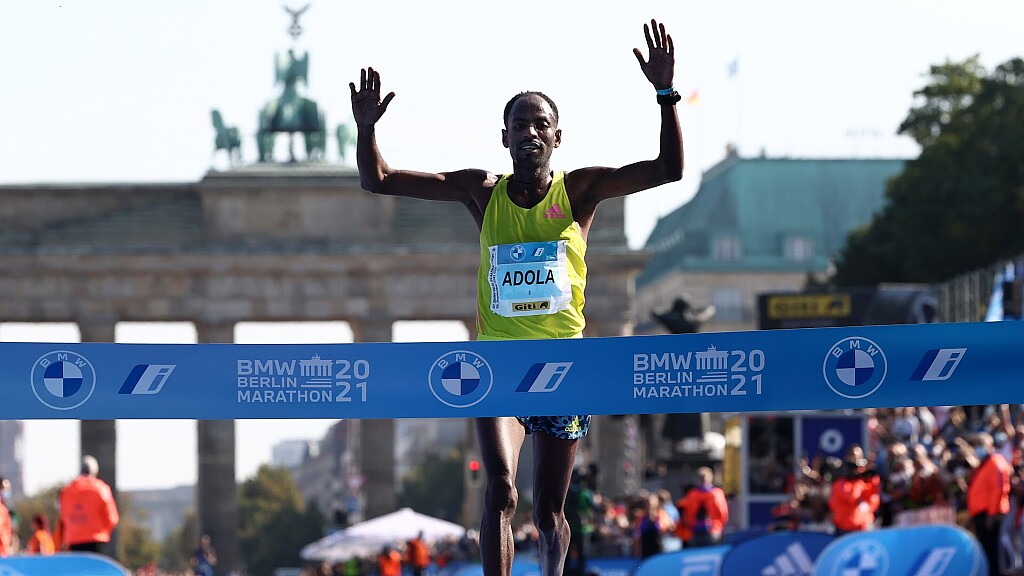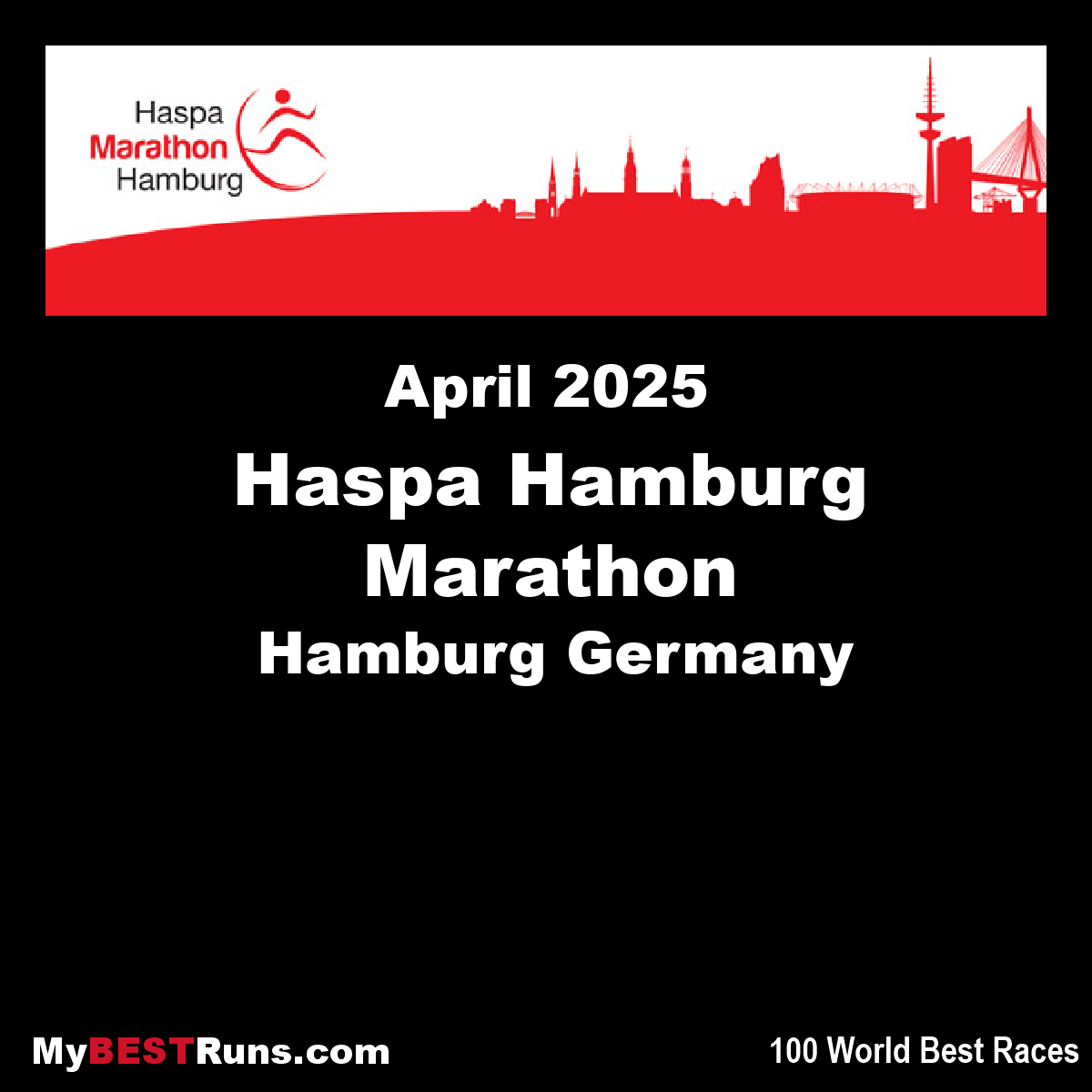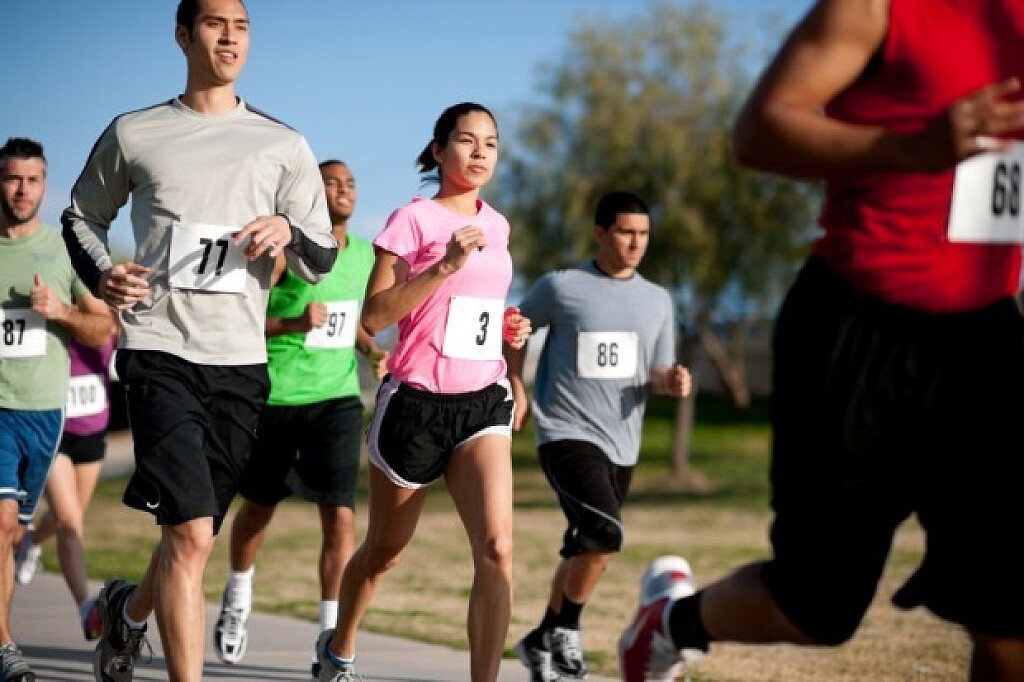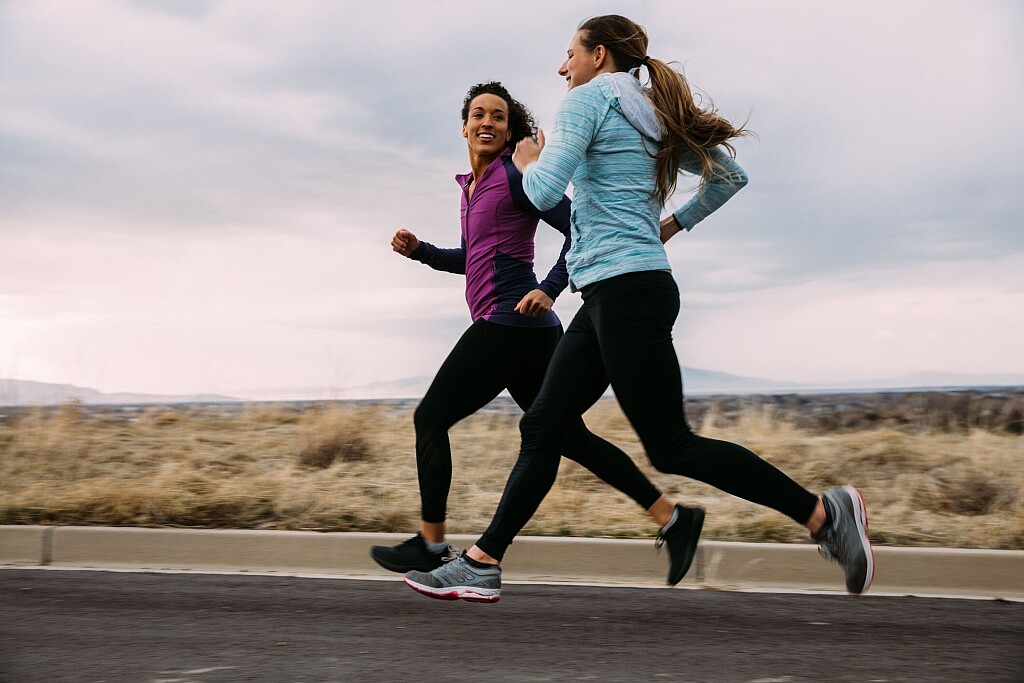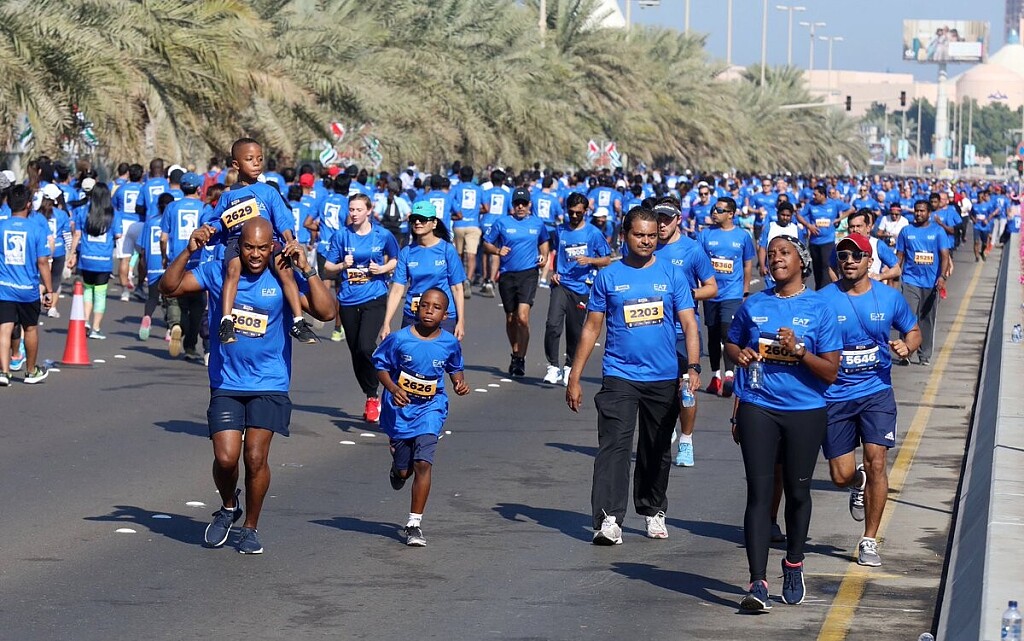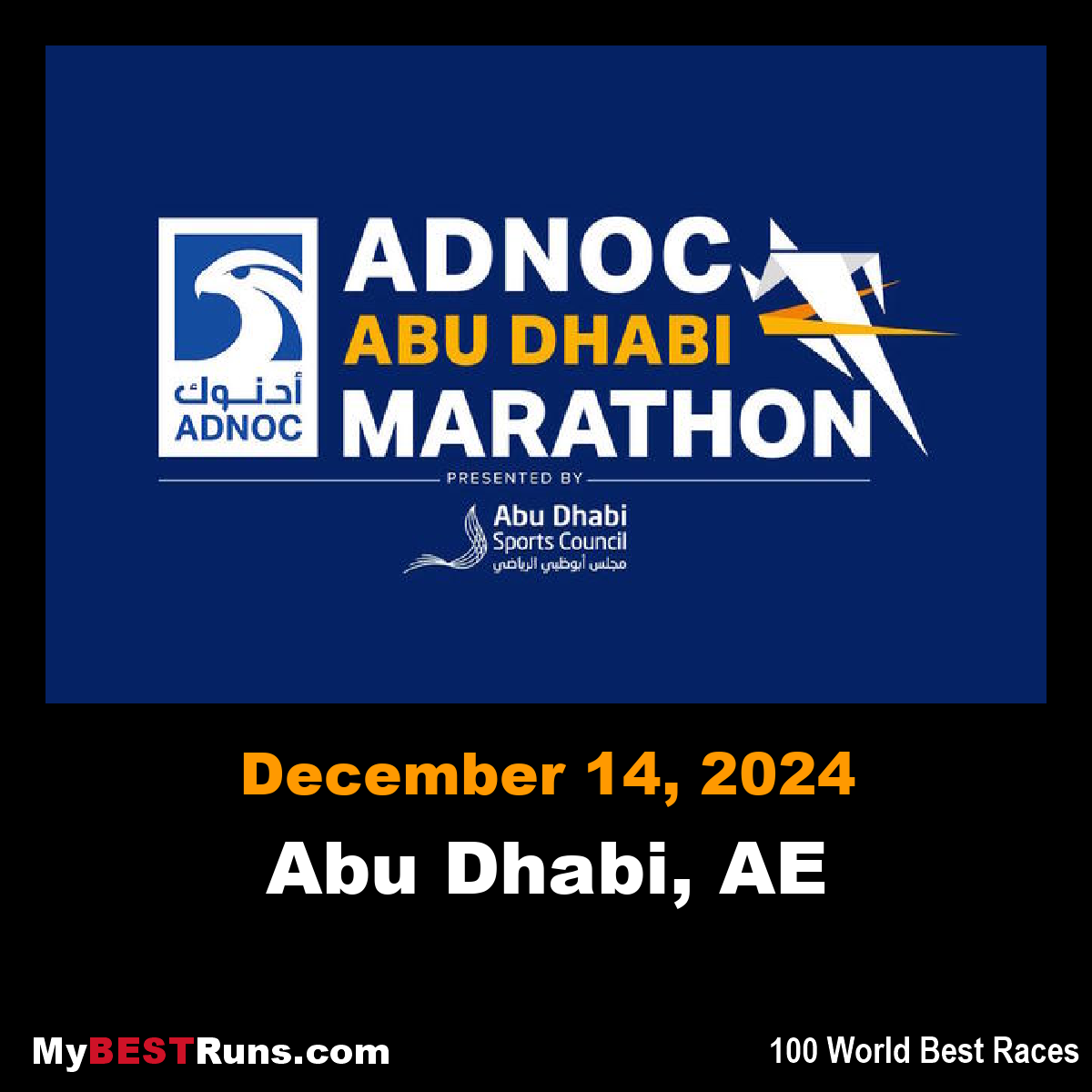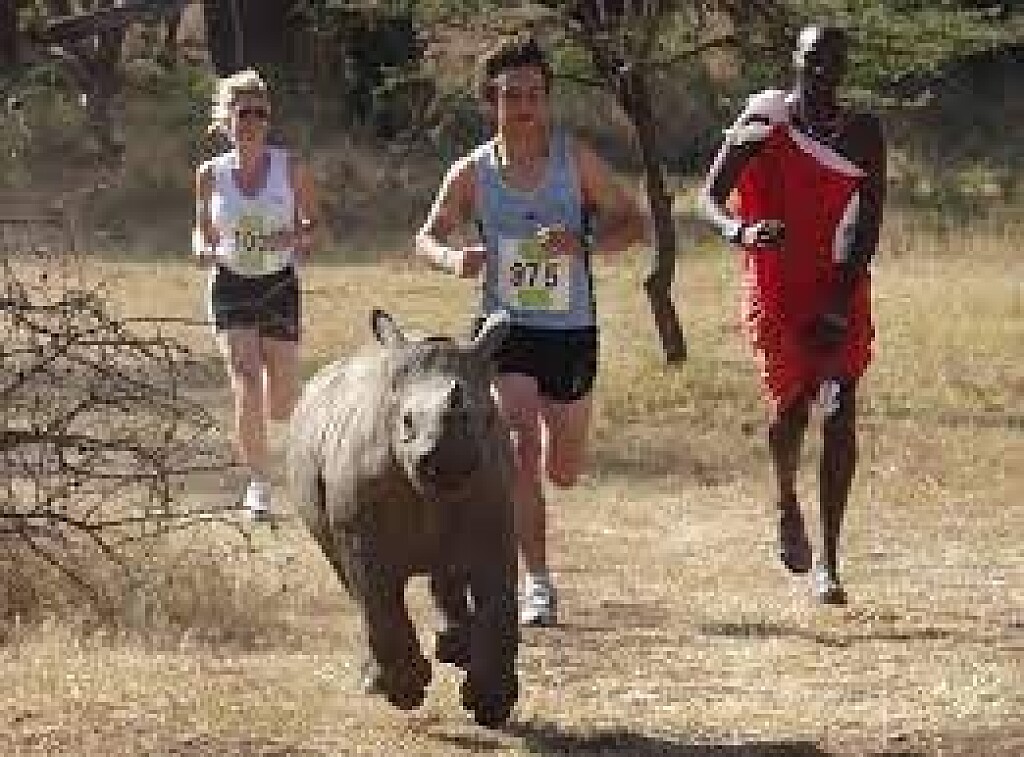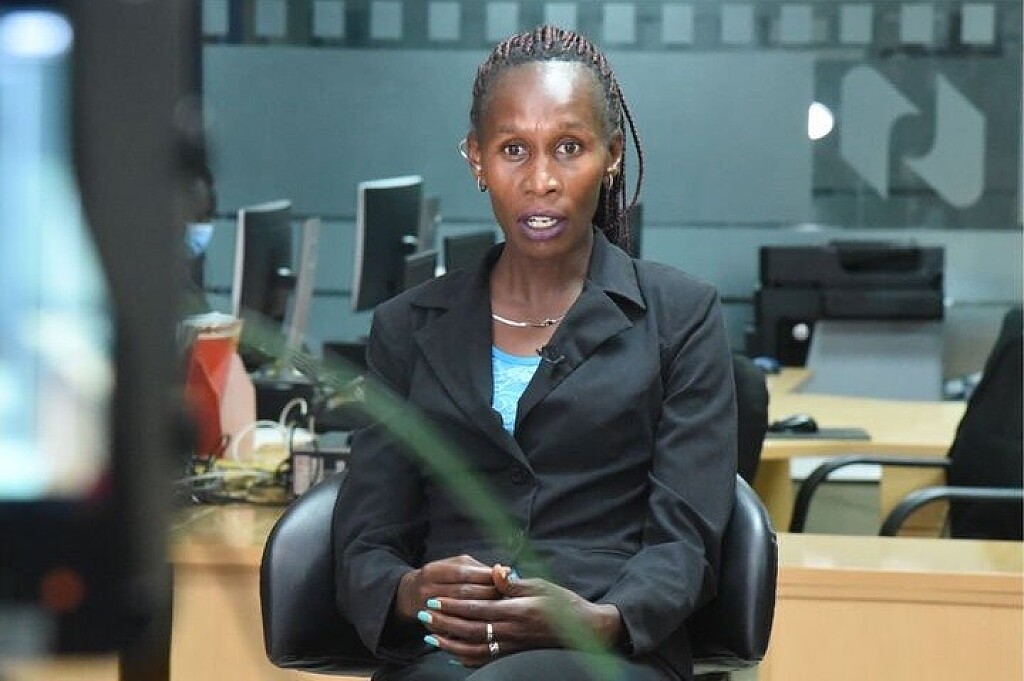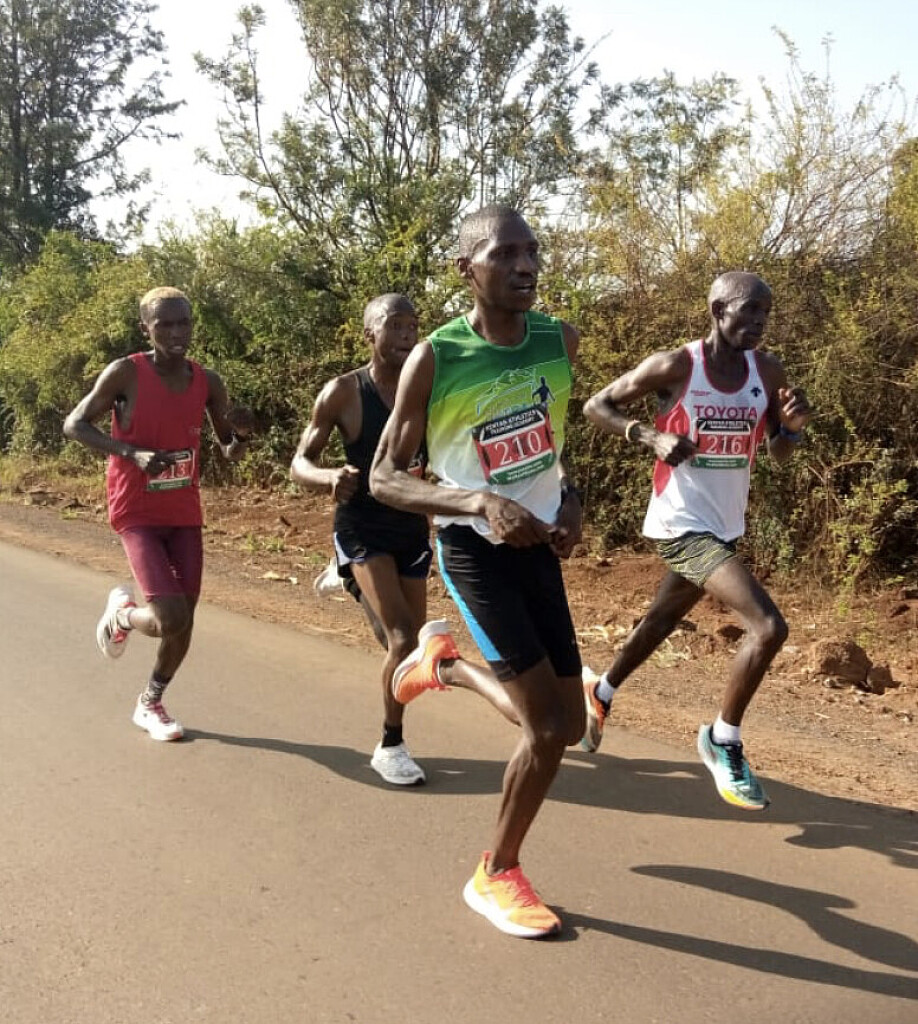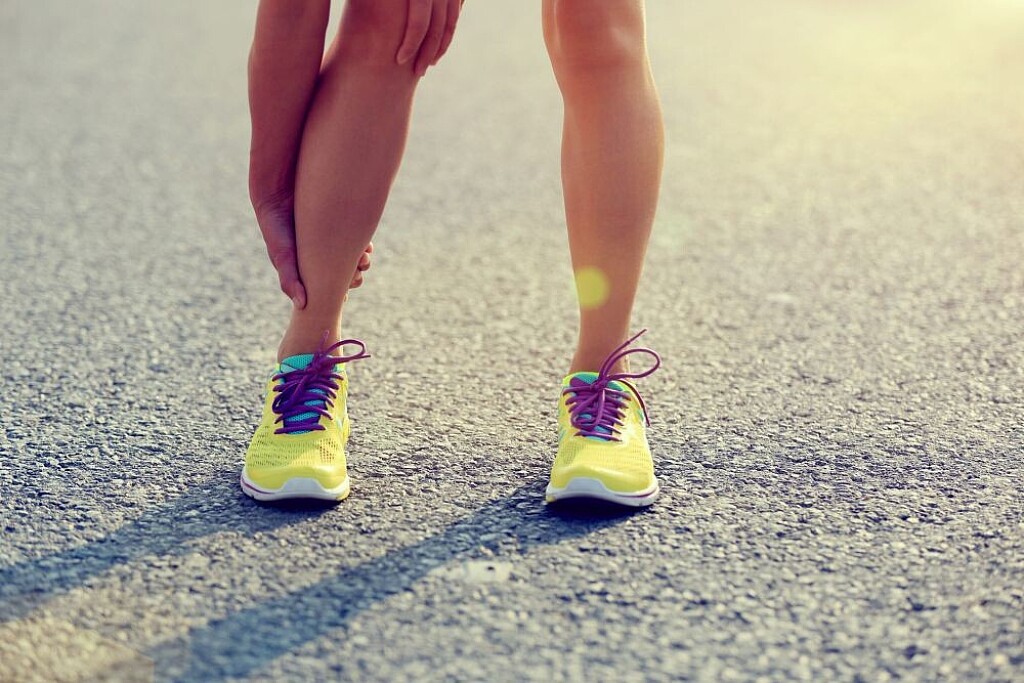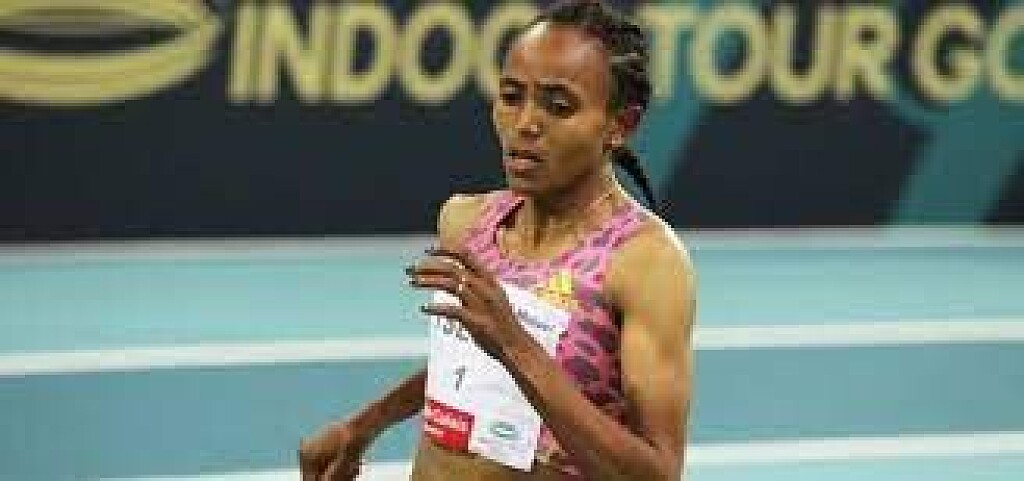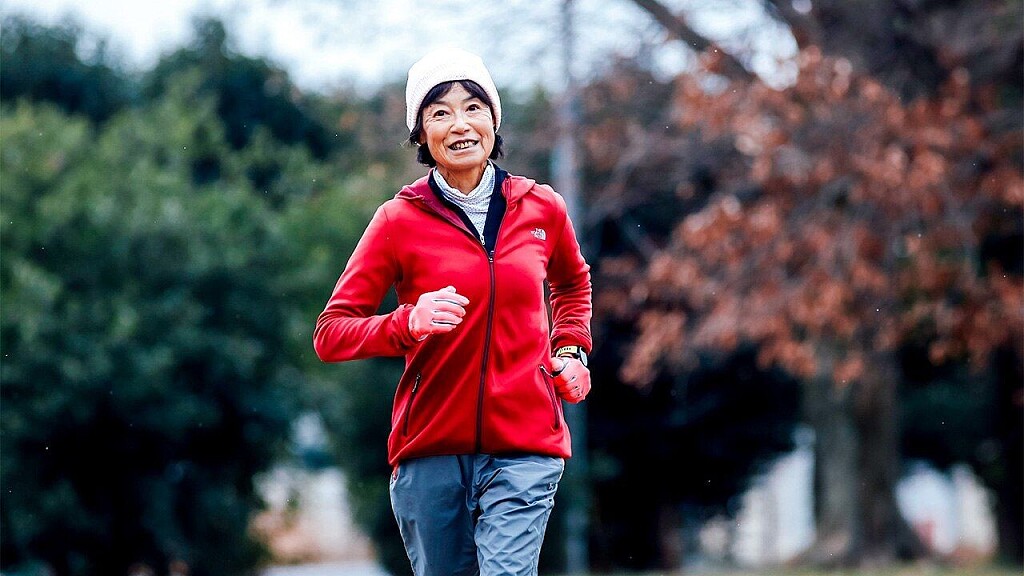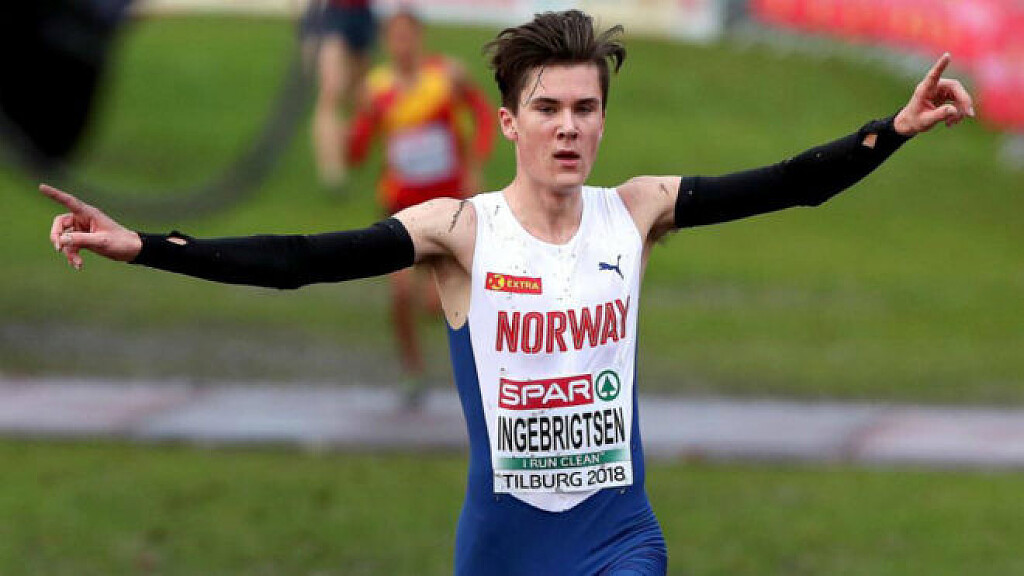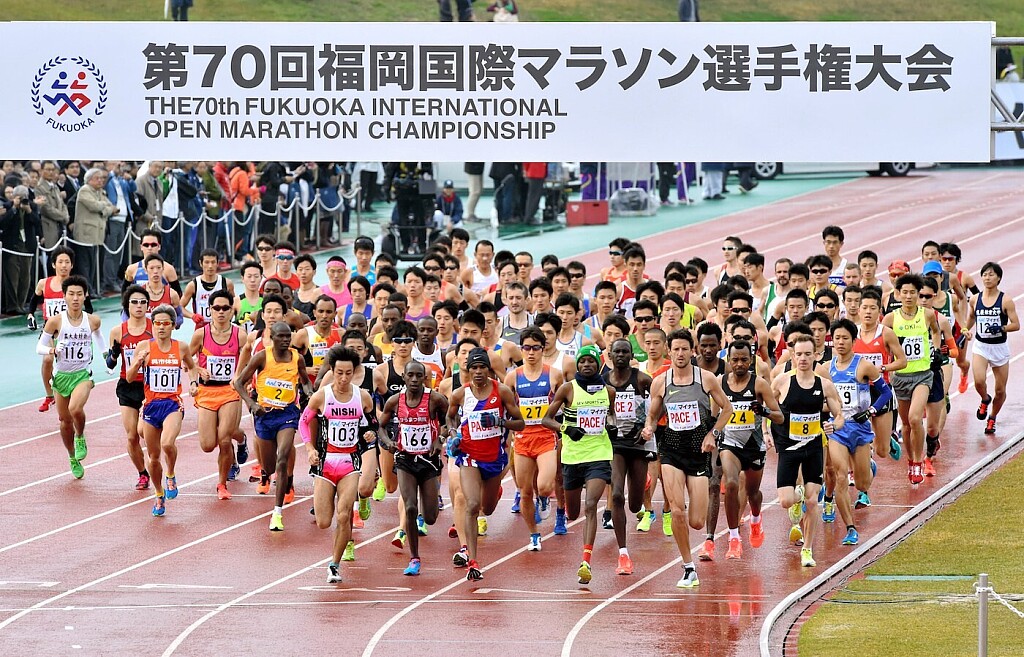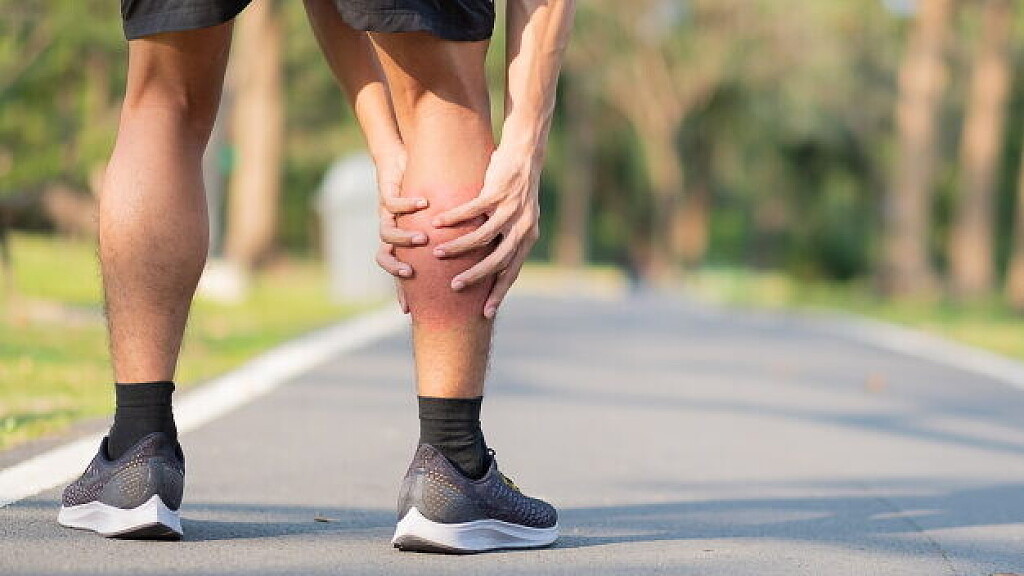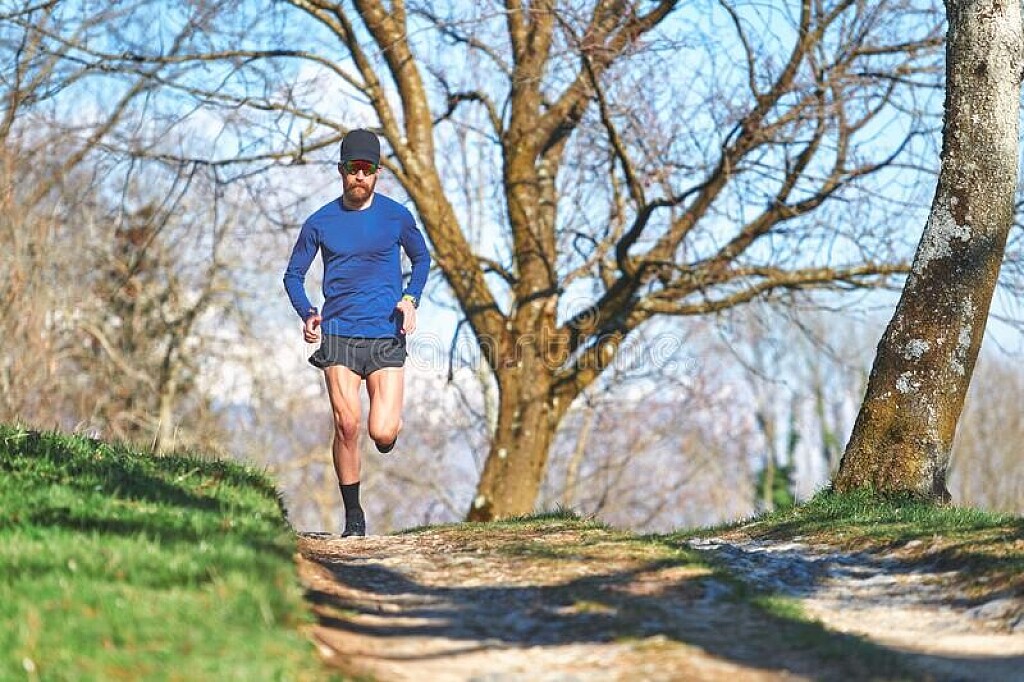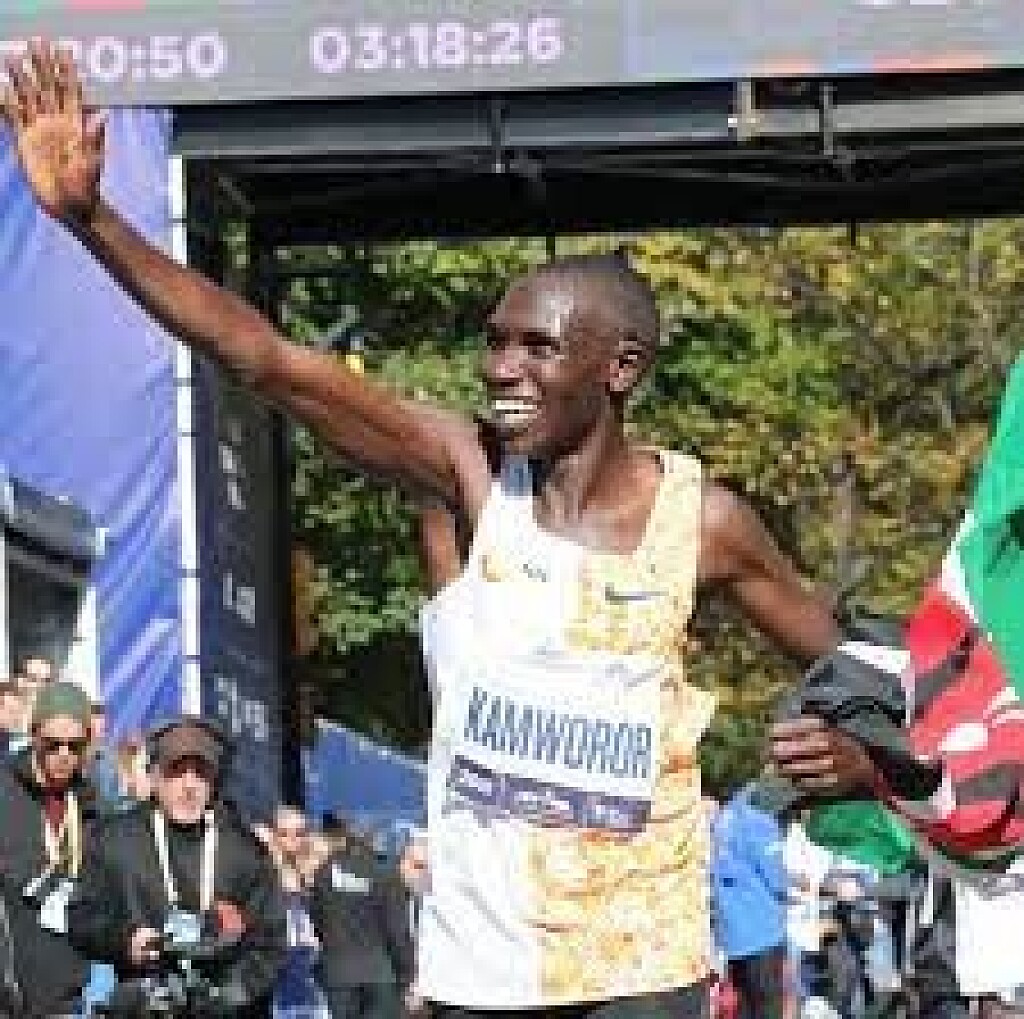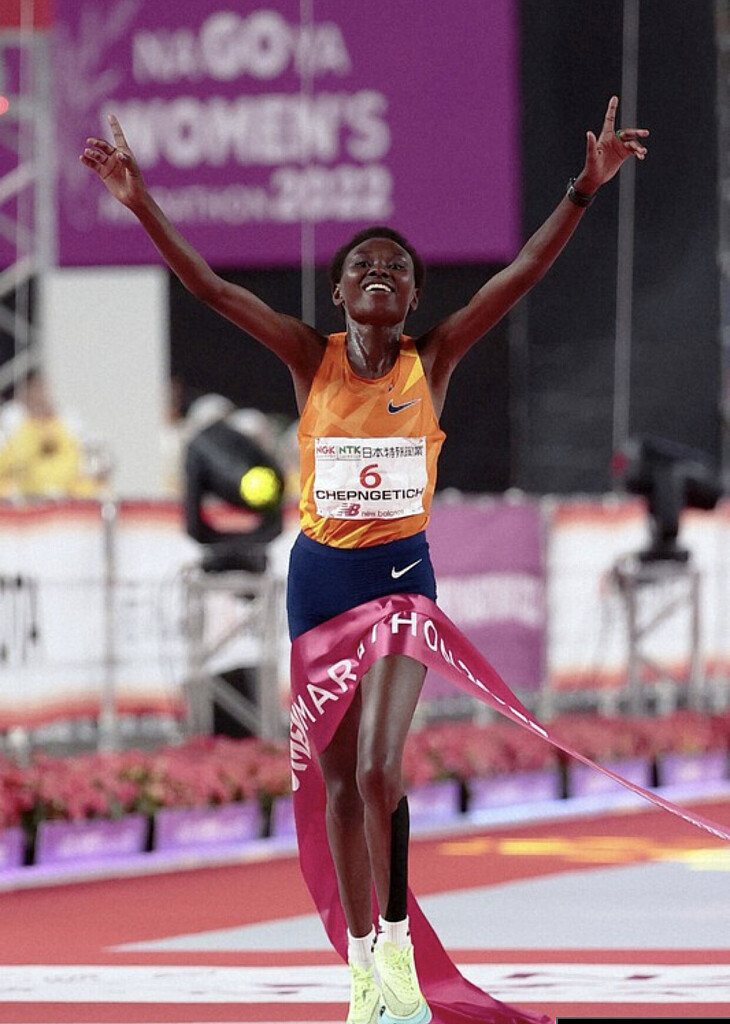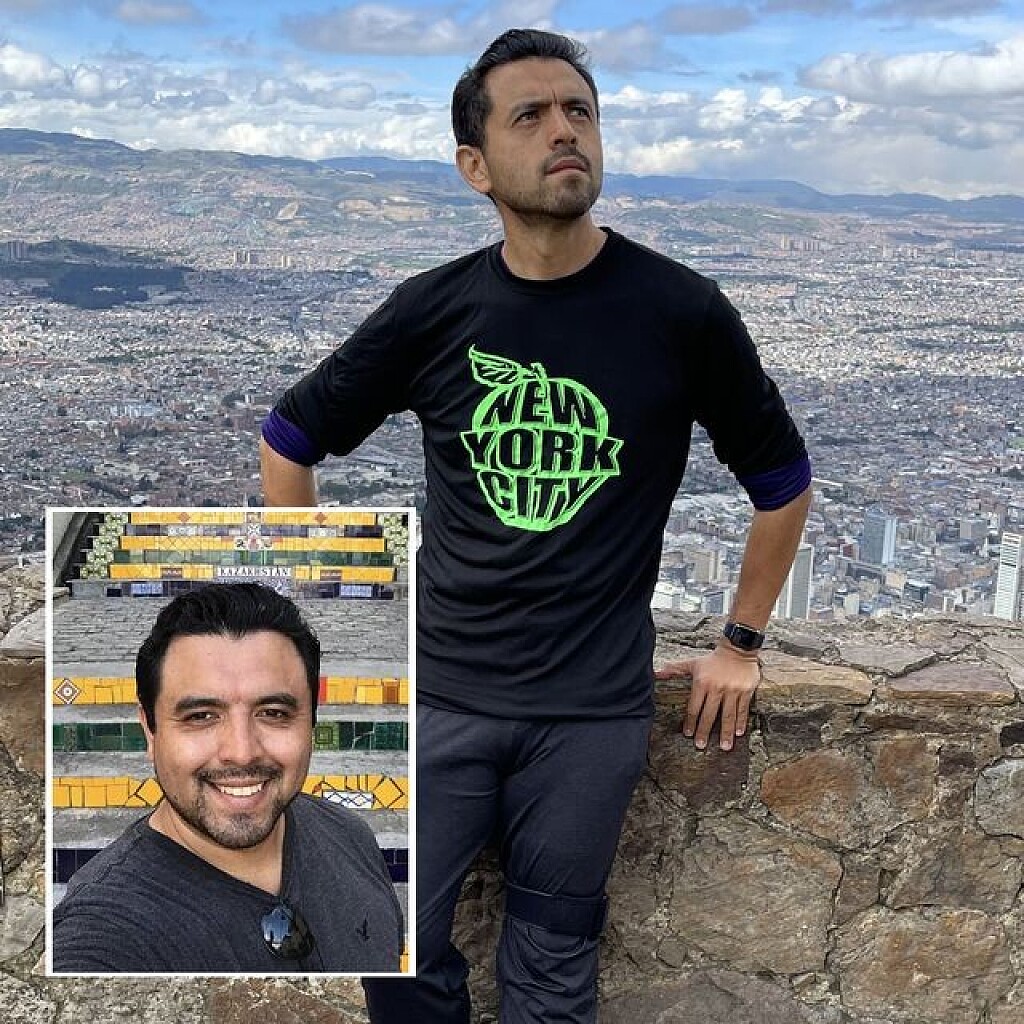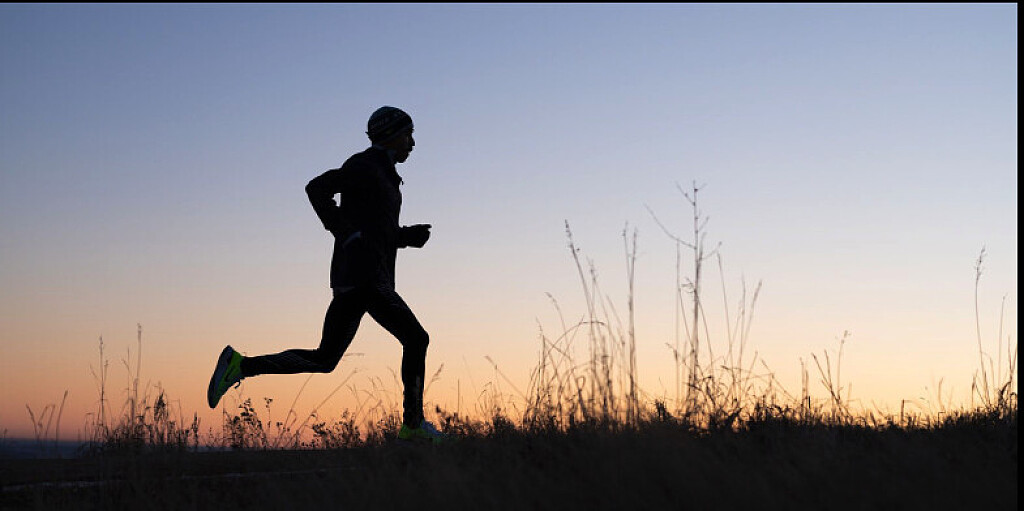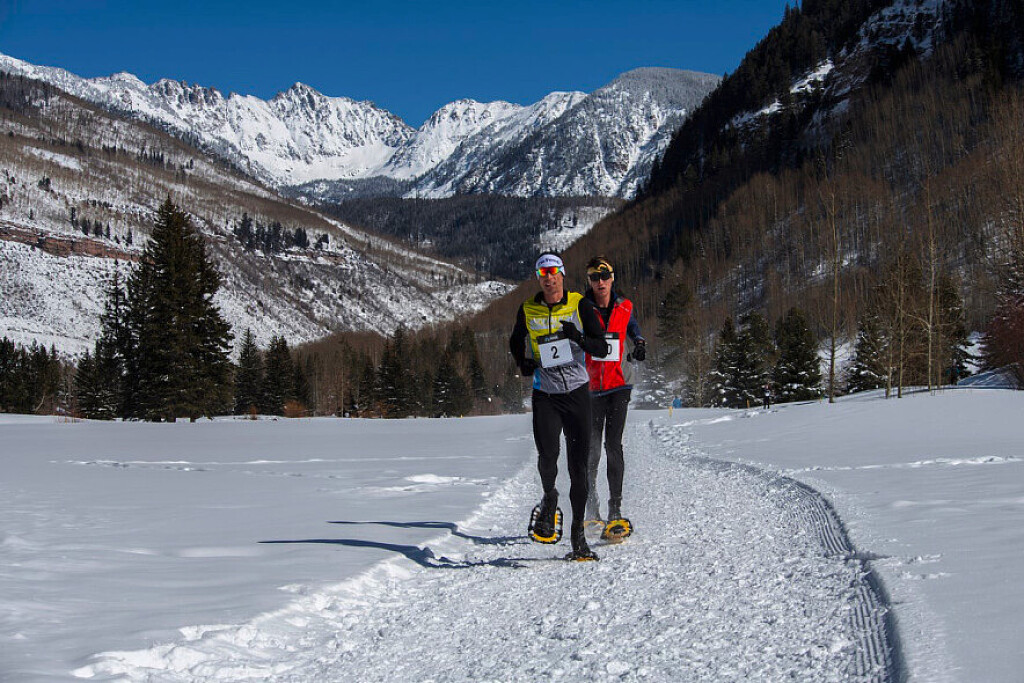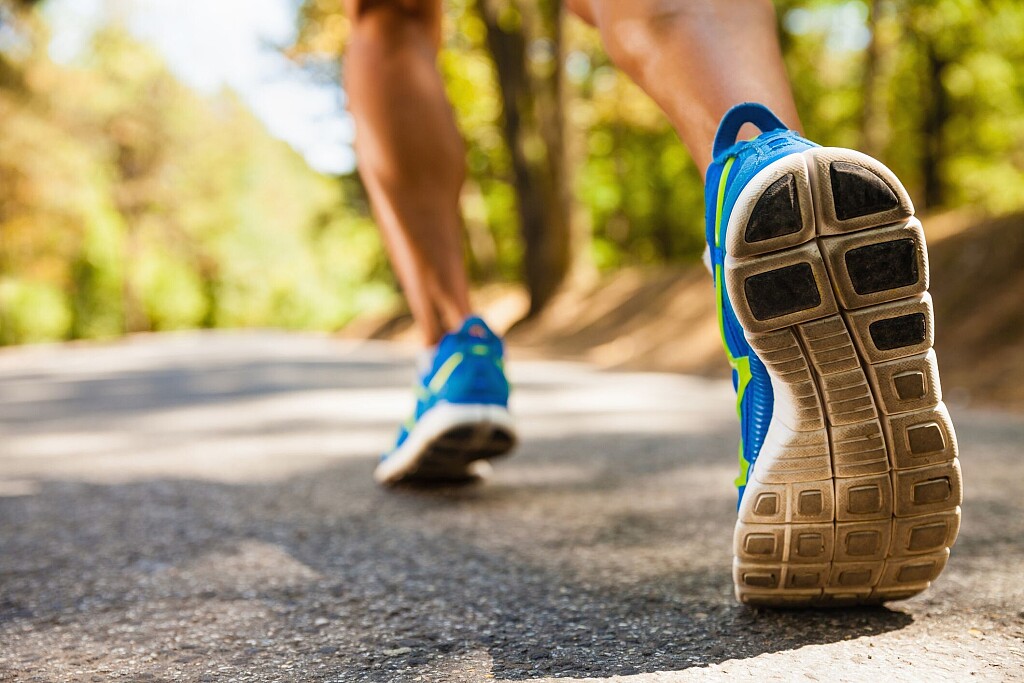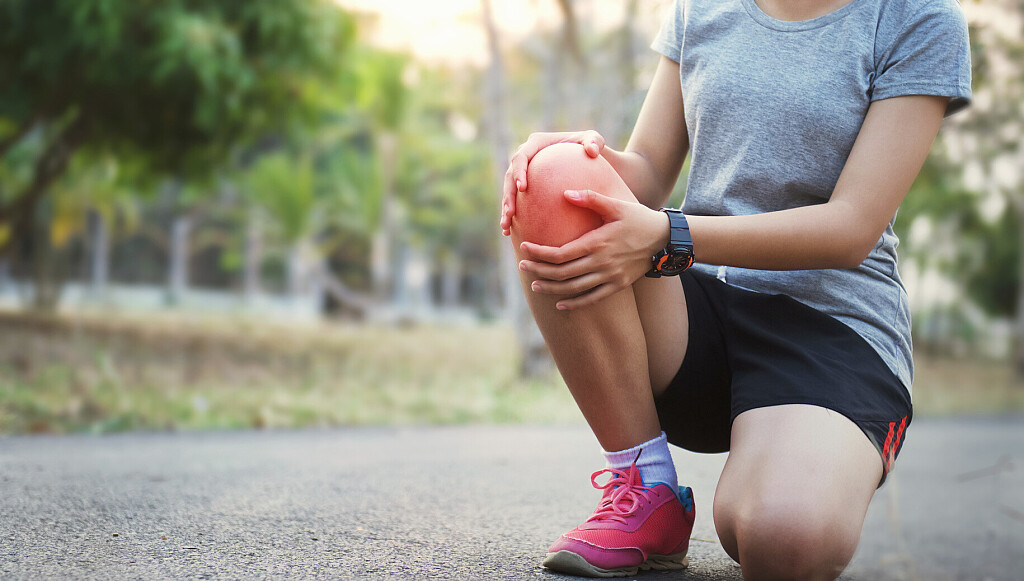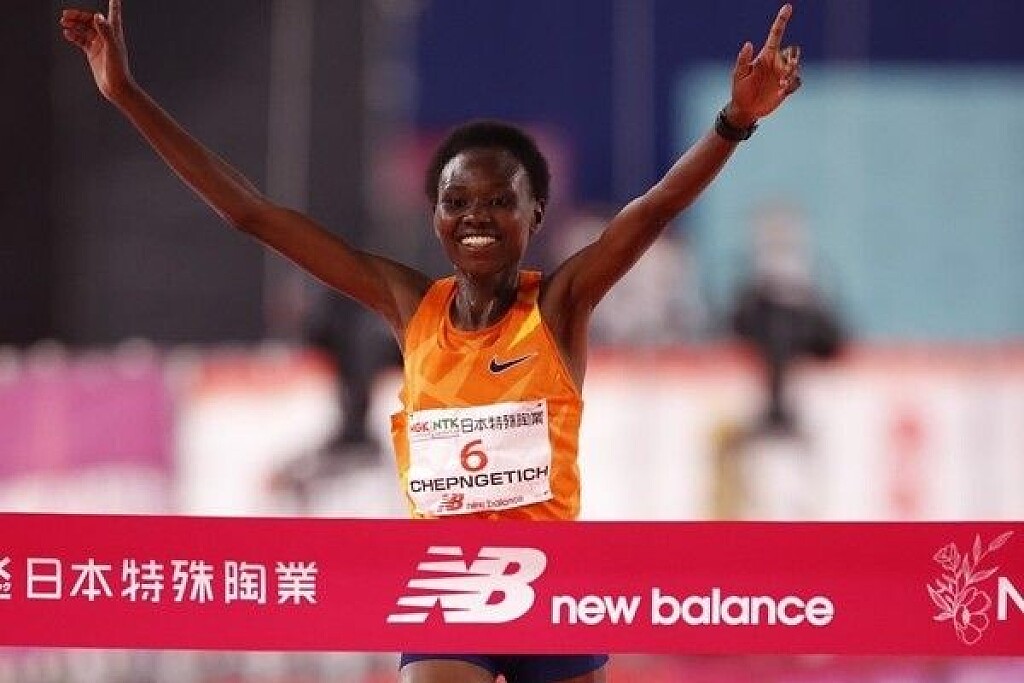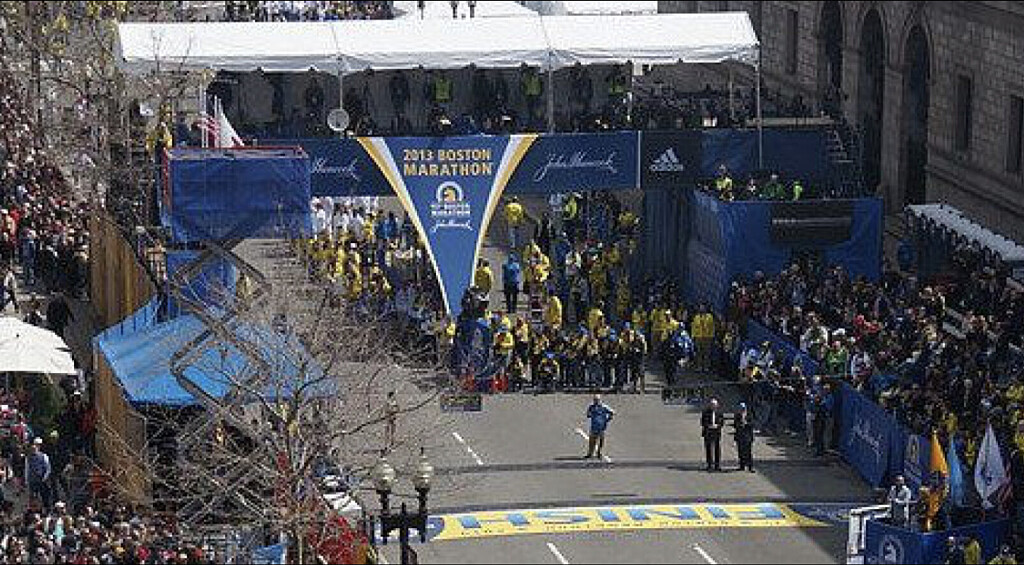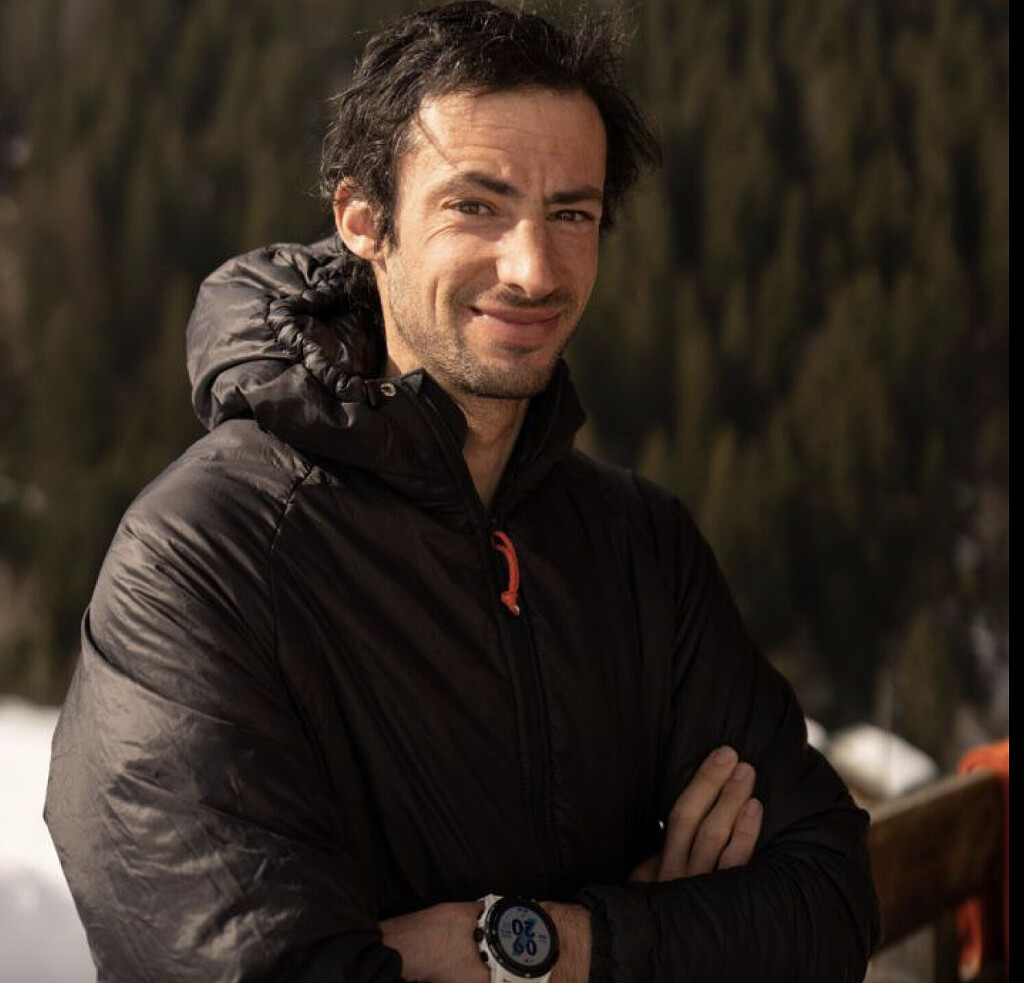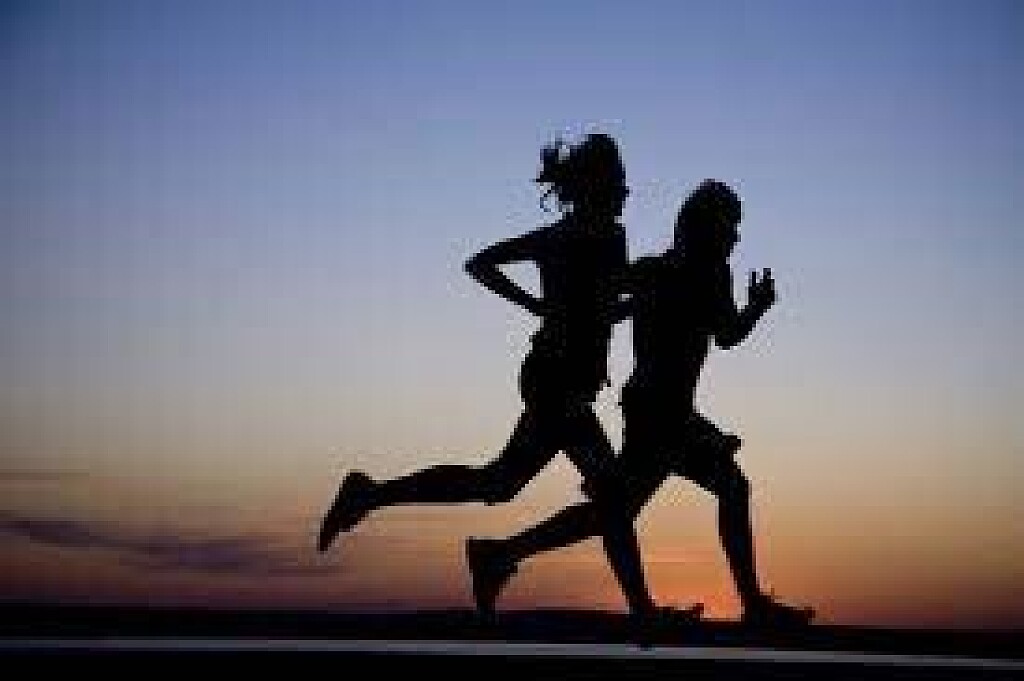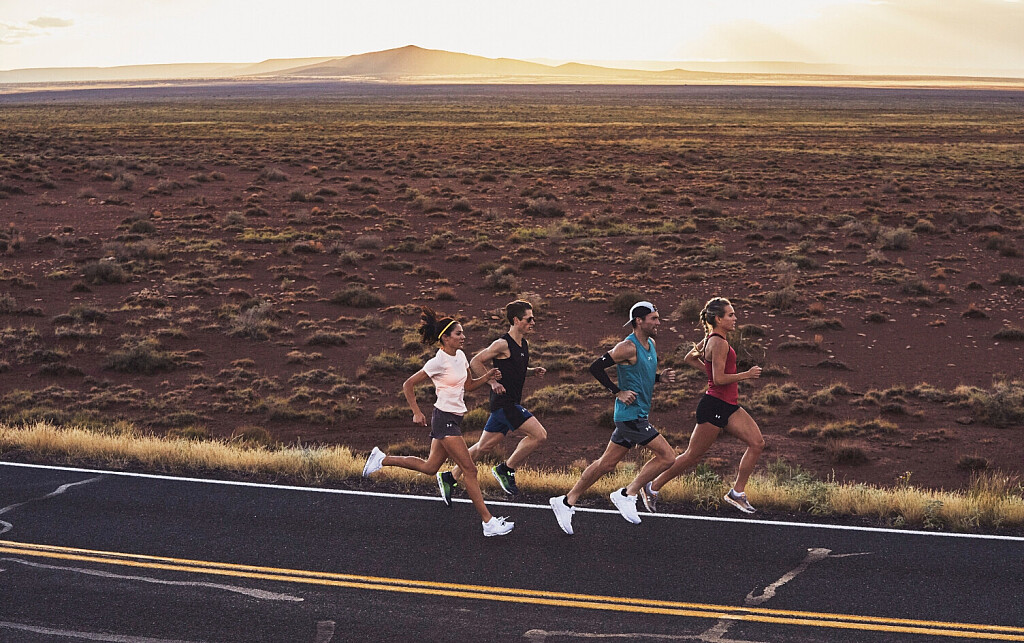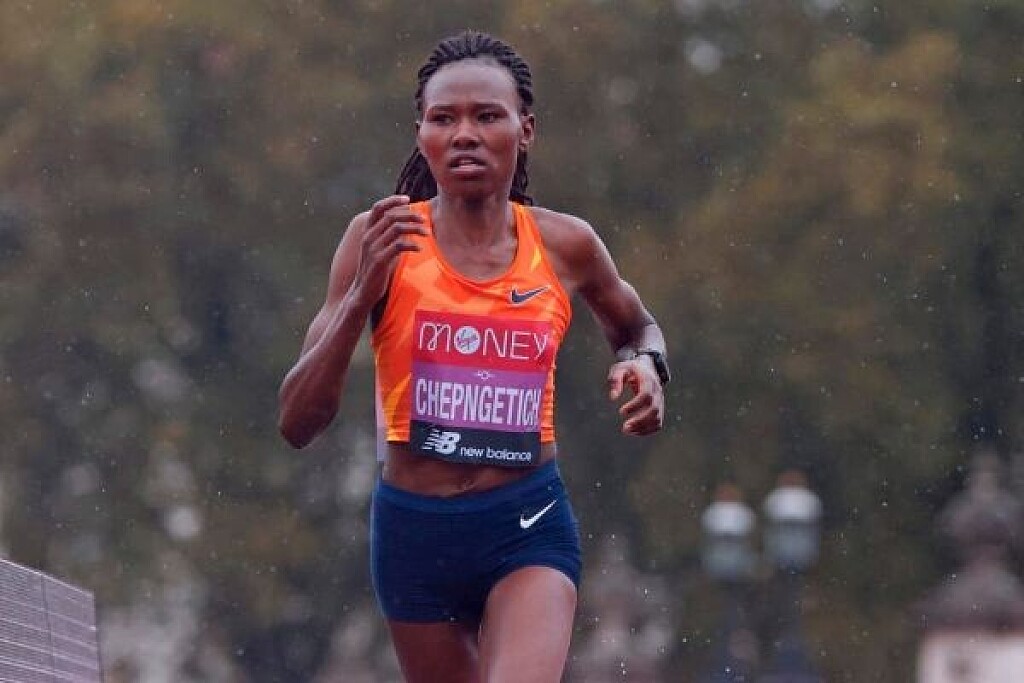Running News Daily
Running News Daily is edited by Bob Anderson in Mountain View, California USA and team in Thika Kenya, La Piedad Mexico, Bend Oregon, Chandler Arizona and Monforte da Beira Portugal. Send your news items to bob@mybestruns.com Advertising opportunities available. Over one million readers and growing. Train the Kenyan Way at KATA Running Retreat Kenya. (Kenyan Athletics Training Academy) in Thika Kenya. Opening in june 2024 KATA Running retreat Portugal. Learn more about Bob Anderson, MBR publisher and KATA director/owner, take a look at A Long Run the movie covering Bob's 50 race challenge.
Index to Daily Posts · Sign Up For Updates · Run The World Feed
The future of women's sport is very fragile, says Sebastian Coe
World Athletics President Sebastian Coe said the state of women's sports is "very fragile" and sports federations need to get it right when writing rules for transgender female athletes.
Coe's comments come after University of Pennsylvania swimmer Lia Thomas became the first transgender NCAA champion in Division I history by winning the women's 500-yard freestyle in Atlanta last week.
"The integrity of women's sport – if we don't get this right – and, actually, the future of women's sport, is very fragile," Coe was quoted as saying in British paper The Times on Monday.

"These are sensitive issues, they are societal issues – they go way, way beyond sport. I don't have the luxury to get into endless discussions or the school of moral philosophy."
Thomas competed on the men's team for three years before transitioning and moving to the women's team and setting multiple program records.
Last month, USA Swimming unveiled a new policy to allow transgender athletes to swim in elite events by setting out criteria that aim to mitigate any unfair advantages.
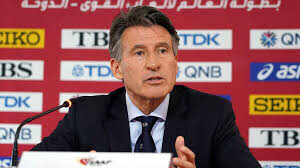
The rules include testing to ensure testosterone is below a certain level – five nanomoles per litre continuously for at least 36 months - in transgender athletes who wish to compete against cisgender female swimmers.
World Athletics requires transgender athletes to have low testosterone levels for at least 12 months before competition.
"We are asking for a greater length of (time) before competition because the residual impact of transitioning like that is more profound," Coe said.
"There is no question that testosterone is the key determinant in performance."
Transgender rights have long been a controversial and politically divisive issue in the United States from sports to serving in the military, and even what bathrooms people are allowed to use.
Coe said he understands the sensitive nature of the issue and said he wants to focus on the science.
Sebastian Coe "It's really difficult to keep the emotion out of this and subjectivity, so we do have to really stick as closely as we can to the science –and that's what we've always tried to do when it's been uncomfortable," he said.
"You can't be oblivious to public sentiment ... but science is important. If I wasn't satisfied with the science that we have and the experts that we have used and the in-house teams that have been working on this for a long time ... if I wasn't comfortable about that, this would be a very different landscape."
(03/22/2022) ⚡AMPby Rory Carroll
Feeling mentally exhausted? Go for a run, Research shows that physical activity is an effective strategy to promote cognitive regeneration after a mentally-exhausting day
Just like a particularly long or hard run will result in physical exhaustion, prolonged periods of cognitive activity (like studying for a test or even just a long day at work) can lead to mental exhaustion. Many people try to counteract this by doing activities wherein they can “shut their brains off,” like watching T.V., but research has shown this typically doesn’t work. What does appear to help? Physical activity.
Get moving to regenerate your mind
The study, published in the journal Psychology and Behaviour, investigated how a single bout of moderate aerobic exercise could help participants recover from experimentally-induced mental exhaustion.

To do so, the researchers put participants through one hour of mentally-demanding tasks in order to induce cognitive exhaustion. Participants were then separated into three groups: one that did 30 minutes of physical activity on a cycle ergometer, one that did 30 minutes of a lower-body stretching routine and one that watched a popular sitcom. Before and after the 30-minute treatment, researchers assessed the participants’ cognitive flexibility performance, mood, tiredness, restlessness, self-perceived cognitive capacity and motivation.
The results showed that the group who did 30 minutes of moderate aerobic exercise recovered better in almost every category than the other methods (stretching and watching T.V.), with the exemption of tiredness and restlessness.

“In conclusion, this study suggests that a single bout of acute aerobic exercise supports regeneration of cognitive flexibility performance and of subjective well-being,” the researchers said. “This holds true not just compared to artificial active control treatment but also compared to widespread leisure time activity, namely watching TV.”
Considerations for runners
So if you know you have a big test coming up or an important task at work that’s going to leave you feeling mentally wiped at the end of the day, it’s not a bad idea to plan a run afterward (even if you’re normally a morning run kind of person). It’s important to note, however, that researchers focused on moderate aerobic activity, and if you’re feeling mentally drained from a long day at work, a hard interval workout may not have the same effect.
More and more we’re learning how physical activity positively impacts the brain, and this is yet another reason to add to the list of reasons why running is good for your mind.
(03/22/2022) ⚡AMPby Brittany Hambleton
I can’t go to fight at my age, there is an army for that, but it’s important for people to show that we are alive and strong
On Monday March 7, as the world watched the war in Ukraine intensify, Nikolai Plyuyko did something extraordinary. He went for an 11-kilometer run through the streets of Kyiv.
Plyuyko has participated in 48 marathons in his lifetime. Before retiring, he worked as an engineer and served in the Soviet army. Today, Plyuyko is 75 years old and lives alone in what he describes as “a sleepy part of Kyiv”. Since war broke out, Plyuyko has maintained his schedule of daily outdoor runs, running around 150km in the past two weeks.

He laughs when I ask him if he’s scared of running outside. “During my run, I often hear more than 10 explosions which are within a 20km distance,” he says stoically. “What’s the point of worrying? I’ve lived most of my life anyway.”
The only two days that he didn’t go for a run were when Kyiv’s mayor, Vitali Klitschko, asked everyone to stay at home. “I want to show that we are a brave nation and that we aren’t afraid,” he says. “We want to be strong, not just with our minds, but with our bodies too.” Plyuyko has been greeting every person he sees on his run, trying to lift people’s spirits. “I wish them good health, hope and trust in the fight with the enemy. I tell them that we will win, that we just need to get through it.”
As Russian forces continue to destroy Ukrainian cities, break ceasefire rules and kill civilians, Ukrainians are terrified. In Kyiv, most people stay at home or in shelters overnight and keep outdoor trips to a minimum. At the time of writing, the centre of Kyiv has experienced a slightly more stable period than the first few days of the war, when Russian airstrikes colored the city’s skyline. Still, sounds of heavy fighting reverberate around the city’s historic buildings. During the daytime, the atmosphere is suppressed but hopeful, with people going outside to the pharmacy, to get food in shops and markets or for a quick walk to move their bodies. Yet, against all odds, and potentially their own safety, a small group of older runners are still heading out every day in Kyiv, sometimes running as Russian bombs fall around them.

Plyuyko runs in Natalka, a manicured public park that runs alongside the River Dnieper. In the last few days, he has even started going for a cold-water dip in the freezing temperatures of the river’s lagoon during his run. “I want to train myself to control my thermoregulation and find energy in my body.”
The daily exercise has been helping him process the absurdity of an unexpected war on his doorstep. “I think about many things during the run,” he explains. “I think about everything I’ve lived through.”
In the past week or so, Plyuyko has not only been running laps, but he has been running errands and getting groceries for people less mobile than him in his apartment complex. “I’ve been getting in line at the shop for them and running it to their homes. This is a sign of friendship during these hard times.” Locals have been happy to see him too; they call him “Uncle Kolya” and wave at him or sing him praise each time he passes them.
According to Plyuyko, most of the people who have stayed behind are either the “lonely elderly” or those who are choosing to protect their towns and other people’s lives. He is one of Kyiv’s residents who has decided to stay in Ukraine to see the war through to the end.
Just across town is Volodimir Shymko, a 67-year-old who has also been running to fill the city’s empty streets. “So many people have left Kyiv. I can tell which of our neighbours have stayed behind judging by whether their lights are on, and there are very few people who have stayed,” he tells me solemnly over the phone.
Shymko, too, hopes that his running raises people’s morale. “I can’t go to fight at my age, there is an army for that, but we will see how the situation continues – maybe everyone will be forced to fight.”
Konstantin Bondarev, 61, is based in the south of the city with his wife and two other friends who have come to shelter in his house. He has been running long-distance since 1983. “Now that there has been war, I’ve been running non-stop; it makes things feel a lot easier during such turbulent times,” he tells me. Since 24 February, he has clocked 73km in running distance. “Right now, thoughts of war keep going round and round in my head; from the moment you wake up, you start ringing all your friends, asking if everyone is alive and well over the messaging app Viber. When there are always attacks, you wonder if anyone has been bombed.”
This, of course, has affected his nervous system, so the run has been helping him deal with the stress of the war. “When I run, I can put all that aside – at least for a moment.”
In Ukraine, men between the ages of 18-60 have been banned from leaving the country in case they have to fight in the war, even if they have no military experience. “It’s important for people to show that we are alive and strong. This is our expression of the fight.”
Shymko’s daughter and his grandson have fled to a part of the country that has now turned into a hotspot for Russian attacks. “They want to get out, but they can’t right now. I’m really worried about them; it’s a very grave situation.”
Still, Shymko continues to run, in the past week, he has mustered 32km. The trained engineer, who is now a pensioner, has been a keen athlete since the 1970s. “I’ve run 40 marathons, and I’ve been in Berlin, Prague, Bratislava, Poland, Belgium, all around Ukraine.” And what would stop him? “Only if someone was to shoot at me multiple times,” he says macabrely.
The Guardian discovered Plyuyko and Shymko’s routes on Strava – a fitness-oriented social network that uses GPS data to track movement and allows users to share it publicly. The collected data is also used to create heatmaps, which shows trails left behind by the app’s users, so much so, Strava accidentally uncovered numerous unmapped military bases in 2018.
Calling the interviewees on Viber, the lines often went crackly, and Plyuyko, in particular, had trouble getting the app to work. “Can you hear me?” he would shout into the phone before hanging up multiple times. Eventually, we managed to set things up.
I spoke to everyone in Russian, as it was the only language we had in common, and I later translated the interviews to English. Listening back through the recordings, I could hear how much the men I spoke to really wanted to tell the stories of their lives and their runs. With a real possibility of Russian occupation, they were worried that their histories would be overwritten. When I asked for photos, they sent me dozens of images, some taken now and some taken when they are looking much younger. A horrible thought occurred; did they think this might be one of the last chances to be heard and to be seen by the rest of the world?
I have a friend in Kharkiv who hasn’t posted about running online for a little while – it’s worrying
“It’s only natural to be scared when you’re running, and bombs are going off in the distance, going ‘boom’,” says Bondarev. “That does take the joy out of it.” On the day I spoke to him, he went on a run that started well but ended quite ominously. “When I ran out, nothing was going on initially, but then a military plane flew by and then by the end of my run, I saw smoke billowing out of something in the distance. I ran home and took a photo.”
(03/21/2022) ⚡AMPby Diyora Shadijanova (The Guardian)
Josh Kerr hopes to make history at Hayward Field
Josh Kerr knows the history, that long line of British middle-distance greats who all but monopolised the men’s 1500m back in the 1980s. Those names – Seb Coe, Cram, Ovett, Elliott – conjure up memories of grainy footage, the kind Kerr has watched countless times on YouTube.
Now that he’s run faster than them all – his PB of 3:29.05 is behind only Mo Farah on the British all-time list – Kerr feels part of that lineage, especially after winning an Olympic bronze medal last year.

But as much as he appreciates the achievements of past generations, the 24-year-old Scot is keen to kickstart a new golden era.
“Myself and (Jake) Wightman, we’ve run faster than all those guys but they’re not known for how fast they ran, they’re known for what medals they won and what colours they are,” says Kerr. “We hadn’t won an Olympic medal in 33 years and hopefully we’re moving back into an era people will remember as the Kerr-Wightman era. I want to leave a stamp on the 1500 and grab that British record as an extra.
“But,” he adds, “it’s mostly about medals.”
The game is changing these days. In the decade preceding the 2019 World Championships, the quickest winning time in a global 1500m final was 3:33.61, and in just two out of seven championships did the winner come home in under 3:35.
Then there was Doha, where Timothy Cheruiyot blitzed a solo 3:29.26 to take gold. Two years later in Tokyo, Jakob Ingebrigtsen outkicked and outlasted Cheruiyot to set an Olympic record of 3:28.32.
Cheruiyot is 26, Ingebrigtsen is 21. Neither is going anywhere any time soon, and both are at their best when the pace is hard from the gun, which means that when it comes to global finals, the future is almost certainly fast.
Kerr knows this, and he prepares accordingly.
“The 1500 has evolved over the last two or three years,” he says. “We have to be strong and we train like a 5km athlete. That helps, knowing I’m going to get better round by round. It’s exciting for people to watch and it’s really hard for us racing, but that’s what we’re there for: to find the best.
“I do believe the world and Olympic champions over the next three or four years will be true champions – who are the best at the distance. Jakob last year was the best and he showed that in the final and Cheruiyot was second and I was third: those are honest, clear-cut, black-and-white results, and you can’t ask for anything more.”
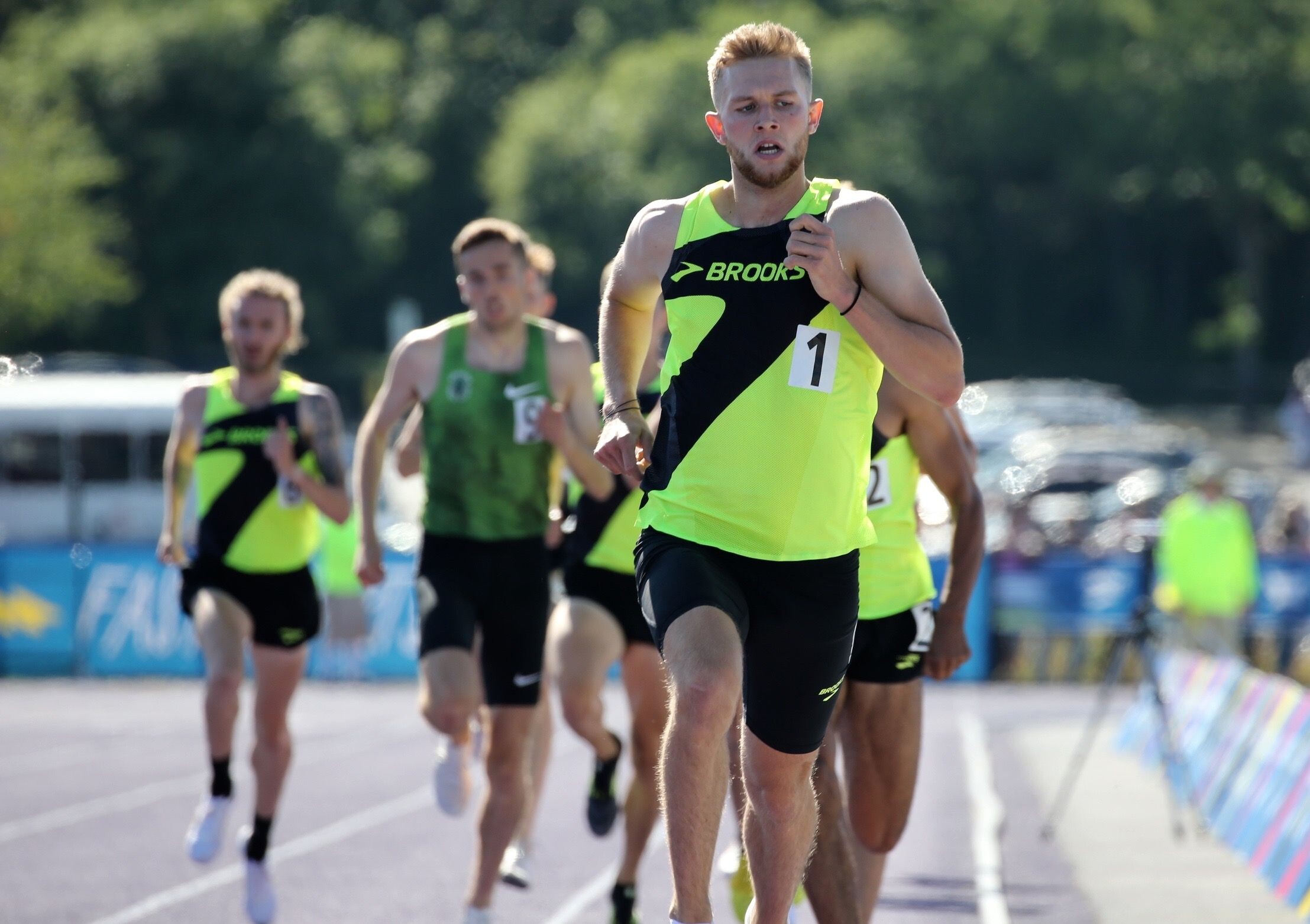
Kerr prepared for Tokyo in his typical manner, racking up 65-70 miles (104-112km) a week in training, along with two gym sessions. It’s been his approach since 2018, when he joined the Brooks Beasts in Seattle and began training with coach Danny Mackey.
Being a three-time NCAA champion for the University of New Mexico, the Scottish athlete had a wealth of options in the professional ranks. Why did he choose the Brooks Beasts? It came down to his trust in Mackey.
“I’ve had the most amazing, honest conversations with him,” says Kerr. “He knows me very well, I know him very well. He said, ‘this is the coach I am, we’re not the flashiest group but you come here, you’ll get better.’ He stayed true to that promise. I’ve got six seconds quicker since I’ve gone there.
“The training isn’t massively intense but what I do really well: my injury rate is really low and I’m able to stack a bunch of days together and it ends up being a phenomenal fitness level.”
That was exactly what Kerr carried to Tokyo, and while his 1500m PB of 3:31.55 had many underrating him at the time, his workouts convinced him he was ready to run 3:28.
“I thought, ‘you know what, the best way to run that is evenly,’” says Kerr. “I wasn’t planning on being so far at the back after the first lap but it was just so fast.”
Kerr narrowly avoided disaster in the heats, scraping through as a non-automatic qualifier, but he was far more convincing in the semifinal, finishing a close third.
After the first lap of the final, with Ingebrigtsen pouring it on from the outset, Kerr was 10th, splitting 57.3 seconds. By 800m he’d moved up to seventh. By 1200m, he was fourth, and ready to take aim at the big two out front – Ingebrigtsen and Cheruiyot – along with Abel Kipsang of Kenya. Kerr waited until the home straight before going for broke, overtaking Kipsang and finishing just 0.04 behind Cheruiyot.
“I was hoping for a better medal than the one I got,” he says now.
After the Games, he went to Albuquerque, USA, to spend time with his fiancee and a few weeks later he returned to Scotland. The last six months have been a “whirlwind”, but after a few weeks off Kerr was back into base training to prepare for better things again in 2022.
“It’s about building the motivation back up, climbing back up the hill with fitness and trying to show some better performances,” he says. “And hopefully better colour of medals.”
He had just one race set in stone for the indoor season: the Wanamaker Mile at last month's Millrose Games, a World Athletics Indoor Tour Gold event. After biding his time for seven laps, Kerr powered to the lead at the bell, but couldn’t hold off the vicious surge of longtime rival Ollie Hoare, who won in 3:50.83 with Kerr second in 3:52.27, just shy of Peter Elliott’s British record of 3:52.02.
“First one of the season is always going to be a bit rocky but I told myself I’d be aggressive, I’d push,” says Kerr. “I may have pushed a little bit too early, but I gave it my all. I like to press a little bit and see who falls apart, and it might be me. I’m not scared of anyone or any distance or any race.”
That may be Kerr’s only race of the indoor season. With an outdoor season overflowing with medal opportunities, he’s giving that his prime focus.
His main targets are the World Athletics Championships Oregon22 in July and the Commonwealth Games in Birmingham. Only after that will he make a decision on the European Championships in Munich.
“Because that’s enough for my brain to explode,” he says. “We’ll take it step by step.”
When he speaks of such championships, Kerr does so with a calm but resolute confidence that he can beat whoever he faces. It’s not surprising, given he has a habit of toppling favourites.
When he lined up in the mile at the 2017 NCAA Indoor Championships, he was a 19-year-old with a 1500m personal best of 3:41.08 – an athlete no one expected to challenge the all-conquering Ed Cheserek.
When Kerr surged past Cheserek with two laps to run, the ESPN commentator all but dismissed his chances: “That’s Josh Kerr, the New Mexico freshman, and that may just be a freshman move.”
But it wasn’t. Kerr ran Cheserek into the ground during the final lap, coming home a distant winner. He added the NCAA title outdoors that year – winning the 1500m at Hayward Field in Eugene, Oregon – and repeated his indoor win in 2018. Those successes taught him he could contend at global level.
“You have that mindset of wanting to be the champ, to go after the fastest guys,” he says. “You don’t care who anyone is, and if you have that fearless mentality you’re going to be fine in the pros. But if you always look at stats and look up to these guys, you’re going to find it hard to toe the line against them.”
Does he believe he can match Ingebrigtsen and Cheruiyot this summer?
“Yeah, definitely,” he says. “It’s quite funny, but people were saying, ‘any other Olympics you’d have won with the times,’ but they’re different races. The 1500m is exploding because of the way we’re running these races. Those guys are doing great things for the sport.”
Kerr knows those two will likely be the men to beat again in Eugene this summer. He’s not yet raced in the new-and-improved Hayward Field, but is relishing the chance to do so.
“It’s over the top,” he laughs. “It’s a phenomenal facility and I’m excited to go there and run fast. It’s built for fast times and for history to be made, and that’s what’s going to happen this year.”
He knows his sport’s history, but he also knows his own, and Kerr can extrapolate plenty from it about what might lie ahead.
“I was 37th (at the World Championships) in 2017, sixth in 2019, and third (at the Olympics) in 2021,” he says. “So in 2022 the trajectory is looking like second or first. That’s always what I’m going for. I’m always looking for progress.”
(03/21/2022) ⚡AMPby Cathal Dennehy (World Athletics)
World Athletics Championships Budapest23
Budapest is a true capital of sports, which is one of the reasons why the World Athletics Championships Budapest 2023 is in the right place here. Here are some of the most important world athletics events and venues where we have witnessed moments of sporting history. Throughout the 125-year history of Hungarian athletics, the country and Budapest have hosted numerous...
more...Sara Hall on Tokyo Marathon, Her Busy Schedule, & What’s Written on Her Bathroom Mirror Right Now
Few professional runners will have a busier first seven months of 2022 than Sara Hall. The 38-year-old American kicked off the year by running 67:15 to break the American half marathon record in Houston on January 16 and on March 6 ventured to Tokyo in an attempt to break the American record in the marathon. While Hall was on record pace through halfway (69:29), she faded over the second half but still ran 2:22:56 to finish 8th overall in the Japanese capital.
Hall is not resting on her laurels, however, as she will race the NYC Half on Sunday before tackling the Boston Marathon on April 18 and the World Championships marathon in Eugene on July 18. LetsRun.com caught up with Hall after she returned home from Tokyo last week to discuss her racing schedule, how she keeps improving deep into her 30s, how much faster she thinks Americans can run with the supershoes, and what goals she has written on her bathroom mirror.

You ran the Tokyo Marathon over the weekend. I assume you’re back stateside at this point. How are you feeling, and how is your body feeling after the race?
It feels pretty good. I would say pretty similar to other flat marathons I’ve done, maybe a little bit more sore on my right side, just with my knee, I think it’s been pulling a little more weight. But thankfully the knee came out of it really well and that was the main concern going in. And so I’m really excited to regroup toward the NYC Half and Boston, assuming I can stay healthy and have good training.
I emailed Ryan (Hall’s husband and coach) before the race and he mentioned that you fell and injured that knee in training a few weeks ago. How much did it affect your preparations for Tokyo, and how much, if at all, did it affect you during the race?
It didn’t affect me at all in the race. I didn’t feel it at all, thankfully. But it was one of those weird things where it just kind of dragged on. I didn’t expect it to be as much of an issue as it was but it was a pretty big setback at a pretty important time. It was hard to quantify how much it affected [my buildup] but I didn’t get in as much in the fourth and third weeks before the race.
With 10 days out from the race, I was feeling really good and it was finally responding really well to training. So I felt really good going into the race and was optimistic that all the training I had done prior to the knee was still in me and I’d be okay and I still wanted to stick to my original goal and stuff. But unfortunately, I wasn’t quite able to hold the pace I thought I would be capable of out there.
You just ran Tokyo and you’ve got a pretty busy schedule in 2022. You’ve got the NYC Half next weekend and then Boston and then the Worlds in July. You didn’t have to run Boston, but you are running it, so what made you want to run that race?
Well because it’s Boston. I’ve only gotten to run Boston once, it was absolutely incredible as an American out there and [a race where] I really saw Ryan come alive running in his career, probably his favorite spot. The one time I ran it, it was off really limited training off a stress fracture, so I didn’t really get the full experience because I crashed and burned pretty hard. But yeah, I think also having the chance to compete in a marathon, I definitely want some more opportunities for that. I really loved London [in 2020, when Hall finished 2nd] where I just got to compete out there and time was out the window. I think [ahead of] Worlds, [Boston] gives me another opportunity to do that. But really it’s just for the fun of it. I just love racing marathons and am really excited to experience it out there.
Your best marathons so far have come on flat courses. You mentioned you didn’t run as well as you liked in Boston (in 2019, when Hall was 15th), that was also coming off of injury. Do you think you’re a better flat runner than hill runner? And do you expect you might be able to do better on the hills this time around? Have you changed anything that you think might be able to help you succeed on the hills in Boston?
I feel good about the uphills. I do need some more downhill training between now and then, especially because I was starting to do that right when the knee happened, and then that was the absolute worst thing for the knee at the time so I definitely feel a little behind on that, and I think that’s a big factor in Boston to handle the pounding early on of the downhills. It’s a net downhill course. So looking to continue that, and I’m going to really need to stay on top of my recovery, my protein intake with the MuscleTech Pure Series because that eccentric load just really beats you up, so it’s just a fine balance with that. But I’m hoping also the supershoes factor will help, just because it’s my first hilly marathon in a super-cushioned shoe and that, I know from training, helps with the pounding component.
You turn 39 a few days before the Boston Marathon, but you’re not really slowing down very much – you just ran an American record in the half marathon in January. How much longer do you think you can keep going at this level?
It’s a good question. It is kind of surreal to think I’m going to be a masters [athlete] in a year. [laughs] I would have never thought I’d still be competing as a masters. It’s something I try not to think about – I learned this from Terrence Mahon, one of my coaches early on. Deena [Kastor] was joking about being old and he was like, “Deena, once you start saying you’re old, you start the clock.”
I was only, like, 23 at the time, but for some reason that stuck with me, that what you speak about yourself and expect makes a big difference. So I’ve just tried to be really intentional about not joking about that or expecting to slow down. My body’s still handling training really well, I’m finding ways to train smarter because I can’t really train harder or necessarily do more than I’m doing. Obviously my therapist John Ball in Phoenix has helped me so much with staying injury-free. That’s really the biggest limiter. Later in life, you can keep building aerobic capacity for a lot of years, but it’s really just can you stay healthy? So that’s a big focus. Recovering from training, obviously protein intake with MuscleTech, the recovery part is just an art that I’ve continued to try to perfect over the years. So I’m optimistic that my best marathons are still ahead.
You mentioned training smarter because there’s a limit to how hard you can train. Can you give me an example of something that you feel has helped you in that area to train smarter?
There’s some outside-the-box-stuff I do that I don’t really talk about because they’re my secret weapons. But I feel like those things are really what has allowed me to have the realistic jump I had in Berlin (in 2019 when Hall lowered her pb from 2:26 to 2:22) and I’ve really continued to do more and more of that type of training. They’re kind of secret, but I think what’s helped me is getting outside the groupthink of marathon training in the US. And that goes back to running Boston and Worlds and all these races. There’s a culture of we do things a certain way, but for me, I’ve been able to train in Kenya and Ethiopia and I’m just a curious person. I like to come up with outside-the-box stuff and Ryan’s similar. So I think some of that has really benefited me, having different perspectives and trying different things.
Since the supershoes came along a few years ago, we’ve seen the half marathon and marathon world records have drop quite precipitously. Recently, we’ve also seen the American records in those events have been lowered in those events, but not quite as much. How much lower do you think those records can go? Now that pretty much every American has access to some form of supershoe, what kind of times do you think Americans can run in those events?
That’s a good question. I think how I felt in Houston after that (where Hall ran 67:15 to break the AR in the half and Keira D’Amato ran 2:19:12 to break the AR in the marathon), and this sounds ambitious, but Josh [Cox, her agent] and Ryan and I are like, maybe breaking 2:18, that might be possible at some point. I’m not there yet, but thinking if you can just keep chipping away little bits. Definitely, the later stages of the marathon, [the shoes] just save your legs. And I think if I can do that, definitely some of these other people – Keira, the people that are running well – can do that too.
As far as the half, I think I can break 67:00. I’m sure other people can too. So we’ll see. Probably under 66:00 eventually, which sounds nuts.
Maybe not as nuts now that the world record is 62:52, right?
Correct, yeah.
You’ve run all of the World Marathon Majors. You’re running the World Championships this year. I know you’d like to run the Olympics one day. Are there any other races on your bucket list that you haven’t gotten to do yet?
Really it’s the Olympics at this point for me. I’d like to podium at a major in the US, but I’ve gotten to experience them all. NYC Half is one that surprisingly I’ve never run and I’ve won all the marquee New York races like the Fifth Avenue Mile and Millrose Games and Mini 10K and Dash to the Finish 5K. And obviously, the marathon is the hardest one to win, so that one and the Half, that would be amazing to go for those at some point. But just to experience the Half will be fun next weekend.
I have one more question. You’re famous for writing your goals on your bathroom mirror. So I’ve got to ask you: what’s written there right now?
Well my Tokyo goals got erased. So now I just have Boston and a picture of a medal and Worlds and a picture of a medal there right now. Those are really gonna be really insanely hard goals. And I think my personality is one where going into Tokyo, it wasn’t an ideal buildup but I’m still gonna just go out there and go for it.
And that has its hard parts with that personality, because you struggle with disappointment a lot. Medalling in those races, that’s a really big ask. But at the same time, you do have those moments where it does come together like those Houston days or the London Marathon days, so I’m going to keep taking big swings and having fun with the process.
(03/21/2022) ⚡AMP
by Let’s Run
Kenya’s Korir and Meringor were the winners of the 37th Los Angeles Marathon
Delvine Meringor of Kenya emerged Sunday as women's champion of the 37th annual Los Angeles Marathon while John Korir of Kenya was the men's winner.
Meringor held off Korir’s challenge by about 8 seconds at the finish line, winning the women’s race in 2 hours, 25 minutes and 3 seconds. For the second consecutive year Korir won the men’s race in 2 hours, 9 minutes and 7 seconds. Under marathon rules, elite female runners started the race 16 minutes and five seconds ahead of the men.


The elite athletes led the pack of an estimated 15,000 runners from around the country — and the world — covering a 26.2-mile course that spans some of the city’s most iconic neighborhoods. It was the second L.A. Marathon in four months. Last year’s race was moved from March to November because of the pandemic.
First American was Tyler McCandless in 4th place clocking 2:25:18. "4th place overall and 1st American today at the Los Angeles Marathon…and I qualified for my 4th Olympic Marathon Trials! Stoked," Tyler said.
(03/20/2022) ⚡AMPLos Angeles Marathon
The LA Marathon is an annual running event held each spring in Los Angeles, Calif. The 26.219 mile (42.195 km) footrace, inspired by the success of the 1984 Summer Olympic Games, has been contested every year since 1986. While there are no qualifying standards to participate in the Skechers Performnce LA Marathon, runners wishing to receive an official time must...
more...Amazing Wins and an Event Record at the 2022 United Airlines NYC Half
The United Airlines NYC Half made a spectacular return to the streets of New York City today as the first major NYRR race back at full scale since the onset of the pandemic.
This year’s event featured the strongest professional athlete field in event history, including 23 Olympians, eight Paralympians, six half-marathon national record holders, and the defending wheelchair division champions. In ideal racing conditions, the pro races played out thrillingly over 13.1 miles of New York City streets.
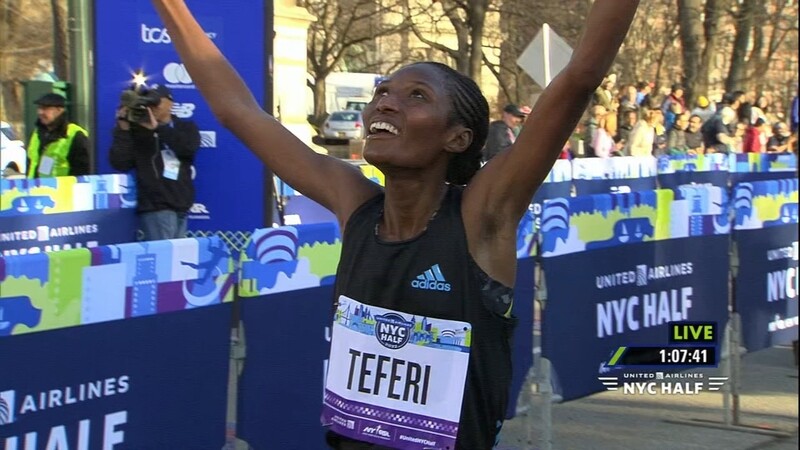
In the men’s wheelchair division, Daniel Romanchuk of the United States defended his title in a time of 49:22, more than two minutes faster than his winning time from 2019 and four minutes up on the rest of the field today. “I’m really happy to be back in New York racing and see the city so alive,” said Romanchuk a two-time Paralympic medalist and two-time TCS New York City Marathon winner.

For the women open race, Senbere Teferi of Ethiopia and Irene Cheptai of Kenya pulled ahead early and ran shoulder to shoulder in Brooklyn, across the Manhattan Bridge, and through Manhattan.
Teferi prevailed in the end, setting an event record of 1:07:35 and breaking Molly Huddle’s record by six seconds. Cheptai was also under the old record in a time of 1:07:37. “I was being very careful throughout the race and watching my pace,” said Teferi through a translator. “I’m very happy to have won.” Her victory is all the more remarkable given that she briefly took a wrong turn in the race’s final 100 meters. Karoline Bjerkeli Grøvdal of Norway was third in 1:08:07.
The men’s open division saw 22-year-old Rhonex Kipruto outlast a lead pack of four runners and break the tape in 1:00:30, just over a minute off the event record of 59:24, held by Haile Gebrselassie. Edward Cheserek of Kenya was second in 1:00:37 and Teshome Mekonen of Ethiopia finished third in 1:00:40.
“I feel good because I’ve come back again to win, and my first win was in New York,” said Kipruto, referring to his 2018 victory in the Healthy Kidney 10K in Central Park. “It was not an easy win today because the course was very hilly. It was about the win, not about the time.”
Today’s events also included the return of the Times Square Kids Run at the United Airlines NYC Half for hundreds of youth ages 8–18.
(03/20/2022) ⚡AMPUnited Airlines NYC Half-Marathon
The United Airlines NYC Half takes runners from around the city and the globe on a 13.1-mile tour of NYC. Led by a talent-packed roster of American and international elites, runners will stop traffic in the Big Apple this March! Runners will begin their journey on Prospect Park’s Center Drive before taking the race onto Brooklyn’s streets. For the third...
more...Barega upgrades to 3000m gold in Belgrade in one-two for Ethiopia
The Ethiopian domination of the men’s 3000m continued with an eighth gold and a second successive 1-2 in the event, Selemon Barega emerging victorious from a last-lap sprint with compatriot Lamecha Girma in the final morning session at the World Athletics Indoor Championships Belgrade 22.
Four years ago in Birmingham in 2018, Barega had to settle for silver behind Yomif Kejelcha but that was when he was an 18-year-old junior still learning his craft.

Four years on, with an Olympic 10,000m gold and world 5000m silver back home, the 22-year-old had too much strength and speed when Girma attempted to launch an attack on the back straight of the final lap, crossing the line 0.25 clear in 7:41.38.
As in the Olympic steeplechase final in Tokyo last year, and over the barriers in the 2019 world final in Doha, Girma finished in the silver position again, clocking 7:41.63, with Marc Scott timing his effort to perfection to claim Britain’s first medal in Belgrade – and their first in the event since Rob Denmark’s bronze in Seville in 1991.
It was a slow burner of a contest, Barega moving to the front after the opening lap and leading the field to 800m in 2:04.20. At that point, however, he was content to drift back as Kenyans Daniel Ebenyo and Jacob Krop assumed the lead but without ever threatening to make a decisive break.
At the bell Barega was back in front with six others still in the hunt but none of them could match him – even Girma, who had got the better of him earlier in the season in Lievin and Torun.
“We came to Belgrade aiming to make history for Ethiopia,” said Barega. “I have had a good season, so I was ready both physically and mentally to fight for gold. With Girma we discussed the possibility of helping each other make the podium. Our tactic has paid off.
“It was a tough race in which we were focused mostly on the Kenyan guys,” he added. “I decided to lead the race from the beginning because many runners in this final are 1500m specialists. I just wanted to make the pace fast and comfortable. Then I slowed down to save some energy for the finishing kick. It was a good plan and another great experience for me.”
And so the Ethiopian with the awesome range found himself emulating his celebrated compatriots Haile Gebreslassie and Kenenisa Bekele as an Olympic champion at 10,000m and a world indoor winner at 3000m
Gebrselassie, of course, also struck world indoor gold as a 1500m runner in Maebashi in 1999 – as well as taking the 3000m crown in 1997, 1999 and 2003.
The other Ethiopian 3000m golds came from Bekele in 2006, Tariku Bekele in 2008, and Kejelcha in 2016 and 2018.
Scott took the bronze in 7:42.02, 0.95 ahead of Ebenyo in fourth, with Krop in fifth, Zouhair Talbi of Morocco in sixth and Spain’s Adel Mechaal seventh.
(03/20/2022) ⚡AMPby World Athletics
Sebatian Coe says sports must fight to keep Russia banned
Sports federations have set precedents by banning Russian and Belarusian athletes from competition following the invasion of Ukraine and they must remain firm to keep them in place, Sebastian Coe said Monday.
Coe is a two-time Olympic champion runner from Britain who is now the president of World Athletics, the governing body of track and field. He spoke four days before the start of the world indoor championships. Both Russians and Belarusians have been excluded from that event, which will be held in Serbia.

“There’s not a single sports federation out there that naturally wants to exclude teams or individuals. That’s not something that we came into the sport for,” Coe said during a video conference call. “But I think we have to recognize that this is such a game changer. And, yes, it will set precedents.”
Athletes and teams from Russia and Belarus have been kicked out of dozens of sports since Russian forces invaded Ukraine last month, with some soldiers entering via Belarus. The biggest events to be immediately impacted by the decision to ban Russians and Belarusians include the upcoming track championships, the figure skating world championships and soccer.

The bans from soccer, which include the Russian national team from World Cup qualifying and Russian club Spartak Moscow from the Europa League competition, have been challenged by the Football Union of Russia. The first appeal rulings are expected this week from the Court of Arbitration for Sport — the highest sports court in the world.
“We absolutely accept that this will set precedents and those precedents will have to be faced individually and sequentially and they will be with us for years,” Coe said. “We haven’t made this easy on ourselves but it is still the right decision.
“You cannot have aggressor nations, where you have so altered the landscape for the integrity of competition being untouched, while the actions of their governments have so influenced the integrity of sport elsewhere.”
Russia’s opponent in the World Cup qualifying playoffs, Poland, has said it won’t play against the country on March 24. The two next possible opponents, the Czech Republic and Sweden, have said the same.
Track and field had previously been the hardest on Russians following the country’s state-sponsored doping scandal dating back to the 2014 Winter Olympics in Sochi. Russians now have to be individually vetted in order to compete in international track events. The Russian track federation has been banned since 2015.
“I don’t have a problem with (banning Russians) because that’s what we’ve done in our sport. I don’t see why that should be different in any other sport if you’re making that judgement on the integrity of the sport,” Coe said. “Goodness me, in football, you’ve already seen teams that decided they’re not going to play in playoff rounds.
“The impact is across the board. So they are going to need to remain really firm on this and do exactly what we’ve done.”
(03/19/2022) ⚡AMPby Chris Lehourites
Rhonex Kipruto will lead Kenyan cast for New York Half Marathon
Rhonex Kipruto will be hoping for a bright start to the season when he lines up for the New York Half Marathon in United States of America on Sunday.
He is among elite athletes who will be battling it out for top honours in the prestigious race which has attracted a good number of entries.
The race will begin in Brooklyn at Prospect Park before taking runners across the East River via the Manhattan Bridge then head to Lower East Side, up to Midtown, through Times Square and conclude at Central Park.

Kipruto, who has been training in Iten, Elgeyo Marakwet County will be competing against his compatriots who include Edward Cheserek who has been training in Kaptagat and Stephen Sambu who is also in the US.
The trio will face stiff competition from Ethiopians Tariku Bekele, Birhanu Dare and Ashenafi Birhana, Galen Rupp and Shadrack Kipchirchir from USA among other top athletes.

In an interview with Nation Sport, Kipruto said he has trained well and since this is his first race this season, he wants to gauge his performance as he sets his eyes on the World Championships slated for July 16-24 in Eugene, USA.
“The race will be competitive but I will be out to gauge my performance as we start another season where I’m looking forward to a better one compared to last year. I have trained well but I can’t say that my training is 100 percent,” said Kipruto.
He revealed that last year he participated in various races but this year he wants to concentrate on preparing for the World Championships thus he will reduce the number of races he will feature in.
“Last year I participated in many races and I came to realise they were not of help and that’s why I want to run few races as I prepare to make the team that will be participating in World Championships in July,” he added.
Kipruto was a late inclusion in the Tokyo Olympics team for the 10,000m race after withdrawal of Geoffrey Kamworor which led to his dismal performance where he finished ninth in 27:52.78.
In the women's category, Irene Cheptai will be joined by two-time world marathon champion Edna Kiplagat, Sharon Lokedi and Grace Kahura.
Cheptai, who is also starting her season revealed that she has been training well in Iten, Elgeyo Marakwet and she just wants to run a good race as she also sets her sights on World Championships.
“I’m going into the race to just see how I will perform and with such a good field of athletes, I will be eyeing a good race. This is part of my preparations for global events like World Championships and Commonwealth Games,” said Cheptai who finished sixth at Tokyo Olympic Games in the 10,000m after timing 30:44.00.
The Kenyan athletes will be competing against Ethiopia’s Senbere Teferi, USA’s Sara Hall, Charlotte Purdue among others.
(03/19/2022) ⚡AMPby Bernard Rotich
United Airlines NYC Half-Marathon
The United Airlines NYC Half takes runners from around the city and the globe on a 13.1-mile tour of NYC. Led by a talent-packed roster of American and international elites, runners will stop traffic in the Big Apple this March! Runners will begin their journey on Prospect Park’s Center Drive before taking the race onto Brooklyn’s streets. For the third...
more...Pro Runner Ben Blankenship Believes High Mileage Is Overrated
Ben Blankenship of Oregon Track Club Elite believes there are other important ways to measure running success.
Hear me out: High mileage is overrated.
A couple months ago, I posted that on Instagram. Mostly because it’s true—I don’t think running high mileage is always the best way to reach your potential—and partially because I’m a guy who loves to stir the pot.
It definitely drummed up conversation. I received dozens of comments and messages, some defending mileage, some agreeing with me, but all coming to a similar conclusion: It depends on runners to learn what’s best for themselves.
What worked for me? I came from a low-mileage, high-intensity high school program. The Minnesota track season was only a few months long, due to weather and the popularity of winter sports. We didn’t have an indoor track season either. Outdoors we would race twice a week, go to state, and that would be it.
When I started my college career at the University of Minnesota, coach Steve Plasencia focused on longevity. He wanted us to have a long and prosperous career, even post-collegiately, so he never had us immediately reach for high mileage. Also, back in the early 2010s, not everyone had GPS watches. So when I return to my college running loops, I’m like, man, that used to feel longer than it actually is, because we never actually measured them.

When I began my professional career with the Oregon Track Club Elite in Eugene, coach Mark Rowland eased me into higher volume. Instead of getting stuck in the mentality of needing a certain amount of miles, I put the emphasis on how good my workout sessions were. It was all about being able to handle high intensity at high volume with low rest.
For example, I remember one workout when I switched between four 1,000-meter repeats on a trail, eight 400-meter repeats on the track, then back to the trail for another four 1,000-meter repeats. I only had half each rep’s time to recover. Whenever I was able to complete those types of workouts feeling strong, I knew I was in good shape.
The philosophy worked. I saw plenty of success in the 1500 meters, qualifying for the 2016 Olympics and earning a spot in the final.
After that Olympic cycle, I wanted to become a versatile athlete, able to run fast at any race distance. I already had so much quality work behind me that I thought, “What’s left to do?”
My answer at the time was more mileage. So from 2017 to 2019, I upped my weekly average from 75 to 100. I decided to test my new philosophy by chasing the 10,000-meter Olympic standard of 27:28.00, because I have a romantic view of the 10K. It’s poetry in laps.
The guys I trained with were all 100-mile-plus-week types, so I added six-mile afternoon doubles and longer cooldowns with them to prepare. I kept thinking how awesome it was to be a high-mileage runner. At the end of 2019, I got a little banged up with injuries. So to come back stronger, I doubled down on the mileage.
It worked for a while. I debuted over 10,000 meters with a 28:08.20 in August 2020. But I felt stiff, tired, and not very productive in my workout sessions—exactly the opposite of what my philosophy used to be.
Toward the end of 2020, the real injuries started. I hurt my Achilles and my plantar, and suffered a small tear in my hamstring. I eventually ended up with a stress fracture in my tibia in late spring 2021.
As a result, my buildup to the Olympic Trials wasn’t great. I had almost zero on-the-ground training; I was either in the pool or on the bike.
While I wasn’t as competitive as I had been in years past, I was amazed at my racing ability, making the semis despite not running much in my buildup. That was eye-opening. What was I doing to get my cardiovascular fitness up? What was I able to do neurologically without the pounding of running?
Now, I know that much of it has to do with how long I’ve been doing this. I have 18 years of running in me, week in and week out. That has allowed me to sit back and say, “Okay, what weaknesses do I need to focus on?” instead of worrying about an entire rounded-out training program. So I realized I don’t have to run high mileage—there are other ways to get better at running.
As a 33-year-old, my focus is to be athletic. After the Olympic Trials, I started to play basketball. I felt strong and powerful, and my range of motion was fluid and comfortable. I returned to training refreshed and ran a couple of good races.
Not everyone is built for other sports or willing to risk running to play them. I remember my parents putting hockey skates on me and my ankles just not moving that way. But one easy way to stay athletic is to prioritize fast running. A lot of runners will throw strides in after a run when their body is already tired. But I propose making them the main focus sometimes.
Get to the track, warm up for 15 to 20 minutes, put some spikes on, and prioritize moving quickly. Run efficiently and fast for 80 meters, the first 60 percent easier and the last 40 percent harder. Walk and jog the next 320 meters and do another. In total, do eight to 10. Think about using good form and pulling yourself forward off the ground. On a nice day, you can even find a turf field and kick your shoes off for some barefoot strides. Follow the same idea as before, but instead of measuring out meters, just run the diagonal across a soccer field and jog a lap for rest.
Keep in mind, this is what I’ve learned throughout the course of my career. If you’re a beginner, you might get overwhelmed by the different perspectives out there. So my main advice is to be a student of the sport. Ask yourself: Why am I running these miles? What am I getting out of the work I’m putting in? Why am I doing this type of workout, this type of run, this type of cross-training?
If it makes sense for you to run higher mileage because you’re new to running and need to build a base, then do it. What high mileage means completely depends on the person; for some 40 is a lot, for others 100 is. But if you’re suffering for the sole purpose of suffering, then you’re doing it wrong. The goal is to improve yourself. Success is more likely to come if you focus on the purpose of your miles instead of the number of miles you run.
(03/19/2022) ⚡AMPby Runner’s World
The 8 most common running injuries and why they happen
If you run consistently for long enough, there’s a good chance you’ll experience a running-related injury, and there’s also a good chance it’ll be one of these eight common problems. Whether it’s in your knees, legs, hips or feet, running injuries can be frustrating to deal with. Understanding why they happen and knowing what to look out for is the first step in preventing small niggles from becoming big problems.
Ankle sprains
While less common for road runners, those of you who like to put in their miles on the trails are at a higher risk for ankle injuries. An ankle sprain happens when you land on the outer part of your foot and roll your ankle over. Ankle sprains range in severity and usually result in symptoms like discolouration, pain, swelling, bruising and a limited range of motion.
The trouble is, once you’ve rolled your ankle once, you become more prone to rolling it again. Once you’ve given your ankle plenty of time to heal, it will be very important to strengthen the ligaments around your ankle to prevent spraining it again. A physiotherapist will be able to provide you with an appropriate strength training plan to prevent future injuries.
Hamstring injuries
Your hamstrings play an important role in your running stride, but if they are weak, tight or tired, they’ll be more prone to injuries. Many distance runners end up with hamstring strains that appear slowly over time, caused by small, repetitive tears in the muscle tissue.

Symptoms of a hamstring strain could include a dull pan in the upper part of the back of your leg, tenderness in the back of your leg or weakness or stiffness in your hamstring. Most hamstring injuries can be fixed with rest and a strength training program.
IT band syndrome
Your iliotibial (IT) band runs from your hip to your knee. Often mistaken for a muscle, your IT band is actually made up of connective tissue that stabilizes your knee when you’re walking or running. Unlike a muscle, the IT band can’t be stretched or strengthened, but you can stretch and strengthen the muscles around it.
IT band syndrome happens when your IT band rubs against your leg bone, creating friction. In many cases, this “tightness” of the IT band is caused by weak glute muscles, abdominals or hips. Symptoms usually include a sharp pain on the outside of your leg, often just above the knee, that typically gets worse when you bend your knee.
In most cases, treatment and prevention of IT band syndrome include strengthening your glutes, abdominals and hips to take the train off of your IT band.
Stress fractures
A stress fracture is a small, hairline crack that forms in your bone from repetitive stress or impact. Common places runners may experience a stress fracture are on the top of the foot, the heel or in the lower leg. The pain from this injury is often barely noticeable at first, but progresses over time to the point that you can even feel it at rest. You also may notice swelling, bruising or tenderness in the affected area.
If you think you have a stress fracture, you’ll need to see a doctor right away, who can use an x-ray to diagnose the injury. You will have to avoid putting any pressure on the injured area for a while, since it generally takes six to eight weeks for a stress fracture to heal.
Plantar fasciitis
Plantar fasciitis is the inflammation of the thick layer of tissue on the bottom of your foot, called the plantar fascia. This tissue is heavily involved when you push off from the ground as you run, and can easily be over-stressed when you increase your mileage too quickly. Weak or tight calves can also put more stress on your plantar fascia.
Symptoms of plantar fasciitis typically include pain under your midfoot or heal (that often comes on gradually), a burning sensation on the bottom of your foot, pain that’s worse in the morning or pain after prolonged activity.
Plantar fasciitis can be difficult to get rid of, and often requires a combination of rest, massage, strength training for your lower legs and a gradual return to running is the best way to fix the problem and prevent it in the future.
Achilles tendonitis
Your Achilles is the tendon that connects your calf muscle to your heal, and can often become inflamed from repetitive activities like running. In most cases, Achilles tendonitis will flare up after you’ve increased your running volume or intensity.
It’s important to treat your Achilles right away when you begin to feel pain, because it increases your risk for rupturing your Achilles tendon, which requires surgery and months of recovery to fix. Common symptoms of Achilles tendonitis include a dull pain above your heel, swelling along the tendon, a warm feeling where your Achilles tendon is located or a limited range of motion when you try to flex your foot toward your shin.
Achilles tendonitis can be difficult to get rid of, so make sure you book an appointment with a physiotherapist to help you solve the problem.
Shin splints
Shin splints are one of the most common injuries for beginner runners, or for people who are returning to running after a layoff. Common symptoms include a dull pain on the front or inner part of your shin bone, mild swelling or tenderness in your shins and pain that gets worse as you run.
In most cases, shin splints will go away with adequate rest. To prevent them from happening, make sure you strengthen your lower legs and feet, and be careful to increase your mileage gradually to give your body time to adapt to the increased stress.
Runner’s knee
We’ve left this one to last because it is arguably the most common issue faced by runners. In fact, some studies suggest up to 50 per cent of all running injuries happen in the knees. Runner’s knee, or patellofemoral pain syndrome, generally refers to pain felt in the front of your knee or around your kneecap.
Symptoms of runner’s knee often include a dull pain in one or both knees that ranges from mild to very painful, pain that gets worse with prolonged activity or prolonged sitting and pain that worsens when doing other activities like walking up stairs, squatting or jumping.
Weakness in your hips and the muscles around your knees can put you at a greater risk for runner’s knee, so strengthening those areas can help get rid of the injury and prevent it in the future. Since knee pain can be caused by a variety of factors, you should see a physiotherapist or sports doctor to have it diagnosed, and to rule out other possible conditions.
(03/19/2022) ⚡AMPby Running Magazine
Lenny Maughan expresses solidarity with Ukraine in his latest Strava art
Lenny Maughan is using Strava to show support for Ukraine. For his latest creation, the Picasso of Stava art ran nearly 90 miles (145 km) to “draw” a sunflower, which has long been a symbol of peace for the Eastern European country.
Maughan has become widely recognized in the running world for his impressive Strava creations, including his rendition of the artist Frida Kahlo and most recently, his tiger created in honour of the Lunar New Year. These works of art often require hours of preparation and many miles of running to complete.

His sunflower run took 89.5 miles (144 km) and more than 20 hours to complete, on top of five hours of planning before setting off on his run. To make the feat even more impressive, Maughan lives in San Francisco, which is known for its hilly streets, and in total, he gained nearly 10,000 feet (3,000 m) in elevation throughout the entire run.
Runners in Canada and around the world have been using running to express their support for the people of Ukraine with the Ukraine virtual running challenge.
(03/19/2022) ⚡AMPby Running Magazine
New Balance to launch new mental health initiative
’New Balance will be launching a collaboration with the Los Angeles-based apparel company, District Vision, which features a collection of specialized apparel and footwear. District Vision also offers a series of online courses aimed toward providing customers with strategies designed to increase mental health awareness through running.
“The goal is to redefine what a collaboration between a performance and a fashion brand can accomplish,” says District Vision co-founder Max Vallot. Both brands will aim to offer long-term benefits beyond the physical results of running.There will also be five online courses offered that focus on education and aim to help runners explore their minds. The first of these courses is “Runners Heart”, which will feature Team New Balance athletes and U.S. Olympians Emily Sisson and Brenda Martinez on what they do as professional runners to get over mental limitations.
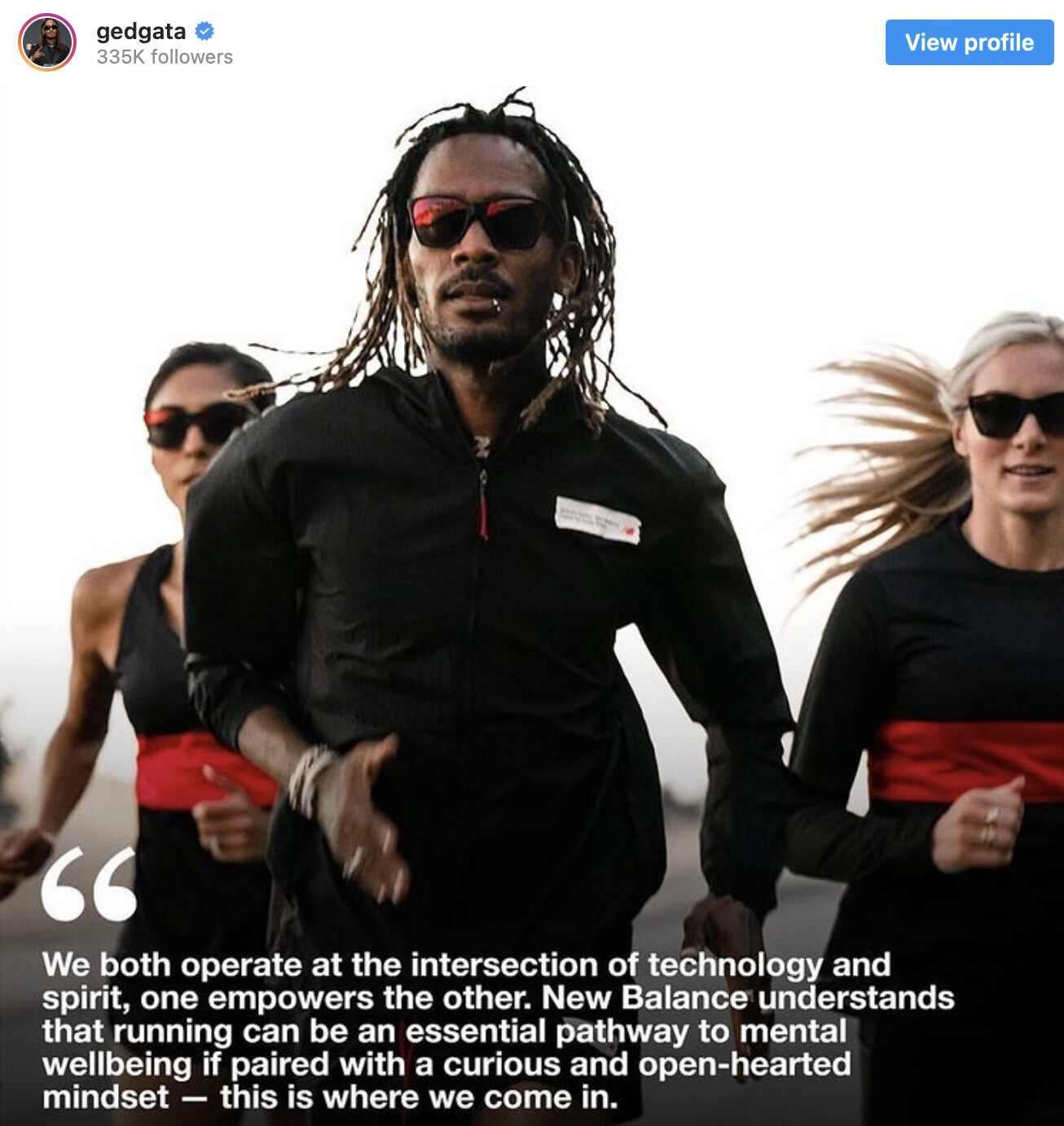

Another course is “MindDiscovery,” offered by New Balance ambassador, rapper and mental health awareness advocate, GaTa. The rapper chats about his recent introduction to the sport of running and how it has shifted the way he now approaches mental health. All courses are now available online on the District Vision website, with each course available for CDN $12.
All apparel is organically hand-drawn by renowned Polish artist Filip Pagowski, featuring mindful aesthetics to make up a functional and artistic uniform for everyday performance. The NB x DV collection is made up of two colourways of the carbon-plated FuelCell RC Elite v2 and an array of custom apparel pieces.
The collection will be available exclusively at districtvision.com on Thurs, March 17, and the collection will launch globally on newbalance.com on Thurs, March 24.ve always said that I only run uphill to get to the downhill.
It is undoubtedly my favourite part of trail running: zooming downward, letting gravity take the wheel, yelping Mario Kart noises with every near-stumble. As with all things in life, you don’t get to enjoy the reward without putting in the work to get there, and the faster you can get up, the faster you get to the fun part.
(03/19/2022) ⚡AMPby Running Magazine
Does Yoga Improve Running Performance? Here's The Science.
Stand up with your feet under your hips. Bring your hands together in front of your chest. Breathe in, and as you exhale release all of the tension you brought into this article. Open yourself to the possibilities of the paragraphs ahead.
Now buy a friend a gift from all of our sponsors.
What? No? Oh I think I got mindfulness confused with hypnosis.
I think many athletes feel like yoga practices can be a whole lot of psychological hooey, an unproven gumbo of faux-spirituality and stretching that is more placebo than prescription. "Give me the evidence," they'll say. When presented with people saying how much better it makes them feel, that becomes more anecdata to incinerate in a bonfire. Double-blind controls or GTFO.
I used to lump yoga and hypnosis and healing crystals into the same hooey pile. But when I was in college, before I became a coach, I decided to take an intro yoga class for a Physical Education credit. In case you were wondering, that's what six figures of student-loan debt went to. Shockingly, that very expensive yoga class may have been the most important experience I had in college.
I sucked at it. But with time I got a bit more proficient. I learned to control my anxiety, first related to the class itself, then outside of class. And that coincides with the window when my running started improving too.

Now, I have no idea what that was measuring. I am so susceptible to the placebo effect that if you gave me a sugar pill with confidence, I'd get high as a kite and maybe be able to read minds. At the very least, the yoga class opened my mind to the potential benefits of a focused practice.
While I fell away from yoga practice over time, I have seen plenty of athletes use yoga to complement their running schedule and have great success. So what are we seeing? Correlation? Causation? A shared sugar-pill delusion? Let's break it down into its component parts before considering the few studies on yoga specifically.
Stretching
Yoga can mean a lot of different activities, but most of the movements involve some sort of stretching. A 2012 article in the International Journal of Sports Physical Therapy laid out the basics: stretching generally focuses on lengthening the musculotendinous unit, increasing the length between the muscle origin and insertion. Muscle length has an inverse relationship with muscle tension/stiffness, a way to describe biomechanical and neuromuscular factors that affect how muscles contract (this book excerpt from Plyometric Anatomy has more).
Now imagine the tension like a trampoline. Too little tension, and you could picture flopping down lazily and having little energy return. Too much tension, and you'd fall on what amounts to a brick wall. Each athlete will likely have an optimal level for injury risk and performance that varies a ton by the person and over time.
To summarize the numerous studies, the basic conclusion is that stretching before activity reduces running economy, like kids playing on a used trampoline, wishing their parents didn't spend six figures on college yoga classes. A 2015 review study in the Applied Physiology, Nutrition, and Metabolism journal pegged pre-activity static stretching as a 3.7-percent reduction in subsequent running economy. Meanwhile, dynamic stretching improved performance slightly. That study found no change in injury rates. A 2017 review study in Research in Sports Medicine found no settled science on whether post-activity stretching affects performance. The jury is also out on injury risk.
At the very least, the yoga class opened my mind to the potential benefits of a focused practice.
Notably, most of those studies measure basic stretches in a lab for force-generating muscles. Maybe flow or core-oriented stretches would have different outcomes, more like the dynamic stretches. Plus there is variance across studies and for individual participants within studies. That raises the big question of studies generally: what are we actually measuring?
A good example might be this 2009 study in the Journal of Strength And Conditioning Research, which found that collegiate distance runners who were less flexible tended to be more economical. Read that together with research that has posited that flexibility has a large genetic component, and that genetically inflexible athletes may have better economy. Possibly a genetically inflexible athlete could stretch and still be rather inflexible, yet with good running economy (or maybe not). So maybe we're measuring individual genetic predisposition and responses rather than uniform physiological rules. It probably benefits older athletes more as well, since range of motion can decrease over time.Strength
Yoga often includes bodyweight-strength elements that could play a role in performance. You can think of the mechanisms without me listing them out. Every PT says you need to activate your glutes, and yoga is all about those buns, babyyy. Pros do core work, and I wouldn't be surprised if yogis plank in their sleep. Yoga could theoretically strengthen everything that matters and many of the things that don't.
Maybe a good way to isolate that unique brand of strength is by looking at pilates, which seems a lot like yoga but without as much stretching. A 2018 study in the PLoS One journal found that pilates improved 5K performance by over a minute more than a control condition during a 12-week training program. Note: there were no results reported on the status of those buns.
That study could be measuring something else too. The participants only did two sessions of running a week, so maybe pilates just filled in some major aerobic and fitness gaps that could have been filled in with running or cross training. Or maybe I should stop being such a buzzkill.
Numerous studies support different types of strength work for running economy improvements and injury prevention. Whether yoga overlaps with that would probably require more studies on specific approaches, and who has time for that when you can watch season 2 of Fleabag for the eighth time? Hot Priest is the gift that keeps on giving. And that ending? Trust me, it's worth it.
Psychology
There are also components of mindfulness, brain chemistry and social support that could play a major role in possible yoga benefits. For example, this 2014 study from the Psychology of Consciousness journal found that a yoga and mindfulness intervention in a division 1 NCAA sports team resulted in greater mindfulness, greater goal-directed energy and less perceived stress.
Let's just take it as a given that there will be a slight mental benefit for people that enjoy yoga, maybe a slight detriment for people that don't enjoy it and definitely a major catastrophe for people that are allergic to Lulu pants.
That's backed up by this 2015 systematic review in the Journal of Clinical Sports Psychology that found mindfulness had significant benefits across the literature. Let's just take it as a given that there will be a slight mental benefit for people that enjoy yoga, maybe a slight detriment for people that don't enjoy it and definitely a major catastrophe for people that are allergic to Lulu pants.
Give Me the Yoga Science
Somewhat surprisingly, I can't find definitive studies on yoga practice and running performance. Maybe I'm missing something, but even if there were performance studies, it would probably depend heavily on the type of yoga practice and it would be difficult to make broadly applicable conclusions.
A 2006 study in the British Journal of Sports Medicine found that participants assigned to do brief yoga exercises improved performance over a control group. There were 11 entry-level yoga asana positions: mountain pose, asana 2, forward bend, lunge, plank, staff, upward facing dog, downward facing dog, lunge return, mountain pose return and breath of fire.
But and please read this sentence slowly the yoga group improved less than the group that stood around in a circle for nine minutes and screamed motivational phrases at each other. The example given in the article is: "You're the definition of speed!" I just took a DNA test and it turns out I am 100-percent in love with that study.
Hot yoga could have additional benefits, but again not too much on runners specifically. A 2018 study in the Journal of Strength and Conditioning Research had 10 international-caliber field-hockey players do six days of hot yoga and they had a five-percent increase in blood-plasma volume and a slight speed increase at ventilatory threshold.
A 2012 study found that yoga practice increased adherence to other forms of exercise in previously sedentary adults. Maybe that's relevant. I'm really grasping at straws here.
Hey, while we're looking for scientific studies, this one from 2010 says it could improve male sexual function and this one says it could improve female sexual function. This is what happens when you search for "yoga and performance."Putting It All Together
My hypothesis is that the strength and mindfulness (and heat if applicable) components of yoga are likely helpful for many athletes. The stretching element likely depends heavily on genetics and practice type. I used the word "hypothesis" because it sounds better than "throwing darts at a guess board."
Tons of athletes swear by yoga, and I think they are almost certainly right for them. Yoga can provide strength, it can make you aware of imbalances, it can improve body awareness and body image. That's great, and if you are looking for a change, consider adding a yoga practice a couple of times a week, especially if you have dealt with injuries or burnout. Some of the athletes I coach swear by Fightmaster Yoga, which has free videos on Youtube. Or even better, join a class for the social support and guidance. Monitor how you feel over a couple months and make changes as needed.
But way more important than that performance stuff, yoga can make some people happier. If yoga makes you happy, I promise that it will be good for your running life no matter what any study says.
If we're thinking about raw performance variables, adding 10 easy miles per week while staying happy and healthy is probably going to give you a bigger boost. But way more important than that performance stuff, yoga can make some people happier. If yoga makes you happy, I promise that it will be good for your running life no matter what any study says.
(03/19/2022) ⚡AMPby Trail Runner Magazine
Does running prevent heart attacks?
Many runners believe their daily miles give them a free pass to eat whatever they want, but research shows if you’re concerned about your heart health, you have to be mindful of what you eat. While runners can (and should) include less-healthy foods as a part of their diet, they should still focus on eating well to avoid putting themselves at risk for heart attacks.
Running doesn’t prevent heart attacks

Yes, regular exercise will lower your risk for heart attacks, but research shows your diet has a much greater role to play. Consider this study, published last year in the European Heart Journal, which showed lifelong male endurance athletes older than 40 had increased markers doctors use to predict heart attacks, including an increased amount of plaque in their heart arteries and scarring around their heart muscles, compared to their relatively sedentary counterparts.
Another study, published in the BMJ Journals in 2018, showed that out of 798 asymptomatic and seemingly healthy master athletes, 10 per cent had more than 70 per cent blockage of the arteries leading to their hearts. Finally, a 2017 study published in the journal Medicine and Science in Sport and Exercise found that men over 60 who had completed between 27 and 171 marathons had enough plaque in their arteries to increase their risk for heart attacks.
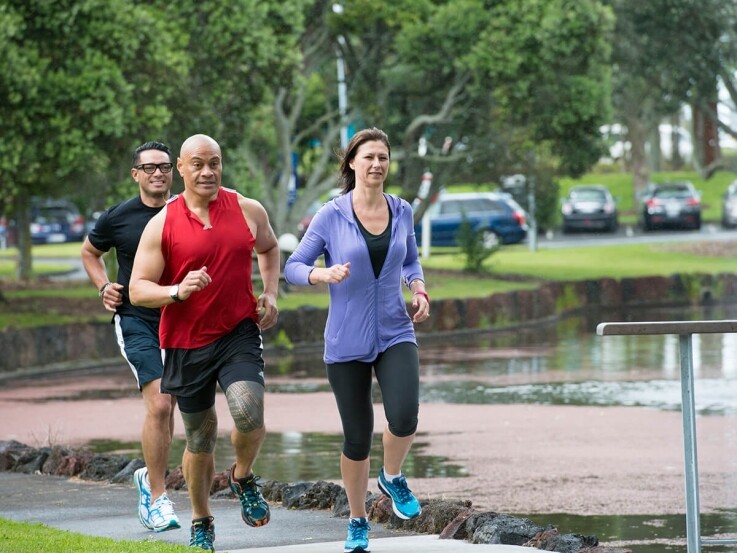
All of this evidence shows that while endurance training can improve other risk factors for heart attacks, it does not appear to reduce the buildup of plaque in your arteries. That is a job for your diet.
Runners: eat with your heart in mind
Heart attacks occur when plaques that build up in your arteries break off. This causes bleeding, which eventually leads to a blood clot that prevents blood flow to the heart. Exercise helps reduce your risk for heart attacks by making the plaque more stable (therefore less likely to break off), but your diet is what prevents plaques from forming in the first place.
As a runner, you burn a lot of calories during your training, so naturally, you’re going to eat more to fuel your activity level. If you replace the calories you lose with lots of sugar, too much meat, or other less-healthy choices, you are far more likely to have plaque build-up in your arteries.
To prevent or reduce the risk for plaque build-up, all runners should follow a heart-healthy diet that’s high in anti-inflammatory foods like fruits and vegetables, whole grains, legumes and nuts and other heart-healthy fats and oils. Here are a few examples of some heart-healthy foods runners can add to their grocery carts:
Black beans
Salmon and tuna
Olive oil
Walnuts and almonds
Edamame
Sweet potatoes
Oranges
Dark, leafy greens
Barley
Oats
Flaxseed
Yogurt
Cherries and blueberries
This doesn’t mean that runners can’t enjoy other foods like meat, sugar and refined carbohydrates, but remember to eat those foods in moderation to keep your heart healthy.
(03/18/2022) ⚡AMPby Running Magazine
What does your running shoe wear pattern tell you?
Wasn’t it Forrest Gump who said that there’s an awful lot you can tell about a person by their shoes? Your running shoes can tell a pretty good story of your running gait and how and where your body makes an impact with the ground. And your gait can tell you the areas of your body you need to work on to strengthen your stride. When buying a new pair of running shoes, your best bet is to read the outsole on your current pair to get an idea of what to look for in your next shoe.
The first step is to look at the wear pattern on a pair of your old running shoes; the more recently they’ve been used, the better (but they should be well used). Don’t use a pair that you walk in, as walking is a different motion to running and will create a different wear pattern, making it hard to get a good read on what’s going on with your gait.
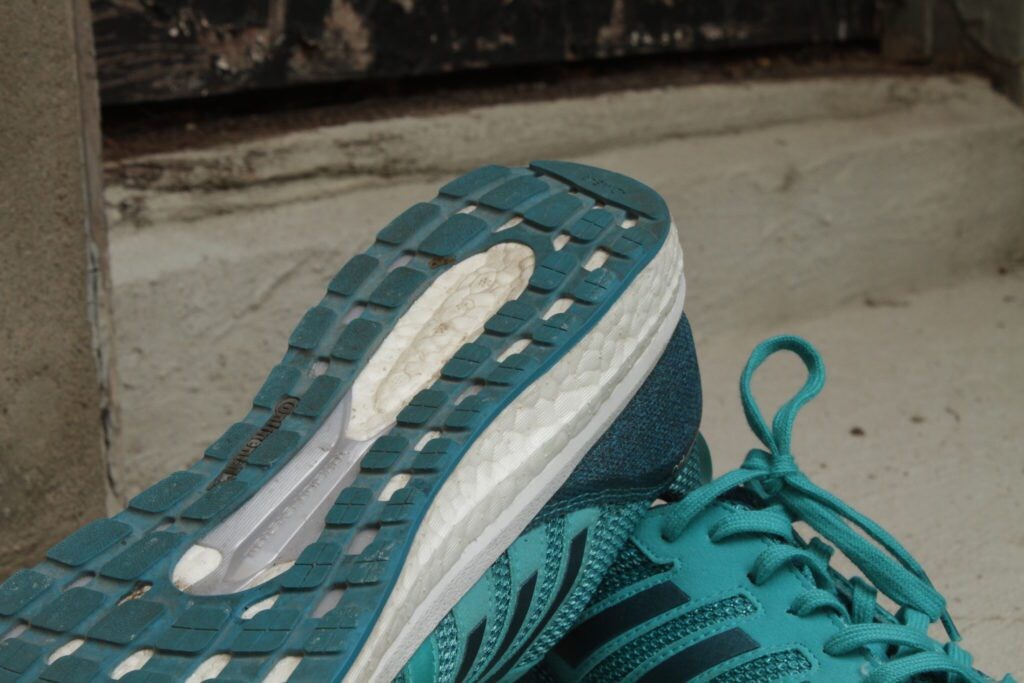
The heel-striker
If your shoes are completely worn down at the back of the heel, it’s a sign that you are overstriding (landing in front of your body). You may want to try a pair of shoes with a lower drop, without an elevated heel as a technique to help you stop over-striding, which can develop a more natural stride. Another way you can combat heel-striking is by not letting your elbows swing forward past your hips when running.
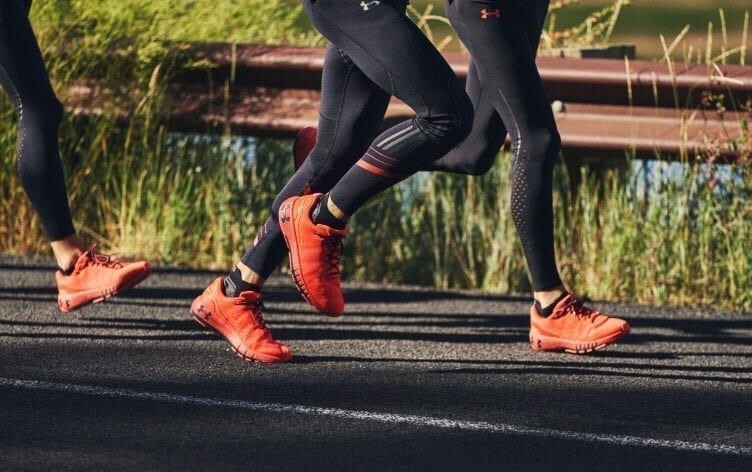
If there’s more wear on the inside (medial side) of your heel, you may want to consider a stability shoe that helps prevent overpronation. The opposite is supination, in which you’d see more wear on the outside heel. Most of the major running brands don’t make a specific shoe for supination but a majority of supinators wear a high cushioned shoe to absorb the impact of the ground.
The midfoot-striker
This is the most popular technique for runners. If there’s wear and tear right down the middle of the shoe, it’s usually a sign that you are wearing the right pair. A midfoot strike allows your body to absorb the impact better, equally distributing your body weight and allowing you to run more efficiently.
When buying a new pair, midfoot strikers have the luxury to stick with what they are wearing or to try a mid-to-lightweight shoe to optimize their speed on training runs.
The forefoot striker
A forefoot strike may seem efficient and fast, but it is the least common running foot strike as it’s unnatural for runners. If there’s tons of wear around the toe area, it’s a sign that you are a forefoot striker. This strike can be commonly described as running on your toes and is prone to cause tight calves or Achilles issues. Those who have a forefoot strike are recommended to wear shoes with a higher drop, which is the difference in millimeters between the heel and toe, to alleviate calf or Achilles pain.
Next time you are at your local running store, try on several pairs. Bring your old pair of shoes with you to give the salesperson an understanding of your stride, and a frame of reference for what you need in your next pair. Then buy the one that feels the most comfortable.
(03/18/2022) ⚡AMPby Marley Dickinson
Canadian Olympians Malindi Elmore and Natasha Wodak prepare for their first Boston Marathon
Two of Canada’s best marathoners are currently training together to tackle their first Boston Marathon. Malindi Elmore and Natasha Wodak hold the two fastest times ever run by Canadian women over the marathon.
They also are the top-ever placing Canadian women in that event in a non-boycotted Olympics, finishing 9th and 13th at last summer’s Games.
St. John's native Kate Bazeley, who made her World Marathon Majors debut three months ago in Chicago, is the other Canadian participant.

Placing 13th in two minutes 32.41 seconds went beyond Wodak's expectations for her Olympic marathon debut. The 40-year-old Vancouver resident spent "hours and hours" discussing a race plan with Elmore, 41, of Kelowna, B.C., who was confident the pair could finish inside the top eight. Elmore placed ninth in 2:30:59.
"To say I am excited to race the BOSTON MARATHON is an understatement! This field is absolutely LIT," Wodak said in a tweet. "Honoured to be on the start list with these incredible ladies. And so happy I get to do this with my pal Malindi Elmore."
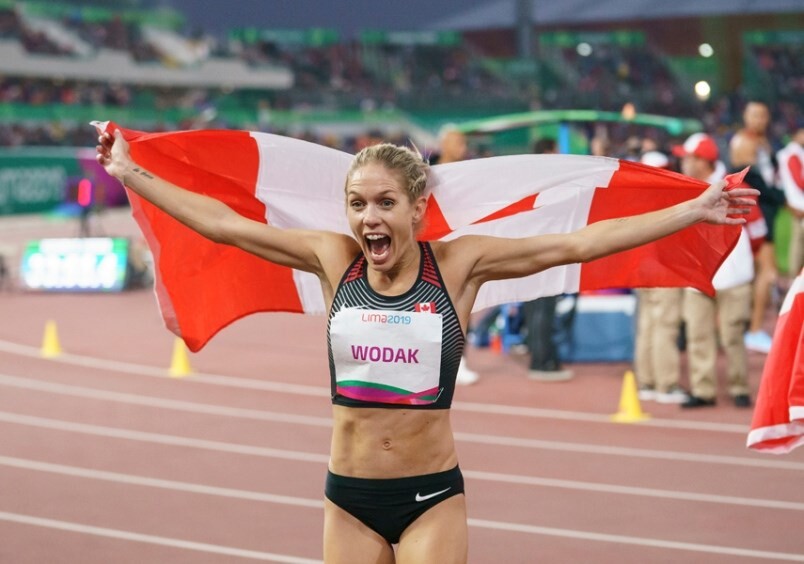
Bazeley, 37, placed 16th in the elite women's field in Chicago on Oct. 10 in 2:36.46, 11 seconds short of her personal-best time.
"Really excited to be included in this bonkers field! let's see how marathon training in the winter unfolds in Newfoundland," she tweeted Tuesday.
But even these pros need some advice to conquer their Boston debuts.
(03/18/2022) ⚡AMPby Kate Van Buskirk
Boston Marathon
Among the nation’s oldest athletic clubs, the B.A.A. was established in 1887, and, in 1896, more than half of the U.S. Olympic Team at the first modern games was composed of B.A.A. club members. The Olympic Games provided the inspiration for the first Boston Marathon, which culminated the B.A.A. Games on April 19, 1897. John J. McDermott emerged from a...
more...What is the purpose of recovery runs?
Recovery runs are perhaps the most misunderstood part of a runner’s training program. These relatively short, very easy-paced runs often get tossed aside as “junk miles,” but they are anything but. They may not be as exciting as an interval workout or as tiring as a long run, but these sessions play a key role in your training program and will make you a fitter, faster runner.
Recovery runs: not really for recovery
The term “recovery run” is a bit of a misnomer. Many runners and coaches talk about how these easy sessions increase blood flow to help clear lactic acid and other waste products from your legs that built up during your last workout, but this isn’t really true.

We know now that even after the hardest of workouts, it generally takes no more than an hour for your body’s lactic acid levels to return to normal. We also know that lactic acid isn’t really to blame for muscle fatigue, and that doing light activity won’t really help repair your muscles. In other words, recovery runs don’t actually do much to promote recovery.
5 reasons recovery runs are still important
So if recovery runs don’t really improve recovery, what’s the point? There are a number of reasons these shorter, easy sessions should have a place in your training plan, both from a performance and health perspective.
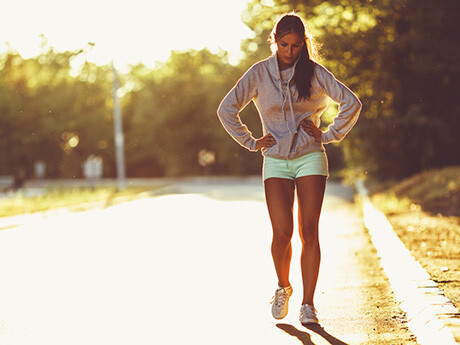
They improve your fitness
It may sound counter-intuitive, but recovery runs improve your fitness almost as much as your interval workouts, tempos and long runs do. How? By forcing you to run when your muscles are already tired.
Your biggest training adaptations happen when you’ve surpassed the point of initial fatigue — when you’re challenging your body to go beyond what it’s comfortable with. Ideally, you should do your recovery runs within 24 hours of your last hard workout or long run when you haven’t yet fully recovered so that you start your run in an already-fatigued state. This will allow you to force a greater amount of adaptation, without over-working your body, since you’re running at a very easy pace.
Recovery runs are also an opportunity to teach your body how to run in a fatigued state, which is crucial when you’re entering the final few kilometres of your goal race. The more you practice doing this, the more efficient your body will become at using energy in the future.
They improve your form
OK, so recovery runs themselves don’t improve your form, but their short and easy nature makes them the perfect time to practice good running form, since you don’t have to focus on other things like trying to hit specific paces. You don’t have to think about your form the entire time you’re running, but spending one minute every kilometre focussing on different aspects of your form, like your stride, your breathing or your arm carriage, can help you run more efficiently in your workouts later on.
If you truly want to take advantage of this aspect of a recovery run, make an appointment with a running-specific physiotherapist or other sports medicine practitioner to have a gait analysis done, so you know which parts of your form you should focus on the most, and how to do so safely and effectively.
They increase your weekly mileage
It’s important for runners to remember that it’s your overall training plan, not just specific workouts, that ultimately lead to improved performance. When you’re training for a longer event like a half-marathon or marathon, running enough weekly mileage is one of the most important factors for success. A recovery run is an opportunity to add to your weekly mileage without putting too much extra stress on your body since the volume and intensity are fairly low.
They improve your body’s ability to use fat
You have a nearly endless supply of energy available from fat, but in order to break down fat for fuel, you need oxygen. When you’re doing a recovery run at a pace that allows you to breathe easily (and get enough oxygen), your body is able to use fat as an energy source. Over time, your body will gradually become more efficient at using fat for fuel, which will be hugely beneficial during long races like half-marathons and marathons.
They improve your mental health
It’s no secret that running can help improve your mental health, but not all runs are created equal. Easy runs that don’t leave you exhausted at the end of them are arguably the most enjoyable and tend to have the greatest positive impacts in terms of stress relief and providing that sought-after “runner’s high.”
Recovery run mistakes
There’s no doubt recovery runs provide a lot of benefits, but many runners miss out on them because they don’t do these runs properly. Avoid making these mistakes if you want to maximize the positive effects of recovery runs:
Running too fast. You should be running slow enough that you can maintain a conversation, and shouldn’t be tired at the end of the run.
Running too far. The length of your recovery runs will be relative depending on the rest of your training, but again, they shouldn’t be so long that they induce fatigue.
Watch for hills. A very hilly route can turn an easy run into a challenging run if you’re not careful. If there are hills on your route, make sure you manage your effort on the ascent to avoid turning your run into a hill workout in disguise.
Take a break. If you’re feeling particularly beat up after a hard workout, consider swapping your easy run for a cross-training session. This way, you can still get the aerobic benefits while reducing the stress on your body, which will lower your risk for injuries.
(03/18/2022) ⚡AMPby Brittany Hambleton
Berlin champion Guye Adola and Hamburg winner Tsegaye Mekonnen are set to run in Hamburg
Former Hamburg winner Tsegaye Mekonnen and reigning Berlin Marathon champion Guye Adola are among the top runners for the Haspa Marathon Hamburg on 24th April. The two Ethiopians feature personal bests of sub 2:05 as do three other runners on the start list. Guye Adola heads this list with a time of 2:03:46. Organizers announced athletes of the men’s elite field today. The women’s race will feature the debut marathon of Ethiopia’s 10k world record holder Yalemzerf Yehualaw, which was announced a fortnight ago.
Organizers of the Haspa Marathon Hamburg expect a total of 20,000 runners including races at shorter distances on 24th April. Online entry is still possible at: www.haspa-marathon-hamburg.de
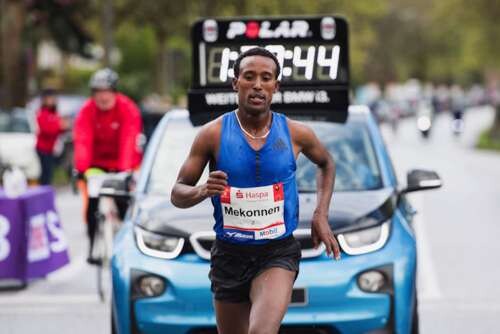
It was back in 2017 when Guye Adola ran a sensational marathon debut in Berlin. Clocking an unofficial world debut record of 2:03:46 which remains his PB he came surprisingly close to beating Kenya’s superstar Eliud Kipchoge. Adola was even leading the Olympic Champion until around 40 k before Kipchoge finally managed to overhaul him and win by just 14 seconds.
Injuries, health problems and Covid 19 restrictions stopped him from competing a couple of times in the past few years. However Guye Adola then came back to Berlin to beat Ethiopia’s superstar and pre-race favorite Kenenisa Bekele comfortably in September last year. In very warm conditions the 31 year-old clocked 2:05:45.
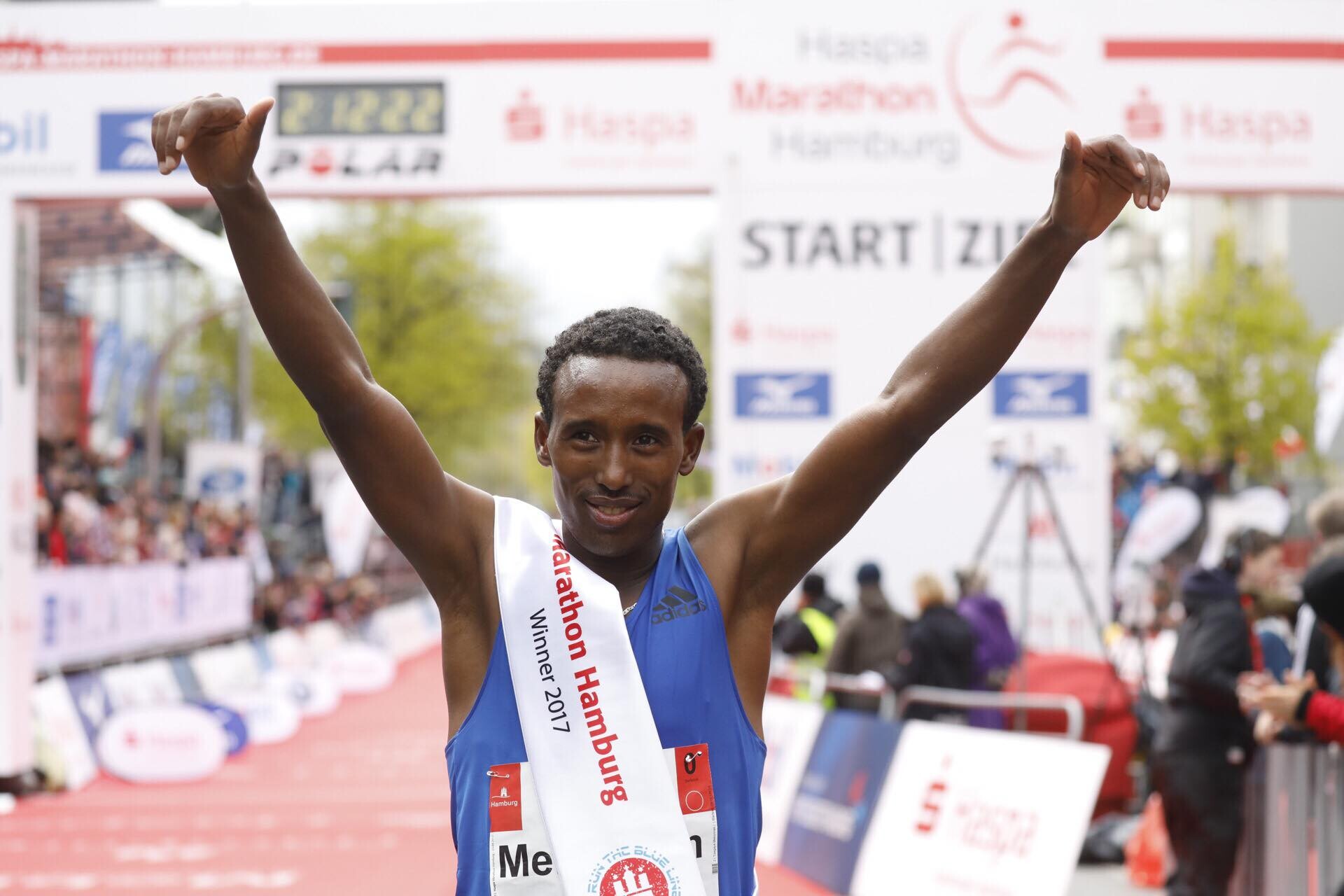
Having coped so well against the fastest marathon runners on the planet Guye Adola could be in a position to take away the course record from Eliud Kipchoge. The Kenyan won his debut race at the distance in Hamburg in 2013 and set the current mark of 2:05:30.
While Guye Adola has never raced in Hamburg Tsegaye Mekonnen is a former winner of the Haspa Marathon Hamburg. The 26 year-old clocked 2:07:26 in 2017 when he took the race, denying the 2012 Olympic Champion Stephen Kiprotich of Uganda by just five seconds. Tsegaye Mekonnen had made headlines before when he triumphed at the Dubai Marathon in 2014. As an 18 year-old he achieved a time of 2:04:32 which still stands as the unofficial world junior record today (World Athletics does not recognize junior records in the marathon).
There are four other runners on the start list of the Haspa Marathon Hamburg who have run faster than Kipchoge’s course record. Kinde Atanaw ran 2:03:51 when he took the Valencia Marathon in 2019 while fellow-Ethiopian Abebe Degefa was fourth in that race with 2:04:51. Barselius Kipyego of Kenya showed fine form last autumn when he ran 2:04:48 for fourth place in Paris. Eritrea’s Afewerki Berhane, who has a personal best of 2:05:22, is also going for Germany’s biggest spring marathon.
Among a number of debutants Stephen Kissa might be capable of a surprise. The Ugandan ran a very fast half marathon time of 58:56 in New Delhi in 2020.
More information about the Haspa Marathon Hamburg and online entry is available at: Haspa-Marathon-Hamburg.de.
(03/17/2022) ⚡AMPHaspa Marathon Hamburg
The HASPA MARATHON HAMBURG is Germany’s biggest spring marathon and since 1986 the first one to paint the blue line on the roads. Hamburcourse record is fast (2:05:30), the metropolitan city (1.8 million residents) lets the euphoric atmosphere spill over and carry you to the finish. Make this experience first hand and follow the Blue Line....
more...Marathon workout: the race simulation long run, Experienced marathoners can get more out of their long run with goal pace intervals to mimic the specific demands of race day
The long run is arguably the most important part of marathon training. While beginners will mostly use the weekly staple to slowly build up mileage so they can handle the marathon distance, more experienced marathoners will use a few of their long runs to simulate race day. By using your long run to practice your race pace and nutrition strategy, you can build confidence heading into race day.
How to simulate your race during your long run
There are a few factors to consider when using your long run to simulate race day. The first is pacing. The goal here is not to do your entire long run at your goal race pace (that would be overkill and likely lead to burnout before race day arrives), but instead to include some race-pace intervals during your run to mimic the feelings of late-race fatigue.
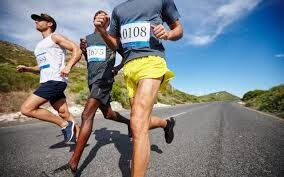
For example, an experienced marathoner could use the middle of their long run to run three to six kilometres at their goal race pace. Doing so once or twice (with five to 10 minutes of easy jogging in between) will give you practice both running at your goal pace and continuing to run afterward when you’re more fatigued. Alternatively, you could run intervals of two minutes at marathon pace followed by two minutes at easy run pace for six or eight kilometres in the middle of your run to achieve a similar effect.
The second factor to consider is nutrition. The long run is your opportunity to practice and perfect your nutrition strategy heading into race day, and when you combine this with race-pace intervals, you’ll get a much better idea of what works for you and what doesn’t.

Finally, depending on the marathon you’re preparing for, you may want to plan a route that simulates the course you’ll be running on. If your goal race has some rolling hills, for example, it’s a good idea to do your race simulation long run on similar terrain.
When should you do a race simulation long run?
It’s not necessary to turn every one of your long runs into a race simulation (and in fact, that is inadvisable). In the first several weeks of marathon training, all of your long runs should be done at an easy pace as you build up your mileage. Race simulation long runs are best saved for later in your training cycle, when your fitness level is higher.
You also shouldn’t do these every week, since they can be quite taxing. Once or twice in your training cycle is likely adequate to build your confidence and give you a good idea of where you’re at in terms of your readiness for race day. Additionally, on the weeks that you plan to do a race simulation, you may need to modify your other workouts (or eliminate one entirely) to give your body more recovery time.
Not for beginners
We said this already, but it’s worth bringing up again. If you’re training for your first marathon, you’re probably better off not doing this type of workout at all. When you’ve never done the marathon distance before, the long run is there to help you gradually build up your mileage so you can handle the distance on race day. Adapting to the increase in distance every week will already be hard enough work for your body, and it will likely do more harm than good to stress it even more by adding intervals into the mix.
If, however, it’s your third or fourth marathon and you’re looking for a way to give yourself an extra edge, the race simulation long run is the perfect way to prepare for the specific demands of race day.
(03/17/2022) ⚡AMPby Running Magazine
Acceptance and commitment therapy: mental flexibility training for runners, what's more important for runners — mental flexibility or mental toughness?
Acceptance and commitment therapy (ACT) has long been used to treat anxiety, depression and other stress-related mental health issues, but athletes are increasingly turning to the strategy to improve their mental performance in competitions. While mental toughness is often regarded as being necessary for athletic performance, ACT promotes mental flexibility instead, which many experts argue is more effective on game (or race) day.
Mental toughness vs. mental flexibility
The concept of mental toughness is fairly straightforward: having a strong mind means you can push through pain and adversity to accomplish a goal. Whether you’re fighting lactic acid buildup as you sprint to the finish line in a mile race, or you’re hitting the wall at kilometer 35 of a marathon, a mentally-tough runner will be able to get through the hard parts to still cross the finish line under their goal time.
As most runners know, this often isn’t the way things go. Even a very mentally tough runner will still have a race that won’t go to plan, whether that’s caused by factors that are within or outside of their control. Runners who have a high degree of mental toughness will still, at least sometimes, fall short of their goals.
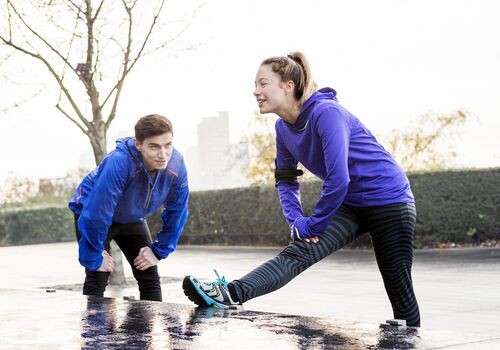
This often leaves runners frustrated, wondering why they couldn’t just “tough it out” or “push through the pain,” or even wondering if they were really as mentally tough as they thought they were. These thoughts can lead to a downward spiral of negative self-talk, potentially impacting future workouts and races.
Mental flexibility, just as it sounds, is a far less rigid way of thinking. Rather than trying to ignore your thoughts, feelings and emotions, it encourages you to stay in contact with the present moment by welcoming all sensations, both positive and negative, in order to continue to pursue your goal. These feelings, however, don’t control you. A mentally flexible runner does not allow their short-term emotions (like the negative thoughts that creep in during the last 10 kilometers of a marathon) to dictate how they choose to act.
Acceptance and commitment therapy

Mental flexibility has its roots in ACT, which encourages people to embrace their thoughts and feelings, rather than trying to fight them, ignore them or feel guilty about them. This is important for runners because let’s face it: things aren’t always going to go the way you planned.
In times of high stress or hardship (like the last mile of a 5K or the middle of a hard workout), it’s easy to believe our thoughts and emotions are facts, but they are really just a reflection of how we are feeling, not reality. By acknowledging negative thoughts and emotions during a tough workout or race, you can put yourself back in the driver’s seat, effectively removing the control they have over you.
For example, you’re part-way up a tough climb during a workout or race and you think to yourself “I’m not good at hills.” Your brain is telling you this because in the moment, running up that hill feels very hard. If you believe that thought as a fact, you’ll be more likely to stop trying or give up. ACT teaches you to address that negative thought and create some distance from it, which puts you back in control and helps you to keep going.
Stay present, and let your values guide you
So how do you improve your mental flexibility? Just like with physical training, mental training takes time, consistency and patience. For runners, there are two key ways you can use ACT to improve your mental performance:
Stay present. One of the hallmarks of race-day anxiety is the tendency to focus on the future. You’re feeling tired now, so how will you make it to the finish line later? The temperature is hotter than you expected, and what if you can’t handle the heat? Part of ACT is focusing on the moment you’re in and not worrying about what’s to come. In other words, tackle a race one kilometer at a time, instead of thinking about how much farther you have to go.
Be clear on your values. As runners, we tend to fixate heavily on our running goals, and while having goals is a good thing, they can sometimes cause us to lose focus on why we’re actually out running. Are you only on the startline because you want to run a new PB, or is it really because you want to challenge yourself, be a part of something bigger than you or have a great experience?
Your values are the foundation of your goals, but are far less rigid. Focusing on those values will help you redirect your mind when your performance goals go sideways and allow you to put your result into perspective. Doing so will not only decrease your pre-race anxiety and help you enjoy the experience more, but it will prevent one bad workout or race from affecting future performances.
The bottom line
All of us will have moments during runs, workouts and races when things get hard and negative thoughts begin to cloud our brains. Being mentally flexible will help you to acknowledge those thoughts and emotions (rather than trying to ignore them) without allowing them to take over. This will reduce your anxiety and ultimately help you perform better.
(03/17/2022) ⚡AMPby Brittany Hambleton
ADNOC Abu Dhabi Marathon returns in December
Race organizers Abu Dhabi Sports Council (ADSC) and Abu Dhabi National Oil Company (ADNOC), today announced that the ADNOC Abu Dhabi Marathon will take place on December 17, 2022. ADSC is also delighted to confirm that ADNOC will continue to be the Official Title Sponsor and Energy partner of the flagship event for the next three editions.
Building on the success of the 2021 race, which attracted over 12,000 runners alongside a highly competitive elite field, ADSC and ADNOC have committed to grow event participation locally by supporting and inspiring new and existing runners, with the long-term goal of doubling the size of the UAE’s running community by 2025.

Running events
This new approach will focus on creating a culture of participation and inclusivity, providing the community with more running events and opportunities throughout the year.

Speaking at the Leaders Sport Business Summit in Abu Dhabi, Aref Al Awani, General Secretary of Abu Dhabi Sports Council, said, “We are pleased to announce our strategic partnership with the Abu Dhabi National Oil Company (ADNOC) and looking forward to our distinguished partnership to continue supporting the success of the ADNOC Abu Dhabi Marathon. The Abu Dhabi Marathon has risen to a global level and has become one of the important sporting events inspiring platforms for awareness, education and consolidation of the importance of sport in the daily life of our people and residents. Last year’s elite race saw fierce competition from an incredible field of international talent. This year, we look forward to welcoming the stars of the sport back to Abu Dhabi and reinforcing the capital’s status as a world-class sporting destination.”
ADNOC’s Group Human Capital Director, Dr. Saif Al Nasseri said, “We are extremely proud to renew our partnership with Abu Dhabi Sports Council. As we look to build on the success of the past three races, we are committed to making the marathon accessible to a wider audience, providing support and training to runners of all abilities and encouraging our community to start their health and wellness journey with us.”
Training sessions
Working in partnership, ADSC and ADNOC will deliver a series of community initiatives, including a year-round calendar of official training sessions, workshops and year-round race preparation events, providing a structured program that caters for all levels, from first time fun runners to competitive athletes.
In addition, the ADNOC Abu Dhabi Marathon runner and spectator experience will be further enhanced, with active community consultation helping to shape every aspect of the race weekend, to ensure it retains its status as one of the region’s leading marathons and the largest and most inclusive mass participation event in the UAE.
Registrations for all event distances are now open for the fourth edition of the ADNOC Abu Dhabi Marathon.
(03/17/2022) ⚡AMPADNOC Abu Dhabi Marathon
The Abu Dhabi Marathon is shaping up to being first class marathon for both elite runners and average runners as well. Take in the finest aspects of Abu Dhabi's heritage, modern landmarks and the waters of the Arabian Gulf, at this world-class athletics event, set against the backdrop of the Capital's stunning architecture.The race offered runners of all abilities the...
more...2022 Lewa Marathon goes in-person after two-year hiatus
Athletes and fans from Kenya and beyond can look forward to a fun-filled June after the planned return of the Lewa Marathon.
The 23-year-old race, which has been held virtually for the past two years due to the Covid-19 pandemic, will be staged on June 25 at the Lewa Wildlife Conservancy.

Chief executive officer of the conservancy, Mike Watson, expects the event to be action-packed and to intensify its efforts towards the fight against climate change.
"While still providing an exciting and exhilarating marathon experience, the Lewa Safari Marathon 2022 aims to be the most environmentally friendly event Lewa has hosted to date,” Watson said.

He described the marathon as an example of the role sports can play in enhancing environmental change.
"This drive is inspired by the urgent need to reduce our carbon footprint, which aligns with our ethos and standards as we strive to be a model for biodiversity and ecosystem preservation," he said.
Watson was speaking during the launch of the annual marathon, which will be sponsored by various institutions, including Safaricom, Huawei, Kenya Breweries Limited, and Tetra Pak.
Speaking at the same event, Safaricom CEO Peter Ndegwa echoed Watson's comments, saying sports has the ability to transform people's lives for the better.
"The Lewa Safari Marathon brings together three things that we really care about as a company; Sports, Community, and Conservation. We remain committed to supporting the marathon because we have seen how it continues to transform lives and that speaks to the essence of our purpose,” Ndegwa said.
Huawei's deputy CEO for public affairs, Fiona Pan, said: "Environmental sustainability is a key pillar of Huawei’s sustainability strategy and that is why this marathon is and continues to be a key activity that we support together with our partner Safaricom.”
(03/16/2022) ⚡AMPby Omondi Onyatta
Team Kenya coach Janeth Jepkosgei hopeful of Kenya's chances in World Indoor event
Team Kenya coach Janeth Jepkosgei is confident that her young charges will win some medals for the country at the World Athletics Indoor Championships starting Friday at Štark Arena, Belgrade, Serbia.
The 38-year-old, who last competed for Kenya at the 2015 World Championships in Beijing, said that though she can’t predict the type of the medal they will get, something nice will come from the Balkans.
Jepkosgei is in a team of 10 athletes and six officials that was to left at 11.55pm on Tuesday aboard an Emirates flight for the three-day championships.

“You can tell from their body language in training that they are hungry for results. They are simply happy free souls,” said Jepkosgei, the 2007 World 800m champion and 2008 Beijing Olympics 800m silver medallist.
Though a different experience virtually for all the members, this being an indoor championship event, Jepkosgei said that she has instilled the essence of being courageous and tough at that particular stage.
“They need not to be scared and should fight to the finishing tape,” said Jepkosgei, who described her team as Kenya’s future stars.

“I have told them that they have a long and bright future ahead, hence being in the team should motivate them. They deserve to represent Kenya, “explained Jepkosgei, who is indebted to Athletics Kenya for giving her a chance to handle the national team for the first time.
“This is another responsibility and stage in my athletics career after having hang up my spikes from competitive running back in 2015. I am happy but I am in the process of learning,” said Jepkosgei.
Kenya only won one medal- bronze by Bethwell Birgen in men’s 3,000m-from the last 2018 World Athletics Indoor Championships in Birmingham, United Kingdom.
The last time Kenya won gold in the men’s event was in 2014 in Sopot, Poland where Caleb Mwangangi reigned supreme in the 3,000m.
Hellen Obiri (3,000m) and Pamela Jelimo (800m) won last for the country in 2012 Istanbul, Turkey.
Team captain and Africa’s 100m record holder, Ferdinand Omanyala and his teammates have promised a good show with the sprinter targeting a sub 6.57 seconds in the men’s 60m.
The 2018 World Under-20 5,000m champion Beatrice Chebet is eyeing a podium place in the women’s 3,000m alongside Collins Kipruto in the men’s 800m.
Kipruto will partner with World Under-20 800m bronze medallist Noah Kibet in the 800m event.
Chebet, 22, said she is eager to emulate Obiri on her maiden major tour as a senior in the women’s 3,000m where she will team up with prodigy Edinah Jebitok.
Jebitok, who competed at the 2020 Tokyo Olympic Games, will also double up in the 1,500m.
World Relay 2x2x400m silver medalist Naomi Korir makes the women’s 800m team that also has Eglay Nalianya.
Abel Kipsang, who represented Kenya at the 2020 Tokyo Olympics, is a lone ranger in men’s 1,500m, while Jacob Kiprop and Daniel Simiu will battle in the men's 3,000m.
(03/16/2022) ⚡AMPby Ayumba Ayodi
World Athletics Indoor Championships Glagow 24
Welcome or fáilte as the Gaelic speakers in Scotland would say, to the digital home of the 19th edition of the World Athletics Indoor Championships taking place in Glasgow in 2024. With the competition fast approaching it’s nearly time to take your seat for one of the hottest sporting tickets in Scotland this year. Glasgow has a proven track record...
more...Peter Wanyoike and Catherine Njihia are the March 2022 Kenyan Athletics Training Academy (KATA) 10K Time Trial champions with individual personal records
Peter Wanyoike edged out 42-year-old Peterson Wachira from Nyahururu during the 10k time trial held in Thika Kenya on Wednesday morning (March 16) on the newly upgraded Bob Harris Road. He completed the course in 29:57.8 after covering the first 5Km in a slow 15:40.5 while Peterson finished in 30:06.0 which is a 95.79% age-graded.
The monthly time-trial, the 7th since Kenyan Athletics Training Academy was officially opened in September last year, saw most KATA athletes post their Personal Bests with third-place finisher Zakariah Kirika and women champion Catherine Nikihia maintaining remarkable consistency.

Zakariah clocked 30:25.7, bettering his previous 30:41.9 while Catherine, the winner of the women category clocking 35:35.2. Her December time on the same course was 36:54.1.
Others with positive results included Peter Mburuwho clocking 30:43.5 from December’s 31:28.2, Paul Ng’ang’a 34:01.7, improving his 34:31.9 and Alfred Kamande who timed 34:41.4. Alfred did 35:16.5 in December.
60-year-old KATA athlete Charles Ndirangu clocked 38:08 which is 87.54% age-graded.
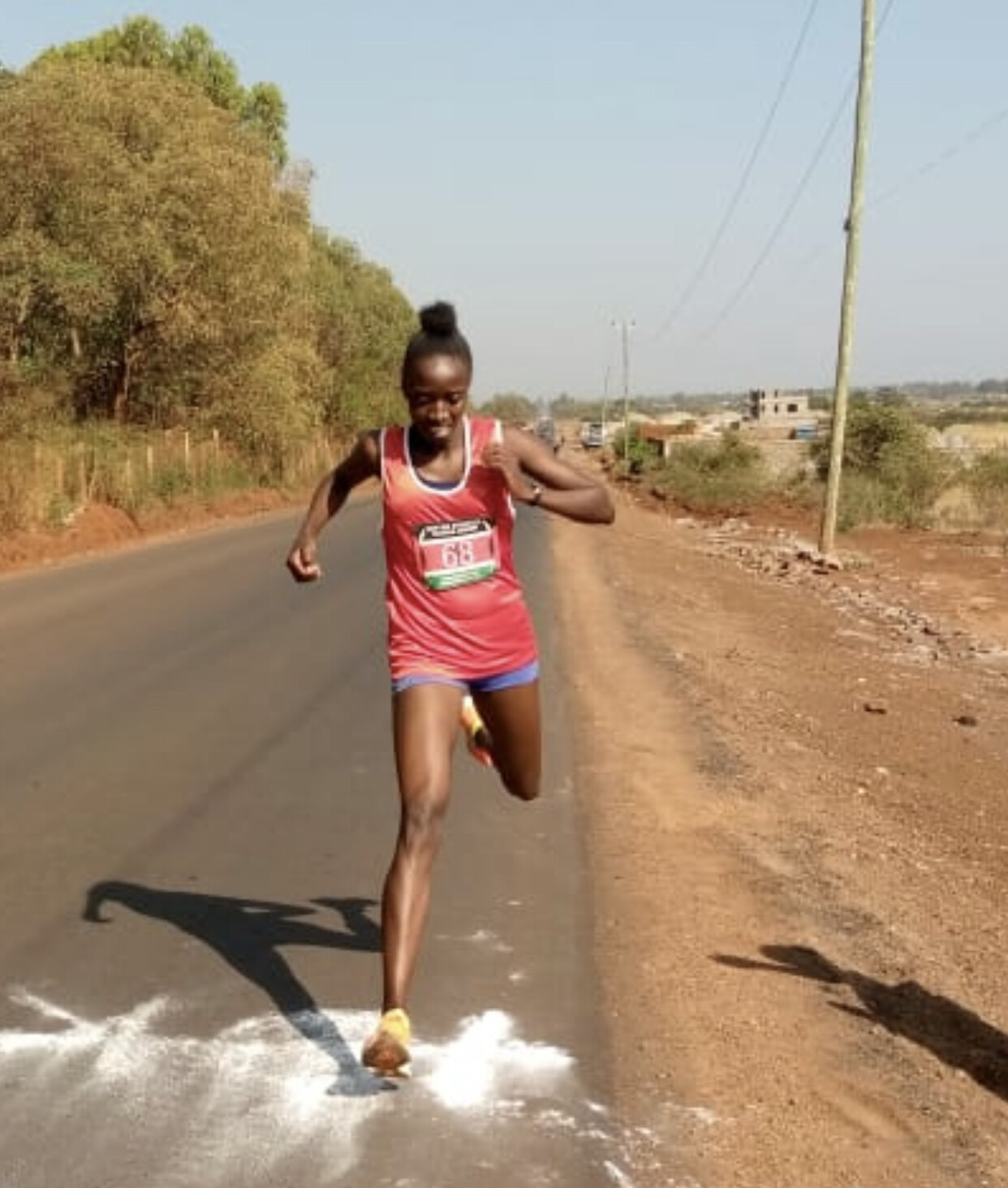
With Athletics Kenya lining up a lot of activities in April, the KATA 10k Time Trial 8th edition is slated for 20th.
"We welcome runners to our next event in Thika, Kenya," says director Bob Anderson. "We do not charge an entry fee and there is no prize money. What we offer is an official 10k time. Times are published on our sponsor My Best Runs website."
Place, name, time, bib number and age.
1.Peter Wanyoike M 29:57.8 (210) Age 262. Peterson Wachira M 30:06.0 (216) Age 423. Zakariah Kirika M 30:25.7 (213) 214. Peter Mburu M 30:43.5 (211) 265. Peter King’ori M 31:38.7 (218) 256. Eston Mugo M 31:45.3 (220) 297. Erick Cheruiyot M 32:10.5 (214) 278. Raphael Gacheru M 32:48.3 (225) 239. Christian Muthini M 33:00.4 (234) 2910. Paul Ng’ang’a M 34:01.7 (224) age 4211. Alfred Kamande M 34:41.4 (217) age 2412. Samuel Chege M 34:59.4 (236) age 2513. Nicholas Kitundu M 35:19.6 (233) age 2214. Catherine Njihia F 35:35.2 (68) age 2315. Levis Kuria M 35:38.8 (231) age 2116. John Mwangi M 36:24.0 (235) age 4017. Solomon Njenga M 37:04.6 (232) age 3818. Lamech Cheleket M 37:32.1 (228) age 2319. Samuel Kamau M 38:01.7 (73) age 2720. Charles Ndirangu M 38:08.6 (237) age 60
Karren Chepkemoi F 20:37.9 (5KM) 69 age 21
Erick Mutuku M 15:05.8 (5KM) 229 age 20
(03/16/2022) ⚡AMP
KATA Time Trial Series
The Kenyan Athletics Training Academy (KATA) in Thika Kenya stages a monthly time trial. Starting Sept 2021 this monthly event is open to anyone who would like to get an official time on a acurant course. Results will be published at My Best Runs so race directors and other interested people can see what kind of shape our participants are...
more...Achilles problems? Try the Alfredson protocol, this series of exercises will strengthen your Achilles tendon to get you back on the road after an injury
Achilles problems plague many runners, and injuries like Achilles tendonitis or Achilles tendinopathy can be frustratingly difficult to get rid of. The Alfredson protocol is commonly prescribed by physiotherapists to help heal and strengthen the injury-prone tendon, and should become a regular part of your strength training routine if you’re prone to Achilles problems.
Can you strengthen your Achilles?

The Achilles is a tendon, not a muscle, and has very little blood supply, which led many researchers in the past to believe that you couldn’t train them. This was distressing news to a lot of runners, especially those who suffer from frequent Achilles problems. After all, if you can’t train your Achilles, how can you heal it, or prevent it from becoming injured again in the future?
On top of that, your Achilles also impacts performance. If your tendon is longer and stiffer, it can store more energy, which is then released when you push off the ground with your toe. This makes you a more efficient and powerful runner. If you have a weak Achilles tendon but can’t train it, does this mean you’ll always be at a disadvantage?
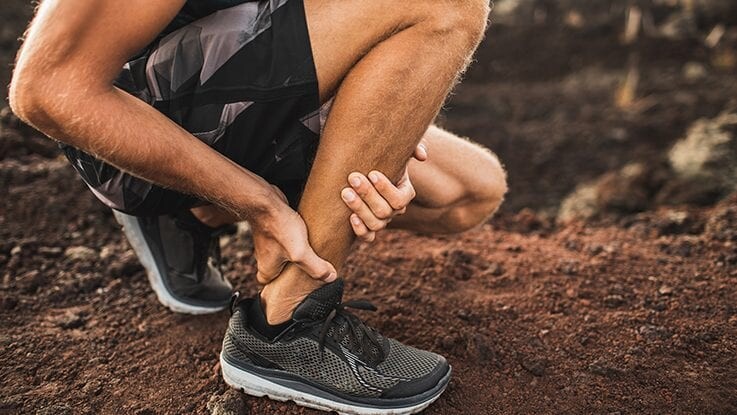
The good news is, more recent research is showing that you can, in fact, train your Achilles tendon (take a look at this study in twins, which showed the Achilles tendon getting stronger after regular exercise). The bad news is that researchers and experts have not yet come to an agreement about how to train the Achilles effectively.
The Alfredson protocol
One thing that is widely supported by physiotherapists, however, is the Alfredson protocol. The Achilles is slow to adapt, so the program requires a minimum of 12 weeks to complete, and some runners may need to go even longer, depending on the condition of their Achilles when they started. Runners should do three sets of 15 repetitions for each exercise, twice daily, to achieve the best results. It’s important to note that if you have recently injured your Achilles, this protocol might be too intense right off the bat. Make sure you see a physiotherapist first, who can help you gradually build up your strength.
Follow these steps to perform the Alfredson protocol:
1.- Stand on the edge of a small step on the balls of your feet so that your heels are hanging over the edge, holding onto a railing or wall for balance.
2.- With your knees straight, lift your heels and rise up onto the balls of your feet.
3.- Leaving the foot of the injured/painful Achilles on the step, lift your other foot a couple of inches into the air.
4.- Slowly drop the heel of your injured Achilles toward the ground, keeping the ball of your foot planted firmly on the edge of the step.
5.- Return your non-injured foot to the step and repeat the process again.
Once you’ve done three sets of 15 repetitions, repeat the entire process, with your knees slightly bent.
Some soreness or pain is acceptable when performing these exercises, but it shouldn’t be debilitating. Always listen to your body, and talk to your physiotherapist if you’re not sure if/when you should stop.
(03/16/2022) ⚡AMPby Brittany Hambleton
1500m world record Gudaf Tsegay sets sights on first global title in Belgrade
The past six winners of the women’s world indoor 1500m title have all either been Ethiopian or Ethiopian-born: Genzebe Dibaba (2018 and 2012), naturalised Netherlander Sifan Hissan (2016) and Swede Abeba Aregawi (2014), Kalkidan Gezahegne (2010) and Gelete Burka (2008). The sequence is unlikely to be broken in Belgrade.
In physical terms, Gudaf Tsegay might be only 1.63m (5ft 4in) tall but metaphorically the 25-year-old stands head and shoulders above the rest of the 22-strong entry list. In February last year she relieved Dibaba of the world indoor record with her sensational 3:53.09 run in Lievin and, 13 months on, the form book suggests that the clear world leader will succeed her compatriot as world indoor champion.

Tsegay ran a scorching 3:54.77 in Torun on February 22, the second fastest in history, and 3:57.38 in Madrid on March 2. Nobody else has cracked four minutes indoors in 2022. The next quickest is also Ethiopian. Axumawit Embaye, who won in Karlsruhe in 4:02.12, finished second to Aregawi in Sopot in 2014 and fourth in Portland in 2016 – behind Hassan and Ethiopian team-mates Dawit Seyaum and Tsegay.
Tsegay has won all nine races she has contested at all distances in the past three indoor seasons. Her last indoor defeat dates back to February 8, 2019, when she finished fourth over 3000m in Madrid.

She has not lost a 1500m race indoors or outdoors since the 2019 World Championships final in Doha, when she finished third behind Hassan and Kenya’s Faith Kipyegon. Her last indoor defeat at the distance was on 10 February 2018, when she placed third at the World Indoor Tour event in Boston.
Even when she fell on the opening lap of the mile race at this year’s Lievin meeting in February, she picked herself up, resisted a mid-race challenge from Embaye, and proceeded to win comfortably in 4:21.72, breaking the 20-year-old meeting record.
Tsegay is on a run of three global bronzes, having finished third in the 2016 world indoor 1500m final, the 2019 world outdoor final in Doha and in the 5000m final at the Tokyo Olympics last year. Barring unforeseen disaster, the 2014 world U20 silver medallist’s long pursuit of a Midas touch seems destined to finally meet with a golden global success in Belgrade.
Heather Maclean could be a danger in a tactical affair, having gone from fifth to first with a 29.71-second last lap at the US Indoor Championships. Josette Norris, who finished second in that race, has also displayed great form this year.
Other potential podium placers include Ethiopia’s 2019 African Games 800m champion Hirut Meshesha, who was second in Karlsruhe in 4:02.22, and Uganda’s Winnie Nanyondo. Fourth in the 800m at the 2019 World Championships, Nanyondo improved her Ugandan indoor 1500m record to 4:03.54 in Torun.
(03/16/2022) ⚡AMPby World Athletics
World Athletics Indoor Championships Glagow 24
Welcome or fáilte as the Gaelic speakers in Scotland would say, to the digital home of the 19th edition of the World Athletics Indoor Championships taking place in Glasgow in 2024. With the competition fast approaching it’s nearly time to take your seat for one of the hottest sporting tickets in Scotland this year. Glasgow has a proven track record...
more...Your final meal the night before a marathon can have a big impact on how you perform the next day, here's how to get that meal right
Nutrition is important no matter what distance you’re running, but what you eat the night before a marathon can have a significant impact on your performance the next day. Follow these guidelines to ensure your last supper helps, rather than hinders, your performance on race day.
Why is the night before so important?
When you’re running shorter distances, like a 5K, 10K or even a half-marathon, as long as you maintain a healthy balance of carbs, fats and proteins in your meals, you’ll be well-fuelled come race day. The marathon, however, is a different beast. During events that last longer than three hours, you will eventually deplete your glycogen stores, a phenomenon called “bonking” or “hitting the wall” that usually occurs sometime after the 30K mark.
Of course, fuelling during your race is necessary to prevent that from happening, but starting the race with topped-up glycogen stores is also just as important and necessary. For this reason, in the days leading up to your race, you should shift your daily energy intake from being made up of about 50 per cent carbohydrates to 75 per cent, particularly in the final two days of your taper.

While your carb-loading needs to start several days in advance of your race, the meal you eat the night before is important because it is your last opportunity to fuel yourself before you get to the start line. Yes, you’ll eat breakfast in the morning, but since it takes around six to seven hours to fully digest your food, that meal won’t actually benefit your race all that much (although it can harm it, but that’s another topic for another day).
Pre-race fuelling considerations
As we mentioned before, in the last few days before your race, 70 to 75 per cent of your energy intake should come from carbohydrates. It’s important to note that this doesn’t necessarily mean eating more. A normal diet would consist of about 50 to 60 per cent carbohydrates, 10-20 per cent fat and the remainder of your energy needs coming from protein, and by increasing your carbohydrate intake, you should decrease your energy intake from fat and protein slightly.
The reason for this is that both fat and protein can be more difficult for your body to digest, so eating large amounts of either nutrient in the last one or two days before your race could result in stomach problems when you start running. In your final meal the night before the race, avoid a high-fat or high-protein meal to ensure your body will be able to have your food fully digested by the next day.

Fibre is another factor you should watch out for. When you’re trying to consume larger amounts of carbohydrates, it’s easy to accidentally go overboard with your fibre intake eating brown rice, whole wheat bread and other whole-grain items, which can also be hard on your gastrointestinal system. In the days leading up to your race, and particularly the night before, you may want to substitute some of your whole-grain options for refined varieties instead.
How to eat the night before the race
Keep the following guidelines in mind when planning what you’re going to eat the night before your marathon:
Make sure three-quarters of your plate is filled with carbohydrates (think rice, pasta, potatoes, oats, etc.)
Eat to satisfaction, but don’t stuff yourself (you don’t want food still sitting in your stomach the next morning)
Stick with familiar foods that you know agree with your system.
Avoid raw or rare foods — save the sushi for after your race.
Choose refined carbohydrates, like white rice, pasta and bread, and avoid high-fibre foods like whole grains, beans and legumes.
Eat a high-carbohydrate bedtime snack, like a small bowl of oatmeal or granola.
Pre-race dinner suggestions
If you’re not sure what to cook the night before your race, here are a few quick suggestions to give you inspiration:
White rice with salmon or chicken and asparagus.
Chicken, white or sweet potatoes and wilted spinach.
White pasta dressed with olive oil and a sprinkling of parmesan chees (a little goes a long way), with roasted zucchini and chicken or firm tofu.
(03/15/2022) ⚡AMPby Brittany Hambleton
Japan’s Mariko Yugeta, 63, runs two sub-3:05 marathons in seven days, after running 3:04 in Tokyo, she followed it up with a 2:58 in Nagoya
The first 60+ woman to ever break three hours for a marathon, Japan’s Mariko Yugeta, added a new feat to her previous world record. A week ago, Yugeta won in the 60+ category at the Tokyo Marathon with a 3:04:16, and a week after that, she bettered her time by almost six minutes, running a 2:58:40 at the Nagoya Women’s Marathon.
Yugeta, 63, ran Tokyo and Nagoya as a fitness test for April’s Boston Marathon, where she hopes to lower her world record time of 2:52:13. Through 2021, she ran into some injury problems, which kept her out of the Osaka International Women’s Marathon in January.
The force that has driven her motivation for over 40 years is regret. When Yugeta was 21, she was mesmerized by the finishers at the 1979 Tokyo International Women’s Marathon. She spent the next three years training, making her marathon debut in 1982 in Tokyo, where she finished nine minutes over her goal of sub-3:00.
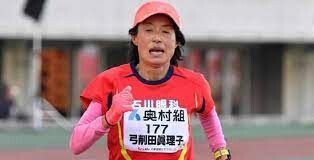
Since then, Yugeta has had unfinished business. A sub-3 marathon became her lifelong goal, and she finally achieved it at the Tokyo Marathon in 2017 (2:58:17), when she was 59.
When you put her personal best time into an age grade calculator, it comes out to 2:14:03, one second faster than the current women’s marathon world record held by Kenya’s Brigid Kosgei.
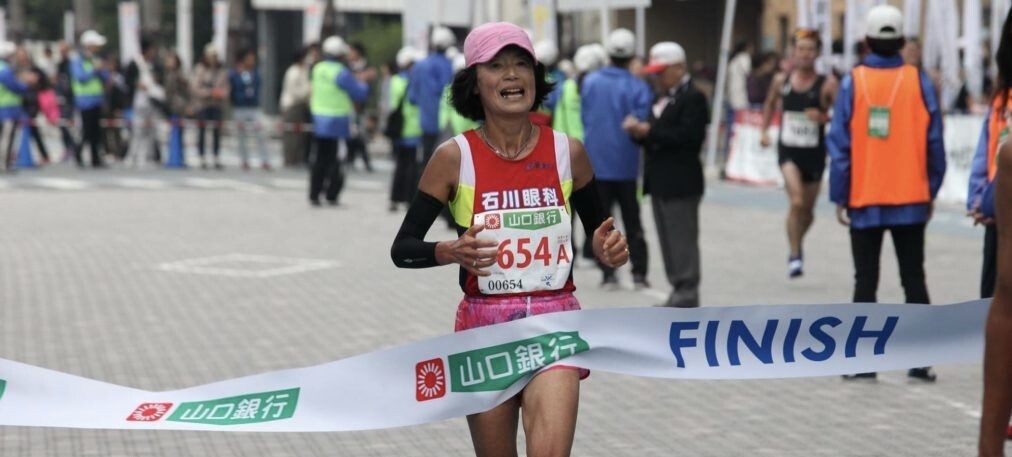
Yugeta’s achievements bring to mind the 1984 U.S. Olympic gold-medal-winning marathoner Joan Benoit-Samuelson, who is the only woman ever to run a sub-three marathon in five consecutive decades. (Benoit has not yet run one in the 2020s.)
In a 2021 interview with Maurten, Yugeta said she doesn’t really think about her age when she runs. She aspires to run sub-4:00/km this April in Boston, to become the first woman 60+ to run a marathon under 2:50. She currently teaches high school phys-ed and trains alongside her 16- and 17-year-old high school students.
(03/15/2022) ⚡AMPby Marley Dickinson
Global 1500m champions Jakob Ingebrigtsen and Samuel Tefera ready to clash in Belgrade
Two global champions are on a collision course in the men’s 1500m at the World Athletics Indoor Championships Belgrade 22, with Olympic gold medallist Jakob Ingebrigtsen of Norway looking to depose Ethiopia’s Samuel Tefera as the world indoor champion.
Based on their recent clash in Lievin, where Ingebrigtsen broke Tefera’s world indoor 1500m record, clocking 3:30.60, the pressure and expectation will rest with the 21-year-old Norwegian. That Lievin race was Ingebrigtsen’s sole outing of the indoor season, and he looked majestic as he bounded away from Tefera over the final 300 metres after the pacemaker stepped aside.

A championship final, of course, will present a very different challenge, but Ingebrigtsen showed in Tokyo and at last year’s European Indoor Championships that he has the tactical nous to go with his physical gifts. With his long-time rival Timothy Cheruiyot bypassing the indoor season, he will likely have to do his own pace-making if he wants a fast final, the kind of race in which he has become nigh-on unbeatable.
Tefera, however, will not go down without a considerable fight, and the 22-year-old Ethiopian gave Ingebrigtsen a much better race in Lievin than the three-second margin of victory suggested.

Perhaps Ingebrigtsen’s biggest challenger, though, will be Kenya’s Abel Kipsang. He finished fourth in the Olympic final last year and showed impressive indoor credentials when taking victory in Birmingham last month in 3:34.57. A recent 1:45.84 clocking for 800m outdoors in Nairobi signals he’s got the speed to be a threat here.
The British challenge will be led by Neil Gourley, who clocked 3:35.32 in Boston last month and who was runner-up in a slow 1500m final at the British Indoor Championships. He will be joined by George Mills, who impressed in Birmingham last month when clocking a PB of 3:36.03 against a world-class field.
Another athlete keen to see a fast final will be Oliver Hoare, the Australian who clocked a 3:50.83 mile to win at the Millrose Games in New York in January. In that race he powered away from Olympic bronze medallist Josh Kerr, showing the kind of closing speed and strength that will make him dangerous, particularly in a fast race.
Spain’s Ignacio Fontes, like Hoare, was an Olympic finalist last year and he booked his place here with a runner-up finish behind Adel Mechaal at the Spanish Indoor Championships, with Mechaal later electing to focus on the 3000m in Belgrade.
Germany’s Robert Farken is another who’ll have high expectations after the 24-year-old lowered his PB to 3:35.44 in Birmingham last month, while Ethiopia’s Teddese Lemi clocked an indoor PB of 3:35.84 last month and has 1:44 800m speed – which should prove useful in this realm.
Ireland’s Andrew Coscoran will be hoping to reproduce the form that saw him take victory in Staten Island last month with a 3:53.64 mile, where he was followed in third place by compatriot Luke McCann, who will join him in Belgrade.
The US charge will be led by Josh Thompson and Sam Prakel, who finished second and fourth respectively at their national championships.
(03/15/2022) ⚡AMPby World Athletics
World Athletics Indoor Championships Glagow 24
Welcome or fáilte as the Gaelic speakers in Scotland would say, to the digital home of the 19th edition of the World Athletics Indoor Championships taking place in Glasgow in 2024. With the competition fast approaching it’s nearly time to take your seat for one of the hottest sporting tickets in Scotland this year. Glasgow has a proven track record...
more...The Fukuoka Marathon will return in a revamped form this year
On Mar. 14 the JAAF, Fukuoka Athletics Association and Fukuoka Prefectural Government announced that the Fukuoka International Marathon, discontinued after its 75th running last year, will return in a revamped form this year on Dec. 4 under the tentative name "Fukuoka International Marathon 2022." The new version of the race will inherit the history and tradition on which the curtain came down so shockingly last December.
The Fukuoka International Marathon began in Kumamoto in 1947 as the "Kanakuri Prize Asahi Marathon" in honor of the father of Japanese distance running, Shizo Kanakuri.
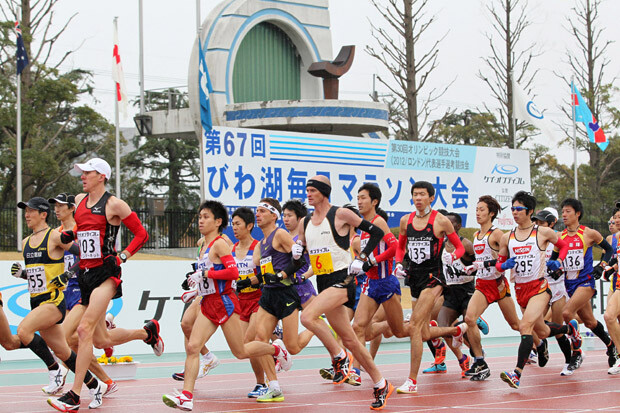
In its early years it was held in different cities across the country, first coming to Fukuoka in 1951 and settling there for good in 1964. It took the name Fukuoka International Marathon at its 28th running in 1974, and with numerous course changes over the years continued to be held under that name.
Most of the world's best runners competed there, and in the 1970s and 1980s its high-level races were so exciting that it was known as the best marathon in the world. World Athletics selected the Fukuoka International Marathon to receive its Heritage Plaque, making it effectively a World Heritage Site of the sport.
But in March last year it was decided to discontinue the race after its 75th running on Dec. 5 that year, with economic issues and declining interest cited as reasons for the decision.

The news of the cancelation was greeted with widespread shock and dismay. In light of the reaction, the prefectural government and the two athletics federations met to discuss possibilities for bringing the race back.
The statement issued today read, "As a result of exploring ways to preserve the history and value of the race, we have created a new race management organization and reached an agreement with the Kyushu Asahi Broadcasting Co., Ltd to handle to brunt of broadcasting duties. Under this arrangement it will be possible to go ahead with the new version of the race."
JAAF head Mitsugi Ogata said, "I am very happy that we will be able to stage this race in a new form while maintaining its history and tradition." Fukuoka governor Seitaro Hattori commented, "This race is one of Fukuoka's great winter traditions, and by holding it again we hope to help our people feel that things are opening up again after being shut in by the pandemic.
We hope that this will bring energy and life to all the citizens of our prefecture and to marathon fans everywhere. We in the prefectural government want to build on Fukuoka's reputation as a home for sport. We hope to see this race once again be a proving ground that will help produce top-class athletes who will go on to success around the world."
The race will be held on Dec. 4 this year on the same course as last year. Initial plans call for an elite field of around 100, with organizers expected to apply for JAAF Grade 1 labeling to enable it to continue as part of the Japan Marathon Championship series and play a vital role in selection for national teams and qualification for the MGC Olympic marathon trials.
The organizing group's statement concluded, "We will aim to hold the race up to the same standard as in the past, but will work to develop both it and the Japanese marathon world further."
(03/14/2022) ⚡AMPby Japan Running News (Brett Larner)
Fukuoka Marathon
The Fukuoka International Open Marathon Championship is one of the longest running races in Japan, it is alsoan international men’s marathon race established in 1947. The course record is held by Tsegaye Kebede of Ethiopia, running 2:05:18 in 2009. Frank Shorter won first straight years from 1971 to 1974. Derek Clayton set the World Record here in 1967 running 2:09:37. ...
more...Five steps to preventing calf strains, are you prone to calf injuries? Follow these steps to keep the muscles in your lower legs healthy
Calf strains, while not as common as Achilles injuries, are still a common problem among runners. Your calves do a lot of work while you’re running to propel you forward, making them vulnerable to fatigue and over-use, but by following these five steps, you can lower your risk for injuries and even improve performance.
Warm-up
All runners can benefit from a quick warm-up before heading out for their daily miles, but if you’re prone to calf injuries, a little pre-run work can go a long way in keeping calf issues at bay. All it takes is some simple, light movement to get your blood flowing and to loosen up tissues — even just walking for a few minutes before beginning can help. You can also try this quick pre-run warm-up to get yourself ready to hit the road.
Foam roll before your run
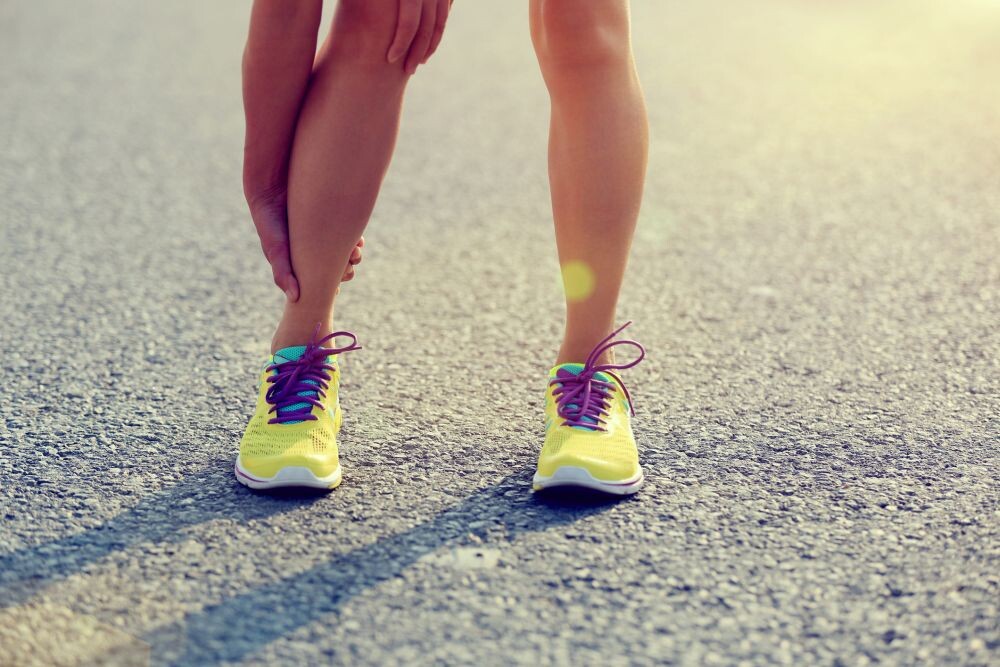
Foam rolling is a great addition to your pre-run routine, and rolling out your calves before a run can increase your range of motion in your ankles without affecting muscle strength. Make sure you check out our tips for how to foam roll properly so you get the most out of your pre-run routine.
Do explosive work at the beginning of your run
Explosive movements are when you’re most likely to injure your gastrocnemius (the larger of the two calf muscles). If you’re prone to calf injuries, plan to do these movements (like hills, sprints or jumps) earlier in your workout, before your muscles are fatigued.
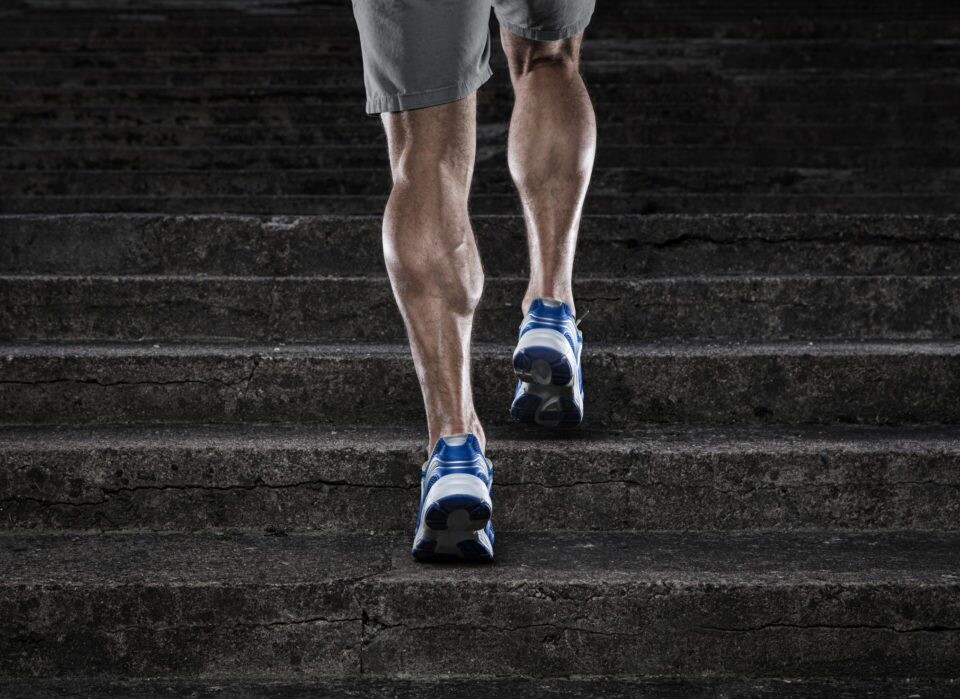
Avoid low-drop shoes
Runners who experience chronic calf injuries should avoid running shoes with a low heel drop, since they put more strain on your lower legs, particularly your calves. Shoes with a heel drop of eight to 10 mm or more are likely a better choice for runners with problematic calves.
Strengthen your calves
This is perhaps the most important piece of advice of all. Your calves take more load for their size than any other muscle in your body when you’re running, so making sure they’re strong enough to withstand the demands of running is crucial for preventing injuries. As a bonus, having strong calves can help you run faster, and for masters athletes, they will help you slow down less as you get older. Try adding these calf exercises into your strength routine to keep your calves strong and durable.
(03/14/2022) ⚡AMPby Running Magazine
Running during the fourth trimester, new research is providing guidance for women who are trying to return to running after pregnancy
Getting back to running is important for many new mothers and postpartum women, but there is often very little guidance for how to do so safely. Most of the information that does exist is focused on the musculoskeletal factors that determine a woman’s readiness to return to running, but there is a lot more to it than that. Recently, a team of researchers came up with some guidelines for women in this situation, recommending a whole-systems approach to returning to running safely.
The fourth trimester
The fourth trimester, of course, isn’t truly a trimester, but describes those first few months after childbirth when a woman’s body is recovering from the effects of pregnancy and the birthing experience. For many women, getting back into a regular running routine is an important way to maintain her physical and mental well-being while adjusting to her new life taking care of a child.
The goal of this paper, published in The Journal of Women’s Health Physical Therapy, was to address “how to evaluate and manage postpartum return-to-running in a systematic order by discussing relevant whole-systems considerations beyond the musculoskeletal system.” The authors also wanted to highlight how different considerations interact with each other and how that will affect each woman differently.
The authors recommend physical therapists who are working with postpartum women should consider the following factors when evaluating an individual’s readiness to return to running:

physical deconditioning
changes to body mass
sleeping patterns
breastfeeding
relative energy deficiency in sport
postpartum fatigue and thyroid autoimmunity
fear of movement
psychological well-being
socioeconomic considerations
Each of these factors, the authors suggest, should be considered alongside a musculoskeletal evaluation and a graded exercise progression.
Postpartum running: an infographic
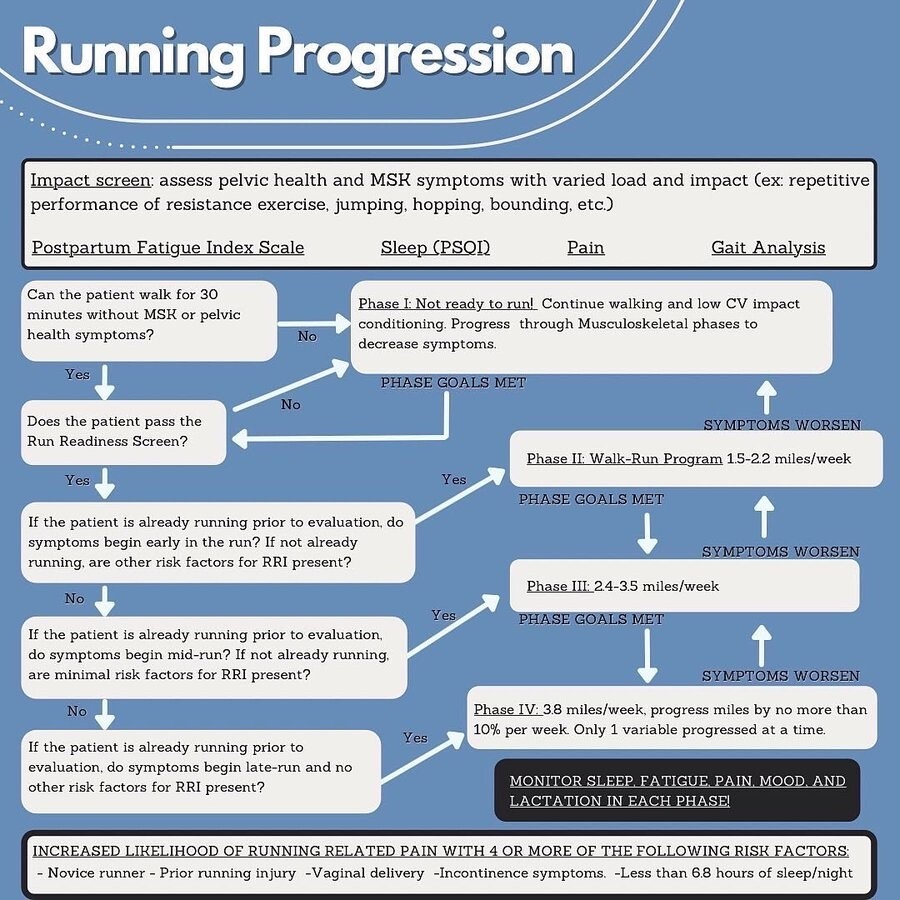
The authors created this handy infographic to summarize their guidelines for assessing a woman’s readiness to return to running. While it is meant to help physiotherapists and other healthcare professionals guide their patients, runners can use it to an extent to guide themselves. (Note MSK stands for musculoskeletal).
Returning to running safely
The information in this paper highlights that generalized guidelines are ineffective when helping a woman return to running postpartum. Every single woman is different, and pregnancy and childbirth will affect each woman in different ways and to varying intensities.
If you’re trying to return to running after pregnancy, the best thing you can do is to see a physiotherapist or other health professional who can assess your readiness to start running again and evaluate your progress as time goes on to reduce your risk for injuries or other complications.
Finally, it’s important to listen to your body and not rush yourself back to a regular running routine. It will take time for your body to bounce back, especially when those first few months can be a shock to your system. Remember to go easy on yourself. Running, especially during this busy and exciting time in your life, should reduce your stress, not add to it.
(03/14/2022) ⚡AMPby Brittany Hambleton
Try extended hills to prepare for race day, this unique hill workout will help you practice running through a challenging hill to better prepare you for race day
Hill repeats are a great way to build strength and power to help you tackle a hilly race course or to have more power on the flats. The problem with most hill workouts, however, is that you stop running when you reach the top of the hill. This extended hill workout will help you practice cresting the top of a hill and finding your pace again the way your would in a race situation.
Extended hills for race-day simulation
To perform this workout, you need a moderate hill that takes you about one minute to run up, but that has space for you to continue running for another 30 seconds to one minute once you’ve reached the top. The idea is to control your effort as you work up the hill, then to maintain that effort once you reach the top, so that you speed up as your legs and lungs readjust to the flat ground.

Your cooldown for each interval is simply an easy jog back to your starting point. Each interval should be run at a hard enough intensity that you feel fatigued by the time you reach the top of the hill, but you’re able to pick up the pace on the flat and recover fully by the time you reach the bottom.
The workout

Warm-up: 15-20 minute easy jog (ideally with a few small, gentle hills to get your legs prepared for the workout)
Workout: 6-10 x hill + flat (beginners can start with 6 and work their way up as they gain fitness)
Cooldown: 10-15 minutes easy jog, followed by light stretching
(03/14/2022) ⚡AMPby Brittany Hambleton
Two-time New York City Marathon champion Geoffrey Kamworor will be making his debut on the streets of Boston on April 18
Three-time World Half marathon champion Geoffrey Kamworor has set his focus on next month's Boston marathon after shaking off a groin injury that ruled him out of last month's Agnes Tirop Memorial World Cross Country Tour.
The two-time New York City Marathon champion will be making his debut on the streets of Boston on April 18 seeking to add to his burgeoning accolades on American soil.

“I was well prepared for the Agnes Tirop World Cross Country Tour but it was very unfortunate that two weeks to the event, I got a groin injury and I had to pull out,” said the 2015 world championships 10,000m silver medalist.
Kamworor said he is targeting a podium finish on debut.

“I feel in great shape, just trying to sharpen my skills a little bit. My training has been flawless and I am hoping for a good result in Boston,” he added.
The four-time world cross country champion (two in senior and two in junior) will be joining a host of top athletes in Boston including compatriots Benson Kipruto (defending champion), Geoffrey Kirui (2017 champion) Evans Chebet, Titus Ekiru, Lawrence Cherono (2019 winner), Bernard Koech, Eric Kiptanui, Bethwell Yegon and Albert Korir (New York City Marathon champion).
Rivals Ethiopia are also represented by a huge, talented contingent led by three-time Olympic champion and the second-fastest marathon runner in history with a best of 2:01:41 Kenenisa Bekele, Lemi Berhanu (2016 winner), Lelisa Desisa (2015 and 2013 winner), Bayelign Teshager and Jemal Yimer.
Italian Eyob Faniel of Italy, Japan's Yuki Kawauchi (2018 winner), Amanuel Mesel, Tsegay Tuemay Weldibanos (Eritrea), Scott Fauble, Colin Bennie, Jared Ward, Ian Butler, Mick Iacofano, Jake Riley, Jerrell Mock, Matt McDonald, Matt Llano, Elkanah Kibet, CJ Albertson, Diego Estrada (USA), Trevor Hofbauer (Canada), Juan Luis Barrios (Mexico) and Gabriel Geay of Tanzania are also in the mix.
(03/14/2022) ⚡AMPby Emmanuel Sabuni
Ruth Chepngetich won $250,000 when she won the 2022 Nagoya Women’s Marathon
Kenya's Ruth Chepngetich won the Nagoya Women's Marathon in a new race-record time on Sunday, finishing ahead of Israel's Lonah Chemtai Salpeter and Japan's Yuka Ando in second and third, respectively.
The winner of the 2022 race received $250,000, currently the highest first-place prize money for a marathon in the world, according to organizers. In addition to elite competitors, it also admitted general-entry runners residing in Japan.

Chepngetich, the 2019 world marathon champion and 2021 Chicago Marathon winner, crossed the line at Vantelin Dome Nagoya in 2 hours, 17 minutes, 18 seconds, more than a minute ahead of Salpeter, winner of the 2020 Tokyo Marathon. Ando clocked 2:22:22.
Ando, who competed in the 10,000 meters event at the Tokyo Olympics last summer, met the qualifying time of sub-2:23:18 to be granted entry into the world athletics championships to be held in Oregon in July.
The race became a two-woman battle between Chepngetich and Salpeter after the 30-kilometer mark, but Chepngetich made a decisive uphill surge with around 8 km remaining, running strongly all the way to the finish line.
(03/13/2022) ⚡AMPNagoya Women's Marathon
The Nagoya Women's Marathon named Nagoya International Women's Marathon until the 2010 race, is an annual marathon race for female runners over the classic distance of 42 km and 195 metres, held in Nagoya, Japan in early March every year. It holds IAAF Gold Label road race status. It began in 1980 as an annual 20-kilometre road race held in...
more...A Wake-Up Call from His Doctor and Mom Got This Runner Active Again—and He Lost 153 Pounds
The pandemic derailed his diet and activity. But then he fell in love with running again.
Name: Robert Valencia Age: 38 Hometown: Miami, Florida Occupation: Journalist and public affairs specialist Start Weight: 330 pounds End Weight: 177.2 pounds Time Running: I started running in 2012, but I stopped after that year. I took up my love for running again in August 2021, when I was back to a weight to run again without compromising my knees.

I began to lose interest in getting fit after my last race in 2012. Even though I tried different diets (paleo diet, for the most part), life as a graduate student and working in a stressful environment for much of my 30s took me back to an unhealthy life. I tried going to the gym for a while, but I gained weight again due to a lack of strategic plan to lose and maintain weight loss.
After I received results following a general checkup in March 2021, my primary doctor told me that I was suffering from Stage 1 hypertension, high cholesterol and triglycerides, not to mention that I was already at Stage 3 obesity, weighing 330 pounds. In addition to an already unhealthy diet full of ultra-processed carbs (cereals, white rice and bread, etc.) and sugary treats (ice cream and sweetened yogurt), confinement at the outset of the COVID 19 pandemic made it even worse, especially for us living in New York City.
You can imagine the toll eating all this food at arm’s reach with no physical activity took on my body for a year. After a family visit in Florida in January 2021, my mother implored me to lose weight as she placed her hand over my belly. She asked me to make that pledge. So in March 2021, a month prior to reaching 37, I decided it was important for me to turn the tide health-wise, otherwise my lifespan would shorten and shorten overtime.
My primary care doctor advised me not to run during my weight loss process because I could likely suffer from knee and joint injuries. However, my fiancée encouraged me to run again as I was reaching my goal of keeping my weight below 200 pounds. I watched her participating in races where people clustered around in a sign of camaraderie, fun, and purpose. I wanted to experience how a network of runners from all backgrounds were encouraging each other. So between July and August 2021, I started taking small steps on the treadmill.
I also made diet changes. I maintain a low-carb diet. My fridge has a lot of leafy greens, including red leaf lettuce, arugula, spinach, peeled cucumber, kale, collard greens, and veggies like asparagus, Brussels sprouts, cabbage, radishes and cherry tomatoes. I also have lean protein (fish, lots of chicken and turkey, occasionally lean pork and beef). I drink 2 gallons of water daily, and take omega-3 fish oil and vitamin D. My go-to snacks are nuts, baby carrots, and half a cup of unsweetened, low-fat Greek yogurt with red berries. Cheese is also my favorite, especially cottage cheese. If I want to have a cheat day, sometimes I eat bread or pastries, and maybe one glass of wine.
My first official race after that huge hiatus in 2012 was August 2021, when I ran my first 10k in Prospect Park, Brooklyn. It was exhilarating. After being inactive for so long, being able to complete that race with a steady pace felt like an accomplishment.
I try to run at least four times per week. I try to run in the mornings regardless of the weather. I’m currently using Runcoach, which offers me weekly plans for running and cross-training days. To keep myself motivated, I try to join weekly races across New York with my fiancée and friends. My goal is to run a full marathon by the age of 40, and I hope the New York City Marathon will be the first of many! My goal is to participate in half and full marathons for months and years to come.
From March 1 to September 1, 2021, I officially lost 152.6 pounds, and have maintained this weight loss ever since.
I have done all sorts of exercise, from Crossfit to boxing to spinning to strength classes. However, running awakens my endorphins like no other routine. When I run long-distance races, I listen to my body while at the same time meditating about my life, my journey, and what I want to achieve. Running also gets me in touch with my surroundings, to truly appreciate the New York skyline and to see other runners from all backgrounds reaching their own goals. Running is life.
These three tips have made my running journey successful:
1. Honor your efforts
It’s easier said than done, as life is unpredictable. But if you have reached your goal, honor it by staying committed to keeping it. You’ve made it this far and that’s an accomplishment you want to cherish forever!
2. Surround yourself by a support network
Your journey will have a ripple effect. A physical change also requires a mental one, and being motivated requires the support of caring friends and family.
3. Be compassionate towards yourself
You fell. Time to dust off and move on. There is no rule that says life will always be rosy. We experience loss, tragedy, shortcomings, or we feel like we’re failing ourselves and others. It is okay to grieve in times of frustration, but this is not the end of it all. Be compassionate towards yourself, first and foremost. Embrace your body, forgive yourself, and know that that every day offers a new opportunity for change. Personal journeys are precisely that, personal. So don’t compare yourself to others when looking for inspiration!
Robert’s Must-Have Gear
→ Theragun Elite: Yes, it is pricey, but it’s worth every penny. We take recovery for granted when training or doing exercise, and this machine right here gives you the relaxation your muscles need. If this is not within your budget, a good foam roller and a yoga mat or even a lacrosse ball can help you release that muscle tension.
→ Saucony Endorphin Speed 2: This shoe, for me, is a godsend. The carbon fiber in the sole helps my posture and my times. It optimizes my strength and speed. This shoe is great for long-distance races.
→ Hoka One One Arahi 5: This shoe is great if you want to train. Having at least two pairs of shoes (one for running, the second for training) is beneficial because it lets your shoes rest! Hoka is a great brand.
(03/13/2022) ⚡AMPDaylight Saving Time Started on Sunday, and It May Negatively Impact Your Health
American Academy of Sleep Medicine indicates that Daylight Saving Time has negative effects on your health and wellbeing.
Sleep experts cite that Daylight Saving Time may increase cardiovascular events, hospital admissions, and mood disturbances research shows.
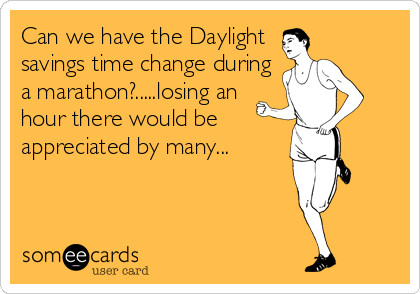
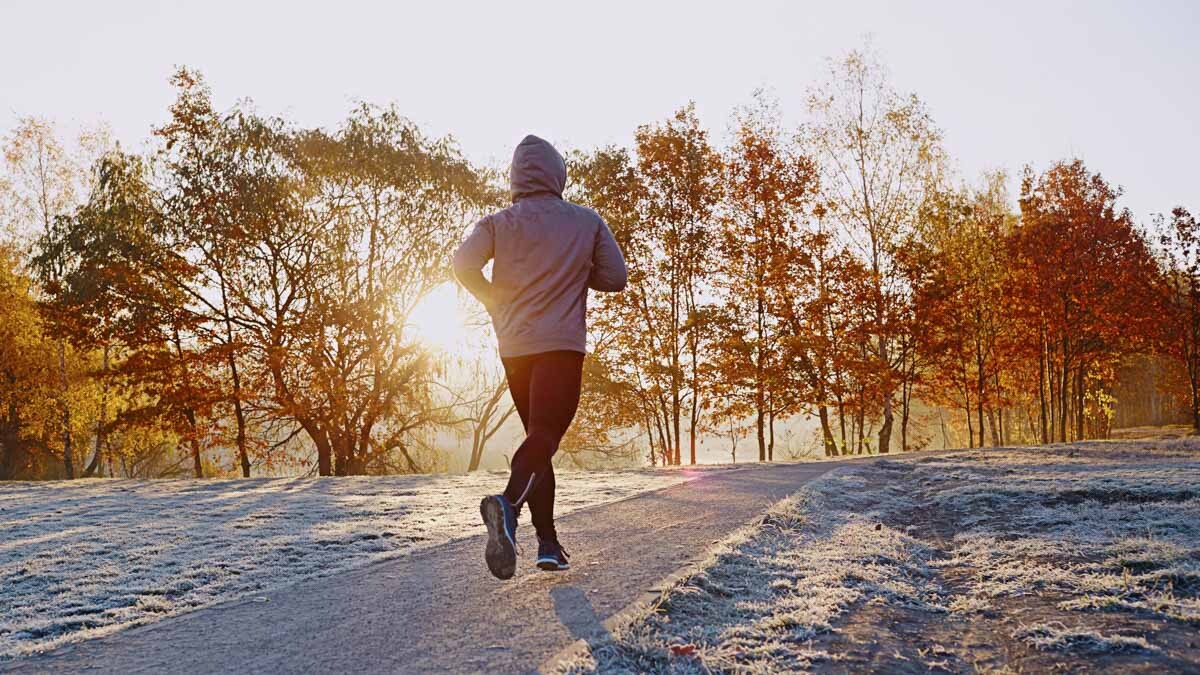
Daylight Saving Time starts on March 13, 2022, at 2 a.m. for most of the country. The clocks move forward one hour.
Depending on who you ask, you’re likely to get a different opinion on Daylight Saving Time (DST). It’s a topic heated enough for ongoing debate in Congress.
Maybe you’re of the camp who loves when the days get longer and lighter. After all, squeezing in that after-work run is easier with an extra hour of light, and the longer daylight may give you a little more motivation to get some things done at the end of the day. Maybe you even notice your mood is better with the added light.
But not all that glitters is gold, not even the late afternoon sun shining brightly.
Unfortunately, if you’re a morning runner, or trying to do anything in the early hours post DST, you may find yourself dragging your heels to get out of bed with the time change—because that morning light is gone along with your extra hour of sleep. Your body may also be paying the price if you lace up at the end of the day. According to the experts at the Cleveland Clinic, endurance athletes (runners and cyclists, that’s you) pay the biggest price when it comes to reduced sleep. Along with feeling extra tired from a lost hour of sleep, sleep experts say that this causes a drop in overall motivation. And you know you need that when deciding whether to turn around or keep going those extra three miles on your training plan.
The position of the clocks is enough of a major concern that The American Academy of Sleep Medicine (AASM) published a statement in the Journal of Clinical Sleep Medicine saying that DST is potentially harmful to your health and wellbeing—and that the U.S. should eliminate seasonal time changes. AASM notes that DST is less aligned with your natural circadian biology, and cites evidence that the body may not adjust to DST for several months.
One of the most significant points the AASM points to is preliminary studies that identify a reduction in the rate of cardiovascular events when the clocks are pushed back to standard time in the fall. This may suggest there are underlying chronic stresses and effects on the body from prolonged DST. In other words, even long after you don’t feel tired from the switch to DST, your body may still be compensating.
So why is pushing the clock ahead one hour so harmful for your health? Here’s what a sleep expert has to say.
Your changing circadian rhythms
Your circadian rhythm is your body’s internal clock, and light is the most important adjuster that you have. Changes in the light take about a week for the body to get into a satisfactory rhythm again, says Steven Zorn, M.D., of the Iowa Sleep Center and board certified in sleep and pulmonary medicine and fellow of the American Academy Sleep Medicine.
Essentially what happens during DST is you end up staying active later-because of the extra daylight—as we’re basically moving the light from the morning to the evening, and may be sacrificing our normal sleep schedule and further quality of sleep, he says. “The most important thing is to have one time and keep it,” Zorn says. Unfortunately for Americans this debate of what time it should be hasn’t yet been solved.
How to adjust to DST
First, Zorn says it will take about a week, or even two, for your body to feel normal.
Zorn cautions the days following DST won’t be the best for optimal performance. During that time period, remember your coordination and concentration isn’t as good and you're likely to be more irritable and forgetful, he adds. So be patient with yourself. (The AASM recommends seven or more hours of sleep each night.)
If you notice you’re feeling super groggy, reduce your running time, but still try to get outside and keep a regular schedule. “When you have a regular sleep schedule your body knows when it’s supposed to turn off and turn on, and your sleep efficiency is much better. You just feel better,” Zorn says.
So even though those longer spring evenings are on the horizon, don’t be tempted to burn the midnight oil too long.
(03/13/2022) ⚡AMPby Runner’s World
Why Run on Trails When You Can Collapse in Snowshoes?
Have you ever realized you were in over your head in a race, moments after the starting gun went off?
That's what happened to me last month, in a 10K snowshoe race at the Winter Mountain Games in Vail, Colorado. Feeling semi-fit and eager to compete in my first snowshoe race in a few years, I toed the line with a few dozen or so other enthusiastic competitors in what might be best considered the equivalent of a trail running race over a snow-covered golf course.
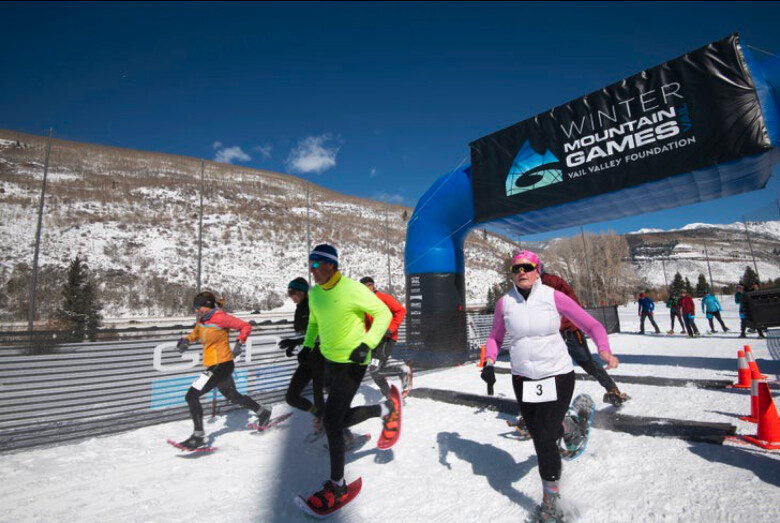
Fifteen seconds after the start, though, the course transitioned from groomed, hard-packed snow to the first of many sections with deep, light, fluffy powder. I watched as other competitors gracefully bounded through the snow in what seemed like a postcard-perfect scene of a bluebird Colorado day.
But amid all the wintry exuberance, it was as if I had been tossed out of a boat and was treading water wearing a heavy pair of hiking boots. As I sunk deeper with every stride, I felt something grab my back leg and was suddenly airborne, momentarily Superman-ing above the pristine layer of snow that the others were methodically dashing through.
And then, Whommppfff! I face-planted into the snow.
To me, snowshoe racing has always been a special kind of Type-2 fun, a unique wintertime activity to whet your appetite for just about any type of endurance racing later in the year. For the uninitiated, it's an easy sport to enjoy. If you can run on trails, you can run on snowshoes.
It's kind of like what cyclocross is for the cycling world. As such, there aren't really any true snowshoe racing specialists, but more a collection of adventurous trail runners, marathoners, triathletes, mountain bikers, and hikers converging in a winter wonderland for some adrenaline-fueled fun.
Sure, there are some great snowshoe racers who excel at dashing through the snow. In fact, Josiah Middaugh, Alex Willis, Seth Wealing, and Meredith Cook were among the local Colorado athletes who were off the front in this race as I was torpedoing into the snow. Middaugh, Nichols, and Wealing are all great trail runners, but have primarily made their mark as Xterra off-road triathletes, while Cook is also an accomplished trail runner.
Middaugh is a six-time U.S. snowshoe champion, and Willis is competing in the 2022 World Snowshoe Championships on Sept. 3 in Argentina. There will be a lot of good trail runners competing in the 2022 U.S. Snowshoe Championships on March 13 in Cable, Wisconsin. And that event made it clear that anyone can enter and everyone is welcome: "There are no Qualifiers or Membership Requirements to compete."
Two years ago, trail runners Michelle Hummel and Joe Gray won the U.S. Snowshoe Championships and then went to Japan, where Hummel won the women's World Snowshoe Championship and Gray was fourth among men. (Gray was the world champion in 2017 and the runner-up in 2018 and 2019.)
Generally speaking, though, most people who show up for a snowshoe race are training for something else. Or, like me, they just want to endure the torturous fun of something new.
I've raced on snowshoes about 30 times, from as short as 1 mile to as long as 20K. I've never been particularly good, but that hasn't stopped me from coming back. When you're fit, it's a fun way to get a winter workout without any stress tied to your summer goal races.
For this race, though, I wasn't that fit, so after my inadvertent crash near the start, I got back on my feet and realized I'd be in for a long, slow jog with amazing mountain vistas.
Most of the athletes were wearing running shoes strapped to lightweight, aluminum 825-inch snowshoes from Atlas, TSL, Redfeather, or OT Racing. I would have been, too, but one of my bindings broke while I was warming up and the makeshift repairs I made with duct tape and zip ties didn't hold, so I had to rent a heavier pair from the Vail Nordic Center.
As the race progressed, Middaugh and Willis pushed the pace, but it was Middaugh's 17-year-old son, Sullivan, who stole the show and won the race in 46:41 - an impressive 7:31 per mile pace. Cook, meanwhile, was the top woman in 1:08:19.
"It's pretty exciting for me to see him pass me in a race and really go for it, and really lay it on the line," the elder Middaugh said. "It's really demoralizing when someone else makes a strong move on me like that, but when it's my own kid, it makes me feel good and bad at the same time. I'll just have to find his weakness the next time we race."
As for me, I definitely found my weakness. I tried to keep pace with Danielle McNair, but she was stronger and more determined than I was, and left me in the snowy dust en route to finishing second among women. She seemed happy and chipper as she passed me, so I did my best to keep a smile on my face and enjoy the views as I slogged to the finish.
"Although it can be an intimidating sport and quite challenging," McNair told me after the race, "I just remind myself that I was brave enough to show up today, and isn't that what most of racing and events are about? I'm never going to be a fasty, but I can show up and challenge myself and rack up smile points."
(03/13/2022) ⚡AMPby Trail Runner Magazine
Study: do minimalist shoes cause injuries?, New research says minimalist shoes may increase your risk for foot injuries, but not everyone agrees
Before the super shoe debate took over our collective conversation, there was the minimalist vs. conventional shoe debate. While that argument has cooled off in recent years, there are still those who swear by their barely-there footwear and those who are adamantly against it, citing an increased risk for injuries.
Recently, researchers took another look at the argument to determine exactly how minimalist shoes affect runners, and the results are (as you may have guessed) still up for debate.

The study
The study, published in the journal Applied Sciences, recruited 21 experienced minimalist shoe runners to run for 30 minutes at 80 per cent of their max aerobic speed in either minimalist or conventional footwear. This is different from many other studies, which tend to focus on just one step on a force plate.

As they ran, the researchers measured participants’ mean pressure, peak pressure, contact time, centre of pressure velocity, relative force and contact area.
The results indicated that when running in minimalist shoes, the athletes had shorter contact times but higher peak forces on their feet. These results were the most significant for the runners who landed on their forefeet, compared to those who had a midfoot or rearfoot-striking pattern.
The researchers concluded that considering this data, wearing minimalist shoes increases your risk for foot injuries. Since the research was published, however, others in the industry have weighed in, and are less convinced. One of these commentators is Canadian Max Paquette, associate professor in sport science & biomechanics at the University of Michigan. In his opinion, these differences between minimalist and conventional shoes likely won’t amount to an increased injury risk.
So should you wear minimalist shoes? The choice is up to you. Injuries, as we know, are often caused by a multitude of factors, with your footwear only one potential contributor. If you are considering making the switch, make sure you ease yourself into them gradually by alternating them with another less-minimal pair to avoid injuries, and pay attention to your body. Everyone is different, and a shoe that works for your running may not be what works for you.
(03/12/2022) ⚡AMPby Brittany Hambleton
The most common running injuries that you need to be aware of
Many people across the globe enjoy running, whether it’s jogging, athletics, or other sports. Some do it for weight loss and others because they enjoy being competitive. Whilst it’s a great way to stay in shape, it can also be dangerous if you’re not aware of the potential injuries. In this article, we’ll discuss some of the most common running injuries and how to prevent them.
Pulled Muscles Or Ligaments
Pulled muscles or ligaments can be caused by a sudden movement or overuse of the muscle, and they can bring considerable pain and discomfort. If you’re experiencing any sort of pain when running, it’s best to stop and seek medical attention. Continuing to run with an injury can lead to further damage and make the healing process much longer.

To help prevent pulled muscles or ligaments, be sure to warm up properly before beginning your run. This will help loosen up the muscles and prepare them for activity. Additionally, be sure to stretch after your run as well. This will help keep the muscles limber and reduce your risk of injury. If you do experience a pulled muscle or ligament, be sure to take some time off from running and allow yourself to heal. This may mean missing out on a few races, but it’s important to make sure you are taking care of your body so that you can continue running long term.
Runner’s Knee

This is a condition that can be caused by overuse or injury, and it can cause pain, swelling, and stiffness in the knee. Treatment includes rest, ice, compression, and elevation (RICE). Physical therapy may also be recommended to help strengthen the muscles around the knee. Surgery may be appropriate if other treatments prove ineffective. Prevention of runner’s knee includes warming up before running, stretching regularly, and avoiding excessive mileage. If you are experiencing symptoms of a runner’s knee, stop running and see your doctor.
If you need to visit an injury treatment center and it was someone else’s fault, it’s possible to access a team of highly trained medical professionals who know how to treat accident injury victims. Having a complete examination, proper diagnosis, and detailed documentation can be the difference between receiving or not receiving a financial settlement potentially worth millions.
Shin Splints And Achilles Tendinitis
Shin splints are a common running injury, especially among beginners. They occur when the muscles and tendons around your shin bone become overworked and inflamed. Shin splints can be painful and make it difficult to continue running. If you think you may have them, rest is the best course of treatment. Ice and pain relievers can also help reduce inflammation and pain. If the shin splints are severe or don’t improve with rest, see a doctor for further treatment options.
Achilles tendinitis is another common running injury. It occurs when the Achilles tendon (which connects your calf muscles to your heel bone) becomes inflamed. Achilles tendinitis can be quite painful and make it difficult to walk or run. Treatment includes rest, ice, and pain relievers. In severe cases, surgery may be necessary, so always see a doctor early on.
Plantar Fasciitis And Iliotibial Band Syndrome
Plantar Fasciitis is an especially common running injury among new runners. It occurs when the Plantar Fascia becomes inflamed. Plantar Fasciitis can be extremely painful and make it difficult to walk or even stand. If you suspect you have it, see a doctor quickly for diagnosis and treatment.
Iliotibial Band Syndrome (ITBS) is a common injury for runners that’s caused by the iliotibial band becoming irritated and inflamed. Symptoms of ITBS include pain on the outside of the knee, swelling, and stiffness. The best way to treat ITBS is to rest, ice the affected area, and stretch the iliotibial band.
Hip Flexor Strain
This is caused by the overuse of the muscles and tendons that support the hip joint. It’s often seen in runners and other athletes who participate in activities requiring repetitive motion of the legs. Some of the most common symptoms include:
Pain in the front of the hip
Difficulty walking or running
Stiffness in the hip
Muscle spasms
If you’re experiencing any of these symptoms, it’s important to see a doctor or physical therapist so that you can begin treatment. Hip flexor strain is treatable, but if it’s ignored it could lead to more serious injuries such as tendonitis or bursitis. Treatment for hip flexor strain includes RICE to help reduce the pain and inflammation. Physical therapy can help to stretch and strengthen the muscles and tendons around the hip joint, so they are better able to support it.
Hip Bursitis
Bursitis is a condition that results from inflammation of the bursa (which is a small, fluid-filled sac located between the skin and underlying muscles or tendons). Hip bursitis may be caused by overuse, age-related changes, or injury.
Symptoms include pain and tenderness in the hip area, difficulty walking, swelling, and redness. Treatment typically includes rest, ice therapy, medication to reduce inflammation, and physical therapy.
Pulled Hamstring And Hamstring Strain
A pulled hamstring is when one or more of the hamstring muscles are stretched or torn. A hamstring strain is a specific type of pulled hamstring, and it happens when one or more of the fibers in a muscle are overstretched or torn. Both conditions can cause pain and difficulty walking and running. If you think you have either condition, see your doctor as soon as possible for an evaluation. Treatment may include RICE, physical therapy, and/or surgery.
In terms of prevention, always:
warm-up before running
stretch your hamstrings regularly
cross-train so that you’re not putting all of the stress on your legs from running
We’ve now covered major ground in terms of common running injuries. We’ve discussed their symptoms, treatment, and prevention. Always build up your sporting activities slowly, and consult with a doctor and personal trainer before you begin. Then you can enjoy running both now and for many years to come.
(03/12/2022) ⚡AMPby Colorado Runner
Chepngetich runs 2:17:18 to win Nagoya Women's Marathon
Kenya’s Ruth Chepngetich rallied to record the second-fastest ever women-only marathon at the Nagoya Women’s Marathon on Sunday (13), clocking 2:17:18 to win the World Athletics Elite Platinum Label road race.
The world marathon champion ran a negative split – covering the first half in 1:09:03 and the second in 1:08:15 – to triumph ahead of Israel’s Lonah Chemtai Salpeter and claim the largest first-place prize money in the world of marathon running: US$250,000.

Chepngetich had been targeting her own PB of 2:17:08, run in a mixed race in Dubai in 2019, and achieving that would have taken her very close to her compatriot Mary Keitany’s women-only marathon world record of 2:17:01 set in London in 2017. When she ran solo through half way in 1:09:03 and passed 30km in 1:38:14, it looked like that target might be out of reach. Salpeter had also caught her by that point, but that only spurred Chepngetich on.
Digging deep, Chepngetich recorded 16:03 for the next 5km to re-establish her dominance and another 5km split of 16:05 put her well clear of her rivals by 40km, which she passed in 2:10:22. Glancing over her shoulder, she could see no threat but continued to push hard to the finish line, crossing it just 10 seconds outside her PB, in 2:17:18, to win by almost a minute and a half. As well as being the second-quickest women-only marathon in history behind Keitany’s record, it is also the second-fastest ever women's marathon on Japanese soil.
The 2020 Tokyo Marathon winner Salpeter secured second place in 2:18:45, exactly a minute off her national record run in Japan’s capital city, to record – like Chepngetich – the second-fastest marathon time of her career. Japan’s Yuka Ando was third in 2:22:22 and her compatriots Ai Hosoda and Yuka Suzuki were next to finish, running 2:24:26 and a debut 2:25:02 respectively to finish fourth and fifth.
"Fantastic!" Chepngetich later wrote on social media. "Winner at Nagoya Marathon with a new course record 2:17:18, close to my PB and second ever for a only-women race. Thanks to everyone who helped to make it!"
Running with the pacemakers, Chepngetich had formed part of the lead group that passed 5km in 16:34, joined by Ando, Salpeter and Hosoda. Keen to pick things up, Chepngetich moved ahead a short while later and was running alone through 10km, which she passed in 32:43, 25 seconds ahead of the chase trio. She had increased that advantage to 45 seconds by 15km.
Salpeter and Ando had left Hosoda behind by the half way point, which they passed in 1:09:47, but then Salpeter kicked. Running 15:59 for the 5km split between 20km and 25km, Salpeter closed the gap and was just four seconds behind leader Chepngetich at 30km - 1:38:14 to 1:38:18.
Chepngetich wasn’t done, though, and pushed up the incline to move away from her rival. Running 16:03 between 30km and 35km, the Kenyan had regained a nine second advantage by 35km and only continued to pull away. She was 55 seconds ahead at 40km and increased that to 1:27 by the finish.
Salpeter also ran a negative split of 1:08:58 compared to her first half of 1:09:47 to finish inside the previous event record. The top eight – completed by Australia’s Eloise Wellings (2:25:10 PB), Japan’s Ikumi Fukura (2:25:15) and Kotona Ota (2:25:56) – all broke 2:26:00, while a total of 15 athletes went sub-2:30:00.
(03/12/2022) ⚡AMPBoston Bomber death sentence reinstated
In a 6-3 vote on Friday, the U.S. Supreme Court decided to reinstate the death penalty for Dzhokhar Tsarnaev, who, along with his older brother Tamerlan Tsarnaev, detonated a bomb at the finish line of the 2013 Boston Marathon, killing three people and injuring hundreds.
According to NPR, Massachusetts had abolished the death penalty, but Tsarnaev was convicted in 2015 on 30 terrorism charges and sentenced to death on six of them. He appealed his death sentences, arguing that the judge refused to allow him to present evidence showing that he, who was 19 at the time, was under the influence of his violent brother, who was seven years older. (Tamerlan was killed in a shoot-out with police in the days following the bombing).


The evidence in question was Tamerlan’s connection to the murder of three men two years before the bombing. He, along with an accomplice, was suspected of killing the men in an act of jihad on the anniversary of 9/11, but was never convicted because of insufficient evidence.
Tsarnaev argued that because the judge did not allow him to use that information in his defense, the jury’s decision was tainted. His death sentence was overturned in 2020, but the Supreme Court said they would likely hear his trial again in 2021.
His death sentence has now been reinstated, but Tsarnaev will not be executed any time soon. There is currently a moratorium on federal executions in the United States, so the Justice Department can conduct a thorough review of its policies and procedures.
This April will be the ninth anniversary of the Boston Marathon Bombings.
(03/12/2022) ⚡AMPby Running Magazine
How to get the stink out of your running clothes
Running clothes stink. After just a few runs, technical fabrics, like Lycra, Coolmax or Dri-fit, start to hold onto odours, even after they’ve gone through the “heavily soiled” cycle in your washing machine. If the scent of your running gear is starting to become overwhelming, fear not: these six tips will have your favourite racing kit smelling like daisies in no time (or at least they won’t be completely repulsive).
Air them out


When you come in from a run and your clothes are sweaty, don’t immediately throw them into the laundry hamper. Hang them up to air them out first, bonus points if you can hang them outside in the fresh air. Not only will this help reduce the stink, but it’ll help your running clothes last longer, too.
Don’t over-do detergent
A common mistake runners make is thinking that if they put extra detergent in, their clothes will get extra clean. While this sounds logical, it doesn’t actually work and could make things worse. Your laundry machine is likely set up to handle a certain amount of detergent, and if you put too much in, the machine won’t be able to wash it all out. This will leave residue on the fabric, which over time leads to a buildup of mold and mildew and eventually, bacteria.
To be on the safe side, start with three-quarters, or even half, of the amount of detergent you would normally use and adjust as you see fit. You can also try using a detergent that’s designed specifically for sports clothing.
Say no to fabric softener
Fabric softener is great for your sheets and towels, but terrible for your running gear. It can lock smells in and prevent detergent from getting into all of the nooks and crannies of the fabric. Fabric softener also breaks down stretchy materials, so it can ruin the shape and fit of your running gear.
Add vinegar
Pre-soaking your clothes in a 4:1 mixture of water to distilled vinegar for 30 minutes before washing can do wonders for removing stubborn smells. Vinegar helps release bacteria from the fabric so they can be washed away in the laundry.
Turn them inside-out
The smelliest and dirtiest parts of your running clothes are on the inside, so turn your gear inside out (especially your tights) to give detergent direct access to those parts.
Hang them to dry
Never — we repeat, never — put your running clothes in the dryer. This has less to do with smell and more to do with taking good care of your gear so that it lasts a long time. High heat can damage or shrink your clothes, which shortens their useable life. Hang them out to dry, if not outside, then on a rack somewhere in your home.
(03/12/2022) ⚡AMPby Running Magazine
Kilian Jornet partners with Coros wearables
The world-class GPS watch company Coros has partnered with two new athletes to expand their trail and mountain running audience. World sky-running champions Kilian Jornet and Emelie Forsberg are the newest pro-athletes to represent the company.
The strategy behind the partnership is Coros’ commitment to helping athletes train and perform at the highest levels. Coros continues to cement itself as the leader in athletic performance-focused wearables, as Jornet and Forsberg join a growing roster of truly world-class athletes that include marathon world record holder Eliud Kipchoge and Olympic bronze medallist Molly Seidel.

Jornet has significant goals for 2022, as the three-time UTMB champion to returns Chamonix, France, for another crack at glory. Jornet, who recently left his sponsor Salomon, will also be competing at Hardrock, where he is a four-time champion, and Sierra-Zinal, which he has won nine times (including the last five editions).
Forsberg, who is Jornet’s partner, has the women’s FKT up and down from Mont Blanc in 7:53:12. Forsberg was the world sky-running champion in 2014 and is making a comeback to the sport after the birth of her second daughter in April 2021.
Drawn by its light weight, size and the inclusion of mountain-compatible features, both Jornet and Forsberg will wear the Coros Apex Pro as their primary GPS watch. The Coros Apex Pro features Ski Touring mode with auto ascent/descent detection, SpO2 (pulse oximeter) sensor with specially designed altitude mode, trail running mode and more…
(03/12/2022) ⚡AMPby Running Magazine
Five steps to clean your running shoes, keep your favorite pair in good condition by washing them after a muddy spring run
Getting out on a muddy trail in the spring can be a lot of fun, but it wreaks havoc on your shoes. It’s important to take care of your favourite pair if you want them to last, so cleaning them properly after a messy run is a crucial part of your shoe-care routine. Here we give you five easy steps to cleaning your running shoes to make sure they go the distance.
Step 1: remove laces and insoles
Remove the shoelaces and insoles and place them in a mesh laundry bag or pillowcase. These can be tossed in your laundry machine on the gentle cycle, then air-dried later (insoles should never be put in the dryer).

Step 2: get rid of dirt, grass, and caked-on mud
Once your shoes have dried, wipe away the dirt, grass and caked-on mud. Ideally, you should use a brush with stiff bristles on the outsoles, but something with soft bristles (like a toothbrush) on the uppers. If you have some particularly stubborn dirt caked into the nooks and crannies of your outsoles, you can use a hose to rinse and scrub until the bottoms of your shoes are clean.

Step 3: add soap and water
To clean the uppers, mix some mild detergent (preferably one that’s meant for technical fabrics) with water and gently scrub them with a toothbrush to remove the dirt and grime.
Step 4: Rinse with warm water
Once that’s done, rinse your shoes thoroughly with warm water, using a washcloth to gently remove soap, suds and any remaining dirt.
Step 5: air dry
Once you’ve removed all of the dirt and soap residue, allow your shoes to air dry at room temperature. Don’t place them outside in the sun to dry faster, because the heat can distort their shape, and never put them in the dryer, which will damage them. Ideally, you should leave them in a place with a mild temperature and low humidity, and if you want them to dry faster, you can use a fan or stuff them with paper towels, replacing the towels whenever they become damp.
Following these steps and keeping your shoes clean will help them last longer, so you can get more miles out of them before they need to be replaced.
(03/11/2022) ⚡AMPby Brittany Hambleton
How should you feel at the end of a long run? If you are extorting all your energy into your long runs, you are doing it wrong
It’s easy to overdo every aspect of training by going too hard on a rest day or too fast on the first rep of your speed workout. The long run is a craft that shouldn’t be overdone, as it has a sweet spot in your training to improve aerobic endurance over a certain time or distance. If you are extorting all your energy into your long runs, you are doing it wrong.
Long runs are a crucial piece of the training block in your preparation for your goal race. They prepare your body to handle the physical demands of a race, building confidence and soothing your mind over that distance. Long runs are a fantastic way to measure your growth, as they remind us of the work that needs to be done before race day.

Depending on your training load, there are a few different ways to do your long run–you can treat it as a slow progression run, run long and slow, or run slowly with a fast finish. All these long-run approaches have different benefits depending on your purpose, but each should moderately have your body feeling the same way at the end.
The goal of your long run should be to cover the distance comfortably, hitting the training distances and getting to the start line or your training week healthy. Therefore, it’s important to feel comfortable yet fatigued at the end of a long run. The distance will be prolonged work, but that’s why it’s important to hit a slower pace through the first eight to 10K, which will accomplish more than going at a faster pace.

In the second edition of Jack Daniels Running Formula, he states, “The feeling you want to achieve on every long run is how you’d expect you’d feel in the latter stages of a half or full marathon.”
Long runs are meant to teach your body to physiologically prepare for the stresses it will experience on race day. Besides receiving a bib and chip time, there are very few things you do on race day that you have not yet practiced on a long run along the way.
(03/11/2022) ⚡AMPby Marley Dickinson
Is a pre-workout supplement useful for long distance runners?
Pre-workout supplements are often used by people who work out regularly to boost their energy and performance.
The multi-ingredient supplements are taken prior to engaging in physical activity.
Pre-workouts are available in various forms, but they most commonly come as powders that you mix into water and then drink.
These supplements can be beneficial for all kinds of fitness activities, such as cardio routines, strength training, and sports. Pre-workouts can also be useful for long-distance runners.

Why are pre-workouts helpful for long-distance runners?
Stamina and strength are crucial to successful long-distance running.

Pre-workouts use ingredients like caffeine to boost muscle strength and reduce fatigue. In turn, that means you can push yourself further and literally go the extra mile.
While pre-workout supplements can be excellent for taking before a race or running session, they can also be used by long-distance runners when they undergo other workouts, like high-intensity interval training sessions.
So, whether you just run for fun or are a professional long-distance runner, taking the right pre-workout supplement can make all the difference to your performance.
Other key benefits of pre-workouts for long-distance runners include:
An increased focus.
A reduced perception of effort and pain.
An enhanced ability to burn fat during running.
When you make great workout supplements a part of your pre-running ritual, you can gain long-lasting energy and razor-sharp alertness. In turn, that means the intense effort needed to finish the last mile could become a thing of the past.
Should you take pre-workouts before every run?
While the advantages of pre-workouts should now be clear, it is not actually best to take them before every single run you do.
Your body can become intolerant to any substance that you regularly ingest, so pre-workout supplements are no different. If you use them before every run, they can become less effective over time.
Therefore, you should take short breaks between using pre-workouts to get the most out of them.
How long does it take for pre-workouts to kick in?
When you take a pre-workout supplement prior to running, you will usually start feeling the benefits after around thirty or forty-five minutes.
Typically, the benefits of pre-workouts last between three and six hours; making them ideal for long-distance running.
What ingredients should you look for in pre-workouts?
Each pre-workout supplement contains different ingredients. Therefore, you may find one pre-workout product works better than another. The key is to find the right one for you.
Some of the most common ingredients found in pre-workout supplements include caffeine, creatine, amino acids, and beta-alanine. The quantities of the ingredients can vary greatly from one product to another.
While more research needs to be conducted, studies suggest that the ingredients of pre-workout supplements that have the most effectiveness are:
Caffeine, which can increase your energy and mental alertness. It could help you reduce body fat, too.
Creatine, which plays a key role in both muscular strength and energy production.
Beta-alanine, which could help to prevent acid building up in your muscle tissue, allowing your muscles to work longer and harder while running.
Branched-chain amino acids, which are known to help increase muscle growth and also decrease muscle soreness. That means that your running performance can be boosted and you can recover more quickly after running.
Nitric oxide precursors, which can boost oxygen and nutrients to your muscles.
The Takeaway
Quite simply, the answer to “Is a pre-workout supplement useful for long-distance runners?” is yes.
The right pre-workout supplement can help to boost your performance and your recovery. But you may have to try a few different pre-workouts and ingredient combinations to find the right pre-workout for you.
(03/11/2022) ⚡AMPby Colorado Runner
Ruth Chepngetich and Lonah Chemtai Salpeter ready to clash at Nagoya Women’s Marathon
World marathon champion Ruth Chepngetich and Tokyo Marathon winner Lonah Chemtai Salpeter will renew their rivalry at the Nagoya Women’s Marathon – a World Athletics Elite Platinum Label road race – on Sunday (13).
Athletes in Nagoya will be racing for the largest first prize in the world of marathon running: US$250,000. Being the world’s largest women’s marathon, one of the world’s top-level races, and the only women’s race with a World Athletics Platinum Label, the Nagoya Women’s Marathon continues to be a global leader in women’s running.
To date, Chepngetich has won five of the seven marathons she has completed, and still made it on to the podium in her other two. The consistent Kenyan had her best year in 2019, starting with her 2:17:08 PB in Dubai in January, then following it eight months later by winning the world title in Doha.

Like many athletes, she had a low-key year in 2020 but still finished third at the London Marathon in 2:22:05. Last year she failed to finish the Olympic marathon but rebounded two months later by taking victory in Chicago in 2:22:31.
While the 27-year-old appears to be more focused on victories than records, she is more than capable of producing fast times, too. In April last year she set a world half marathon record of 1:04:02 in Istanbul.

"I chose to run the Nagoya Women’s Marathon because Japan is a nice place and the environment is good," said Chepngetich. "And, as women, we have to encourage ourselves and do better. I'm looking forward to a nice race and I'd like to set a PB."
Chepngetich’s only competitive outing so far this year was at the Kenyan Cross Country Championships in Eldoret in January where she finished sixth – roughly in line with her performances at that event in previous years. She feels far more at ease racing on the roads, though.
So too does Salpeter. The Israeli distance runner won the 2020 Tokyo Marathon in a lifetime best of 2:17:45, having previously set national records when winning in Prague and Florence. Her return to Japan for the Olympics in 2021 didn’t quite go to plan as she finished down in 66th, but she bounced back in October to place fifth in London in 2:18:54.
"I’m happy to be here," said Salpeter. "It's my first time and I hope to do my best on Sunday. My training has been good. I was in Kenya for eight weeks, so I’m ready for Sunday. I’m trusting my training."
This could be the first time Chepngetich and Salpeter have a true clash over the marathon distance. In their two previous encounters over the distance, Salpeter failed to finish at the 2019 World Championships while Chepngetich did likewise at the Tokyo Olympics. Their only other duel to date was at the 2018 World Half Marathon Championships in Valencia, where Salpeter finished just one place ahead of Chepngetich.
Four years on from that, and over double the distance, this weekend’s race could be a different story.
They are among four sub-2:24 athletes entered for the event, as Japan’s Yuka Ando and Reia Iwade lead a strong Japanese contingent.
Ando ran her PB of 2:21:36 when finishing second in Nagoya in 2017 and started this year with a half marathon personal best of 1:08:13 in Yamaguchi, while Iwade ran her best marathon time of 2:23:52 in Nagoya in 2019.
Australia’s Sinead Diver will be making her third Nagoya appearance. She finished 10th in 2017 with a then PB of 2:31:37, then recorded a DNF in 2020. Now with a best of 2:24:11 and a 10th-place finish at last year’s Olympics, the 45-year-old could content for a top-five finish.
Japan’s Rie Kawauchi and marathon debutantes Kaena Takeyama and Yuka Suzuki are also athletes to look out for. Depending on their placing and position, the top Japanese finishers could earn selection for the World Athletics Championships Oregon22 or Japan’s Olympic Trials race for the 2024 Games.
Kenya’s Stellah Barsosio, Japan’s Mao Uesugi and Britain’s Charlotte Purdue will be among the pace-making team.
Last year’s edition of the Nagoya Women’s Marathon was held as a domestic race, and was won by Japan’s Mizuki Matsuda in 2:21:51.
Ten years on since the inaugural edition of the race in 2012, the Nagoya Women's Marathon continues to be the leading women-only marathon in the world. It attracted 21,915 runners in 2018 - a world record for a women-only marathon. After receiving the Japan Olympic Committee Women and Sport Award in 2017, the race was awarded the International Olympic Committee Women and Sport Achievement Diploma in 2019 for playing a significant role in the increase of women runner population in Japan.
The race, which starts at 9:10am local time on Sunday, will be streamed live to 33 countries and regions (Argentina, Australia, Brazil, Brunei, Cambodia, Chile, Colombia, Egypt, Ethiopia, France, Germany, Hong Kong, Indonesia, Italy, Kenya, Macau, Malaysia, Mexico, Monaco, Myanmar, Namibia, Netherlands, New Zealand, Papua New Guinea, Philippines, Singapore, South Africa, South Korea, Spain, Taiwan, Thailand, United Kingdom, and United States of America).
Elite field
Ruth Chepngetich (KEN) 2:17:45
Lonah Chemtai Salpeter (ISR) 2:17:45
Yuka Ando (JPN) 2:21:36
Reia Iwade (JPN) 2:23:52
Sinead Diver (AUS) 2:24:11
Rie Kawauchi (JPN) 2:25:35
Hanae Tanaka (JPN) 2:26:19
Mirai Waku (JPN) 2:26:30
Ayano Ikemitsu (JPN) 2:26:07
Ai Hosoda (JPN) 2:26:34
Chiharu Ikeda (JPN) 2:27:39
Eloise Wellings (AUS) 2:29:19.
(03/11/2022) ⚡AMPby World Athletics
Nagoya Women's Marathon
The Nagoya Women's Marathon named Nagoya International Women's Marathon until the 2010 race, is an annual marathon race for female runners over the classic distance of 42 km and 195 metres, held in Nagoya, Japan in early March every year. It holds IAAF Gold Label road race status. It began in 1980 as an annual 20-kilometre road race held in...
more...





